JVC KENWOOD V1B007 GPS Navigation System User Manual EN KW NT30 50 J indb
JVC KENWOOD Corporation GPS Navigation System EN KW NT30 50 J indb
User Manual
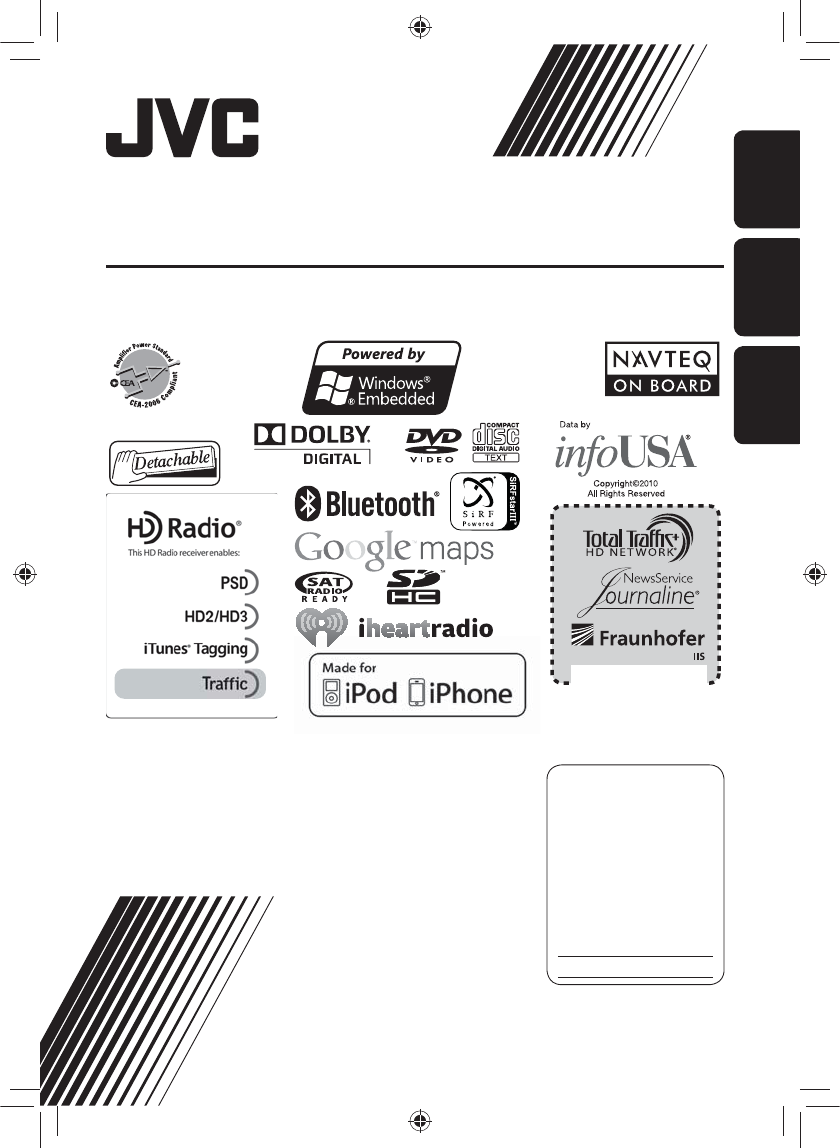
ENGLISHESPAÑOL
FRANÇAIS
ESPAÑOL
For installation and connections, refer to the separate manual.
Para la instalación y las conexiones, refiérase al manual separado.
Pour l’installation et les raccordements, se référer au manuel séparé.
INSTRUCTIONS
MANUAL DE INSTRUCCIONES
MANUEL D’INSTRUCTIONS
For customer Use:
Enter below the Model No.
and Serial No. which are
located on the top or bottom
of the cabinet. Retain this
information for future
reference.
Model No.
Serial No.
LVT2219-001A
[J/C]
KW-NT50HDT / KW-NT30HD
GPS NAVIGATION SYSTEM
SISTEMA DE NAVEGACIÓN GPS
SYSTÈME DE NAVIGATION GPS
HD Radio Traffic is available only for KW-NT50HDT.
HD Radio Traffic se encuentra disponible sólo con el
KW-NT50HDT.
HD Radio Traffic est disponible uniquement pour le
KW-NT50HDT.
Only for KW-NT50HDT
Sólo para KW-NT50HDT
Uniquement pour le
KW-NT50HDT
Cover1_KW-NT30_50[J]_001A.indd 2
Cover1_KW-NT30_50[J]_001A.indd 2
1/27/2011 11:41:01 AM
1/27/2011 11:41:01 AM
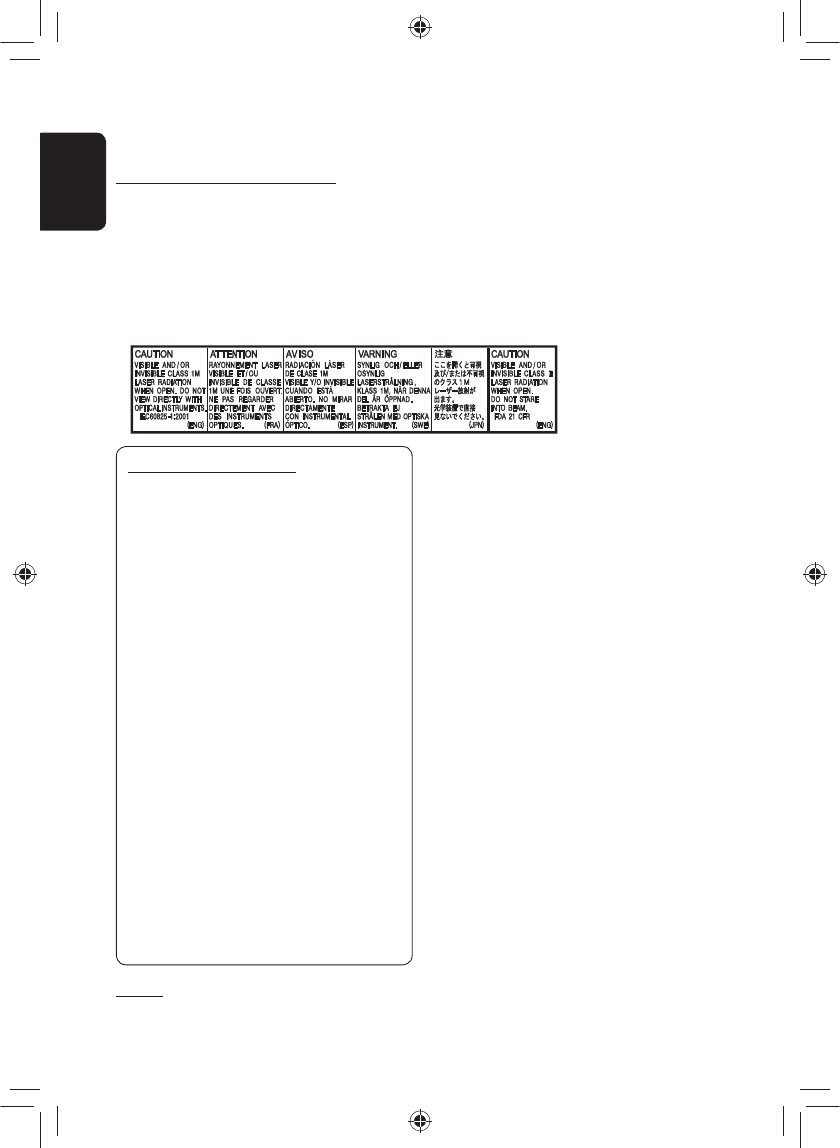
ENGLISH
2
Thank you for purchasing a JVC product.
Please read all instructions carefully before operation, to ensure your complete understanding and to obtain the best
possible performance from the unit.
IMPORTANT FOR LASER PRODUCTS
1. CLASS 1 LASER PRODUCT
2. CAUTION: Do not open the top cover. There are no user serviceable parts inside the unit; leave all servicing to
qualified service personnel.
3. CAUTION: (For U.S.A.) Visible and/or invisible class II laser radiation when open. Do not stare into beam.
(For Canada) Visible and/or invisible class 1M laser radiation when open. Do not view directly with
optical instruments.
4. REPRODUCTION OF LABEL: CAUTION LABEL, PLACED OUTSIDE THE UNIT.
INFORMATION (For U.S.A.)
This equipment has been tested and found to
comply with the limits for a Class B digital device,
pursuant to Part 15 of the FCC Rules. These limits
are designed to provide reasonable protection
against harmful interference in a residential
installation. This equipment generates, uses,
and can radiate radio frequency energy and, if
not installed and used in accordance with the
instructions, may cause harmful interference
to radio communications. However, there is no
guarantee that interference will not occur in a
particular installation. If this equipment does
cause harmful interference to radio or television
reception, which can be determined by turning the
equipment off and on, the user is encouraged to
try to correct the interference by one or more of the
following measures:
– Reorient or relocate the receiving antenna.
– Increase the separation between the equipment
and receiver.
– Connect the equipment into an outlet on a circuit
different from that to which the receiver is
connected.
– Consult the dealer or an experienced radio/TV
technician for help.
Caution
Changes or modifications not approved by JVC could
void the user’s authority to operate the equipment.
(For USA)
CAUTION: This device and its antenna(s) must not be
co-located or operating in conjunction with any other
antenna or transmitter. End user cannot modify this
transmitter device. Any unauthorized modification
made on the device could avoid the user’s authority to
operate this device.
(For Canada) “The installer of this radio equipment
must ensure that the antenna is located or pointed such
that it does not emit RF field in excess of Health Canada
limits for the general population, consult Safety Code
6, obtainable from Health Canada’s website www.
hc-sc.gc.ca/rpb”
The term “IC:” before the radio certification number
only signifies that Industry Canada technical
specifications were met.
This device complies with RSS 210 of Industry Canada “IC”.
“Operation is subject to the following two conditions:
(1) this device may not cause interference, and
(2) this device must accept any interference, including
interference that may cause undesired operation of
the device.”
L’ utilisation de ce dispositif est autorisée seulement
aux conditions suivantes: (1) il ne doit pas produire de
brouillage et (2) l’ utilisateur du dispositif doit étre prêt
à accepter tout brouillage radioélectrique reçu, même
si ce brouillage est susceptible de compromettre le
fonctionnement du dispositif.
EN_KW-NT30_50[J].indb 2
EN_KW-NT30_50[J].indb 2
1/31/2011 3:24:00 PM
1/31/2011 3:24:00 PM
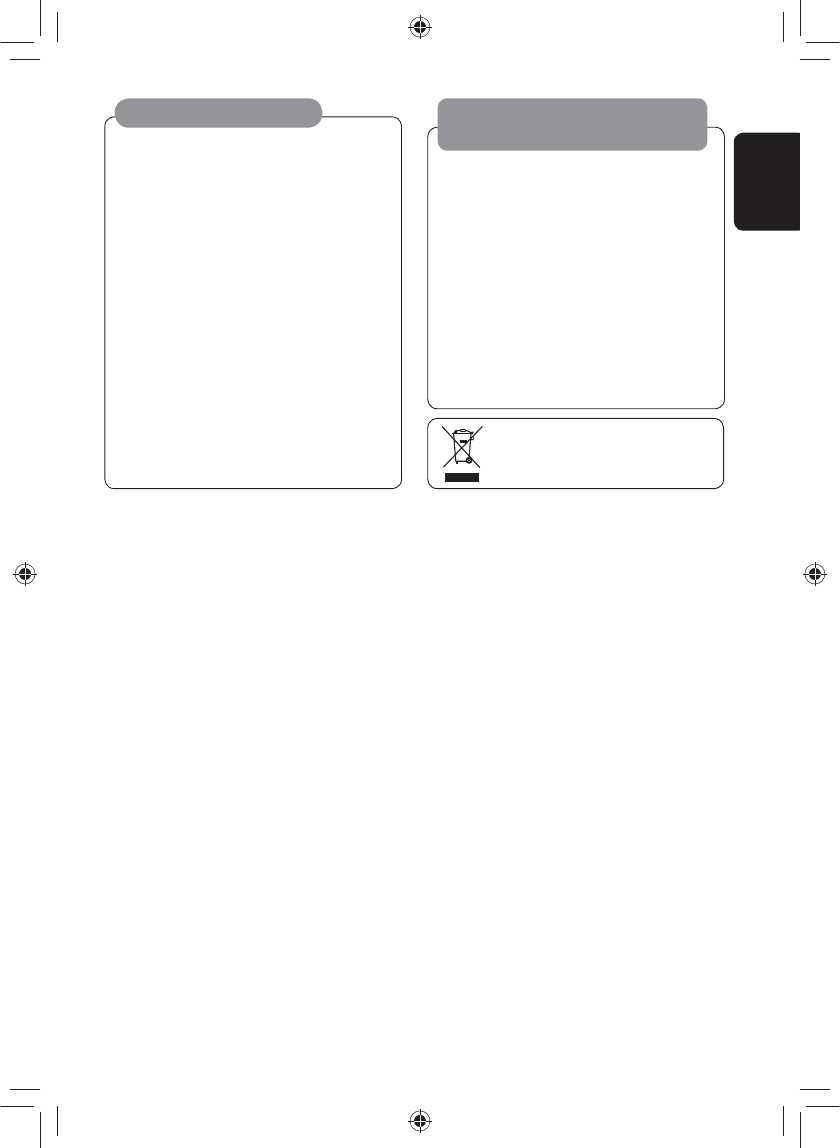
3
ENGLISH
• DO NOT install any unit or wire any cable in a
location where;
– it may obstruct the steering wheel and
gearshift lever operations.
– it may obstruct the operation of safety
devices such as air bags.
– it may obstruct visibility.
• DO NOT operate the unit while driving.
If you need to operate the unit while driving, be
sure to look around carefully.
• The driver must not watch the monitor while
driving.
• The monitor built in this unit has been produced
with high precision, but it may have some
ineffective dots. This is inevitable and is not
malfunction.
• Do not expose the monitor to direct sunlight.
• Do not operate the touch panel using a ball-point
pen or similar tool with the sharp tip.
Touch the buttons on the touch panel with your
finger directly (if you are wearing a glove, take it
off).
• When the temperature is very cold or very hot...
– Chemical changes occur inside, causing
malfunction.
– Pictures may not appear clearly or may move
slowly. Pictures may not be synchronized
with the sound or picture quality may
decline in such environments.
WARNINGS:
To prevent accidents and damage
Cautions on the monitor:
[European Union only]
Only for KW-NT30HD / Uniquement applicable au modèle KW-NT30HD
This equipment complies with FCC/IC radiation exposure limits set forth for an uncontrolled environment and meets the FCC radio
frequency (RF) Exposure Guidelines in Supplement C to OET65 and RSS-102 of the IC radio frequency (RF) Exposure rules. This
equipment has very low levels of RF energy that it deemed to comply without maximum permissive exposure evaluation (MPE).
But it is desirable that it should be installed and operated keeping the radiator at least 20 cm or more away from person’ s body
(excluding extremities: hands, wrists, feet and ankles).
Cet équipement est conforme aux limites FCC/IC d’exposition aux rayonnements définies pour un environnement non
réglementé, aux lignes directrices de la FCC en matière d’exposition aux radiofréquences spécifiées dans le supplément C du
bulletin OET65 et aux régulations RSS-102 de l’IC sur l’exposition aux radiofréquences (RF). Cet équipement étant associé à de très
faibles niveaux d’énergie radiofréquence, il est considéré conforme sans évaluation de l’exposition maximale admise (EMA). Il est
cependant conseillé de l’installer et de l’utiliser en maintenant la source de rayonnement radioélectrique à 20 cm minimum du
corps (à l’exclusion des extrémités du corps, à savoir les mains, les poignets, les pieds et les chevilles).
Under Industry Canada regulations, this radio transmitter may only operate using an antenna of a type and maximum (or lesser)
gain approved for the transmitter by Industry Canada. To reduce potential radio interference to other users, the antenna type
and its gain should be so chosen that the equivalent isotropically radiated power (e,i,r,p.) is not more than that necessary for
successful communication.
Selon les régulations d’Industrie Canada, cet émetteur radioélectrique peut uniquement fonctionner avec une antenne dont le
type et le gain maximum (ou inférieur) sont approuvés par Industrie Canada. Pour réduire les perturbations radioélectriques
potentielles pour les autres utilisateurs, le type et le gain de l’antenne doivent être choisis de façon que la puissance isotrope
rayonnée équivalente (P.I.R.E.) ne soit pas supérieure à la puissance nécessaire pour la réussite des communications.
This device complies with RSS-310 of Industry Canada. Operation is subject to the condition that this device does not cause
harmful interference.
Only for KW-NT50HDT
This equipment complies with FCC radiation exposure limits set forth for an uncontrolled environment and meets the FCC radio
frequency (RF) Exposure Guidelines in Supplement C to CET65. This equipment has very low levels of RF energy that it deemed
to comply without maximum permissive exposure evaluation (MPE). But it is desirable that it should be installed and operated
keeping the radiator at lease 20 cm or more away from person’ s body (excluding extremities: hands, wrists, feet ankles).
EN_KW-NT30_50[J].indb 3
EN_KW-NT30_50[J].indb 3
1/31/2011 3:24:03 PM
1/31/2011 3:24:03 PM
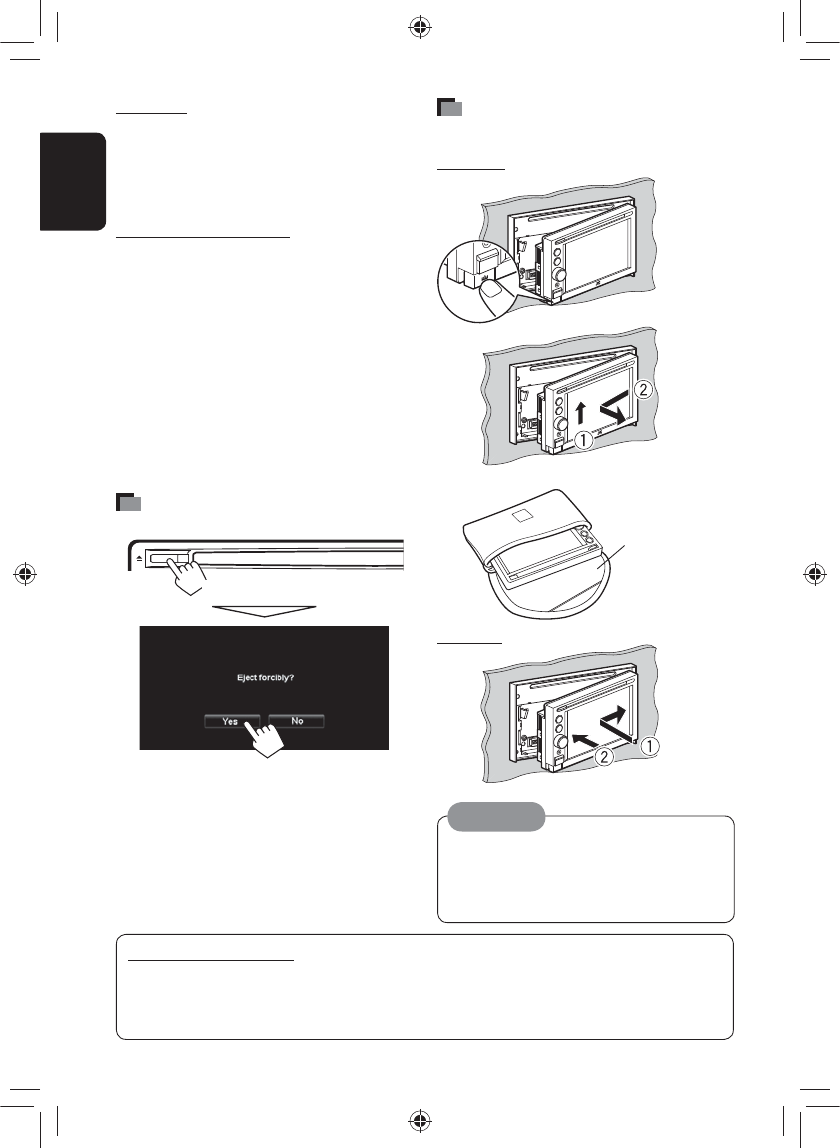
ENGLISH
4
• Hold the monitor panel securely so as not to drop
it accidentally.
• Fit the monitor panel onto the attaching plate
until it is firmly locked.
Soft case (supplied)
Caution:
Detaching/attaching the monitor
panel
Detaching
1
2
3
Attaching
For safety...
• Do not raise the volume level too much, as this will
block outside sounds, making driving dangerous.
• Stop the car before performing any complicated
operations.
Temperature inside the car...
If you have parked the car for a long time in hot or cold
weather, wait until the temperature in the car becomes
normal before operating the unit.
When replacing/rotating the tires:
It is required to clear all the accumulated calibration
data which is important for accurate navigation. To
clear the data, perform <Reset Calibration Data>.
(☞ page 39)
How to forcibly eject a disc
• Be careful not to drop the disc when it ejects.
• If this does not work, detach the monitor panel then
attach it (☞ right).
[Hold]
How to read this manual:
• Illustrations of KW-NT50HDT are mainly used for explanation.
• < > indicates the variable screens/menus/operations/settings that appear on the touch panel.
• [ ] indicates the buttons on the touch panel.
EN_KW-NT30_50[J].indb 4
EN_KW-NT30_50[J].indb 4
1/31/2011 3:24:03 PM
1/31/2011 3:24:03 PM
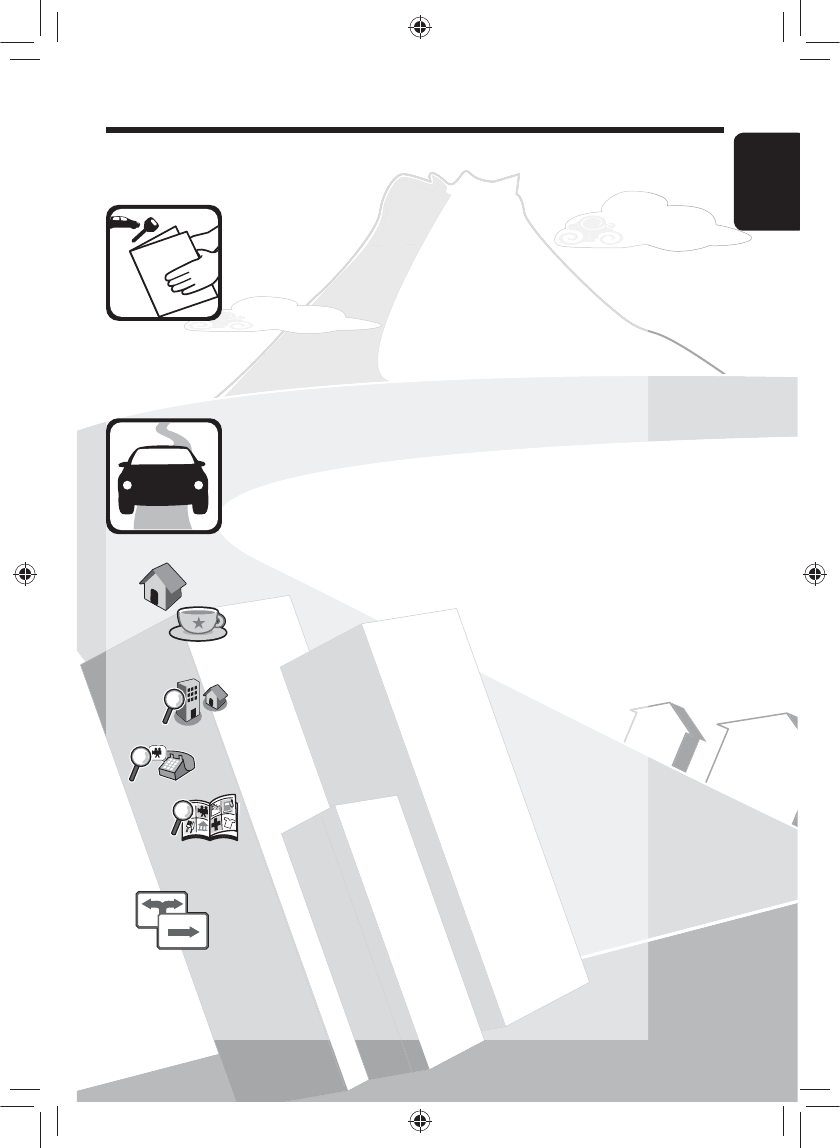
5
ENGLISH
Contents
How to forcibly eject a disc ....................................................... 4
Detaching/attaching the monitor panel .................................... 4
Introduction .......................................... 8
Parts identification .................................................................. 8
Installation settings ................................................................ 9
Basic operations .................................................................... 10
Turning on the power ..................................................................... 10
Messages about the status of GPS signal reception ......................... 10
Turning off/on the screen ............................................................... 10
Operations on the touch panel ........................................................ 11
Switching screens .................................................................. 12
Navigation System ............................. 14
Safety instructions/information for the Navigation System ........... 14
Information/icons on the map ........................................................ 14
Basic operations .................................................................... 15
About the current position screen ................................................... 15
To change the map scale ................................................................. 15
To scroll the map ............................................................................. 16
To display your current position ...................................................... 16
To change the map view ................................................................. 16
Registering your home/favorite points ................................... 17
Searching for a place .............................................................. 18
Setting a destination by scrolling the map ...................................... 18
About the search result screen ........................................................ 18
Setting a destination using the <Destination Menu> .................... 19
About search screens and input screens .......................................... 20
By address <Address> ................................................................... 21
By telephone number <Phone> .................................................... 22
From the list of POI <POI Name> ................................................... 23
POI near a place/route <Vicinity> .................................................. 24
By coordinates <Coordinates> ....................................................... 25
From the list of POIs imported by yourself <Assistant POIs> .......... 25
Quick Search ................................................................................... 26
How you are guided ............................................................... 28
Starting guidance to the destination or via point ............................ 28
Changing route options .................................................................. 29
Canceling guidance ......................................................................... 29
Adjusting the volume of the voice guidance ................................... 29
About route guidance screen .......................................................... 30
Getting information on your route and places ................................ 31
•
•
•
•
•
•
•
•
•
•
•
•
•
•
•
•
•
•
•
•
•
•
•
•
•
•
•
EN_KW-NT30_50[J].indb 5
EN_KW-NT30_50[J].indb 5
1/31/2011 3:24:03 PM
1/31/2011 3:24:03 PM
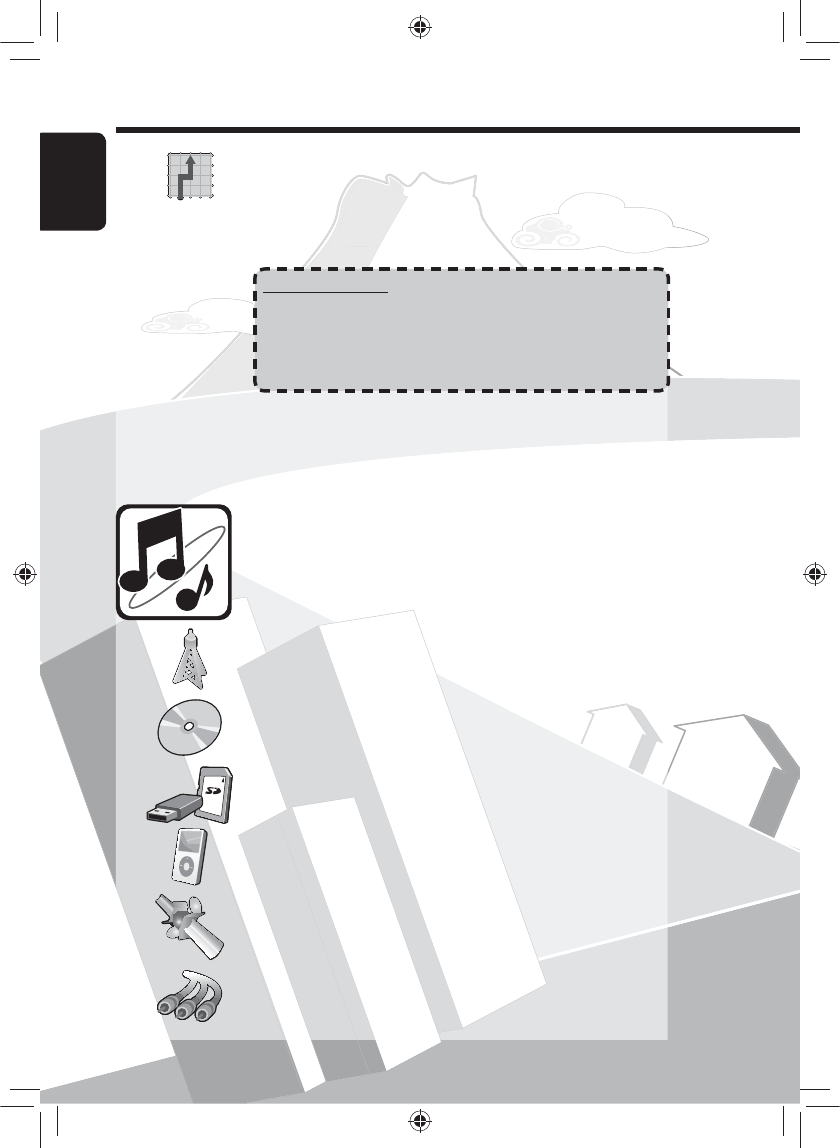
ENGLISH
6
Contents
Arranging your route ............................................................. 32
Changing the sequence of the destination/via points ..................... 32
Avoiding a congestion ahead .......................................................... 33
Adjusting the vehicle position ......................................................... 33
Editing registration of home/favorite points ........................... 34
Only for KW-NT50HDT
Using information service ................................................ 35
Using the traffic information service ............................................... 35
Using the area information service
(Total Traffic HD NET WORK Service) ............................................... 37
Checking the information of the navigation system ................. 38
Initializing memories/navigation settings .............................. 39
Navigation menu items .......................................................... 40
Additional information .......................................................... 42
AV Operations ..................................... 44
Common operations on AV screens .......................................... 44
Selecting the playback source ......................................................... 44
Turning off the AV source ................................................................ 44
Listening to the HD Radio™ broadcast ..................................... 45
Changing HD Radio reception mode ............................................... 46
Storing stations in memory ............................................................. 46
Selecting a preset station ................................................................ 47
Reducing the interference ............................................................... 47
Tagging/purchasing your favorite songs from iTunes Store ............ 48
Disc operations ...................................................................... 50
Playable disc types .......................................................................... 51
Selecting playback modes ............................................................... 55
Settings for the disc playback .......................................................... 56
SD/USB operations ................................................................. 57
Listening to the iPod/iPhone device ........................................ 59
Selecting a track/video from menu on the iPod/iPhone .................. 61
Listening to iheartradio with the iPod/iPhone ................................ 62
Listening to the satellite radio ............................................... 66
Activating subscription ................................................................... 66
Storing channels in memory ........................................................... 68
Selecting preset channels ............................................................... 68
Selecting a channel quickly ............................................................. 68
•
•
•
•
•
•
•
•
•
•
•
•
•
•
•
•
•
•
•
•
•
EN_KW-NT30_50[J].indb 6
EN_KW-NT30_50[J].indb 6
1/31/2011 3:24:04 PM
1/31/2011 3:24:04 PM
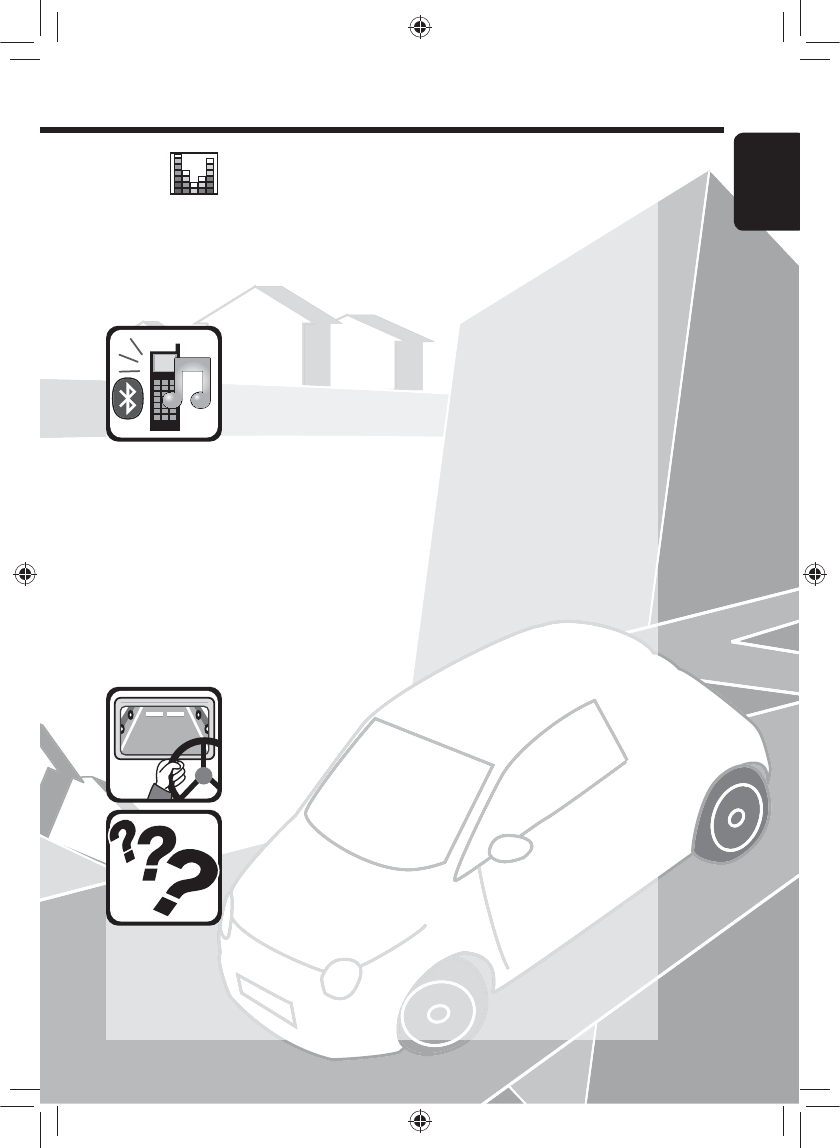
7
ENGLISH
Using other external components ........................................... 69
Front AUX ........................................................................................ 69
AV-IN .............................................................................................. 69
Sound equalization ................................................................ 70
Changing illumination color ................................................... 71
Settings for video playback .................................................... 72
Picture adjustment ......................................................................... 72
Changing the aspect ratio ............................................................... 72
AV menu items ...................................................................... 72
Additional information .......................................................... 76
Bluetooth Operations ........................ 78
Information for using Bluetooth® devices ............................... 78
Using Bluetooth device .......................................................... 79
Registering a Bluetooth device ....................................................... 79
Connecting/disconnecting a registered Bluetooth device ............... 80
Deleting a registered Bluetooth device ........................................... 80
Using Bluetooth mobile phone ............................................... 81
Receiving a call ............................................................................... 81
Adjusting the volume of calls/earpiece ........................................... 81
Switching between handsfree mode and phone mode ................... 82
Making a call ................................................................................... 82
Copying the phone book ................................................................. 83
Searching for a phone number from phone book ............................ 83
Deleting the phone number memory in the unit............................. 84
About mobile phone compatible with Phone Book Access Profile
(PBAP) ............................................................................................ 84
Using Bluetooth audio player ................................................. 85
Bluetooth device settings ...................................................... 86
Rear View Camera Operations ........... 87
Using a rear view camera ....................................................... 87
Activating the rear view camera ..................................................... 87
Displaying the picture from the rear view camera ........................... 87
References ........................................... 88
Maintenance ......................................................................... 88
Troubleshooting/error messages ............................................ 89
Specifications ........................................................................ 95
•
•
•
•
•
•
•
•
•
•
•
•
•
•
•
•
•
EN_KW-NT30_50[J].indb 7
EN_KW-NT30_50[J].indb 7
1/31/2011 3:24:05 PM
1/31/2011 3:24:05 PM
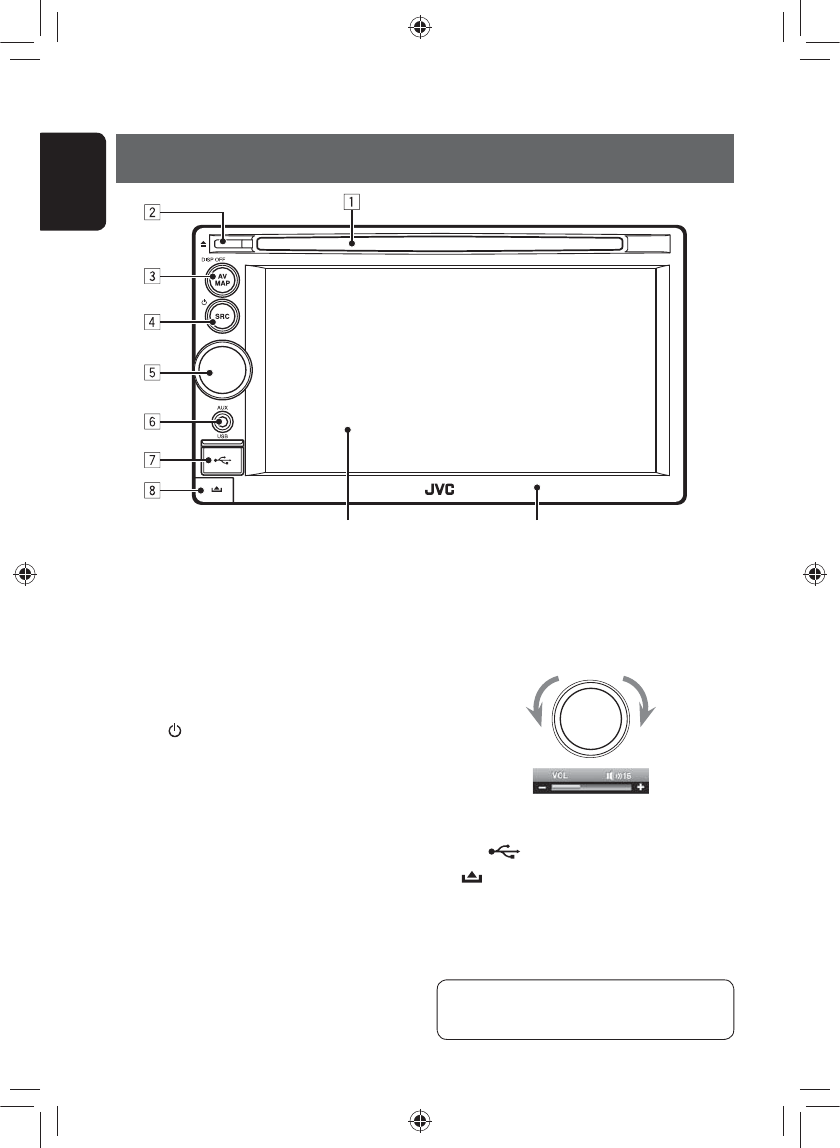
ENGLISH
8
Introduction
Parts identification
Screen (touch panel) Monitor panel
1 Loading slot
2 0 (Eject) button
Ejects the disc.
3 AV MAP/DISP OFF button
• Switches the screen between the map screen
and AV screen. (☞ page 12)
• Turns off/on the screen. [Hold] (☞ page 10)
4 SRC / button
• Selects the source. (☞ page 44)
• Turns off/on the AV function. [Hold]
(☞ page 44)
5 Volume adjustment knob
Adjusts the audio volume.
• About the adjustable volume range, ☞ page 73
(<Amplifier Gain>).
• To adjust the guidance volume, ☞ page 29.
6 AUX input terminal
7 USB input terminal
8 (Detach) button
Detaches the monitor panel. (☞ page 4)
IncreaseDecrease
You can change the color of the buttons on the
monitor panel. (☞ page 71)
EN_KW-NT30_50[J].indb 8
EN_KW-NT30_50[J].indb 8
1/31/2011 3:24:05 PM
1/31/2011 3:24:05 PM
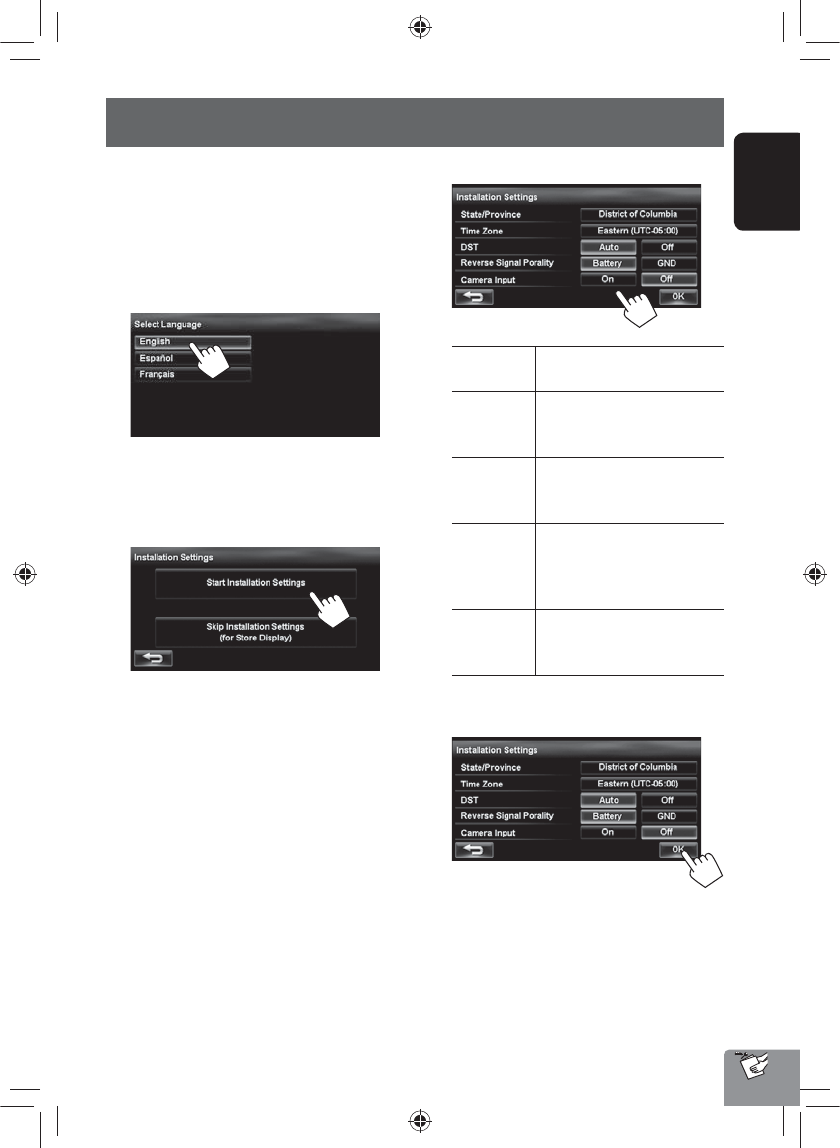
9
ENGLISH
Installation settings
When you turn on the unit for the first time, the initial
setup screen appears.
1 Turn on the ignition switch.
The power is turned on, and the startup screen is
displayed for about 5 seconds.
2 Select the language you want for the display
and the voice guidance.
• You can also select the system language through
the AV menu (<Settings> - <System> -
<Language>, ☞ page 75)
3 Display installation settings screen.
• If you select [Skip Installation Settings (for
Store Display)], the System starts in the store
display mode.
You need to make the installation settings next
time you turn on the power.
– When you turn on the power, <Select
Language> appears. After selecting
the language, the confirmation message
appears. Press [Yes] so that the System starts
initialization. When initialization is complete,
<Select Language> (☞ Step 2 above) is
displayed.
4 Adjust the settings.
State/
Province
Select the State or Province where
you are now.
Time Zone * Select your residential area for
automatic clock adjustment by
GPS signal.
DST * Select <Auto> if your residential
area is subject to Daylight Saving
Time.
Reverse
Signal
Polarity *
Select the reverse signal polarity
(<Battery> or <GND>)
according to the connection of
your car.
Camera
Input *
Select <On> when connecting
the rear view camera to the
CAMERA IN jack.
* You can also change these settings through the AV
menu (<Settings>, ☞ page 75).
5
EN_KW-NT30_50[J].indb 9
EN_KW-NT30_50[J].indb 9
1/31/2011 3:24:06 PM
1/31/2011 3:24:06 PM
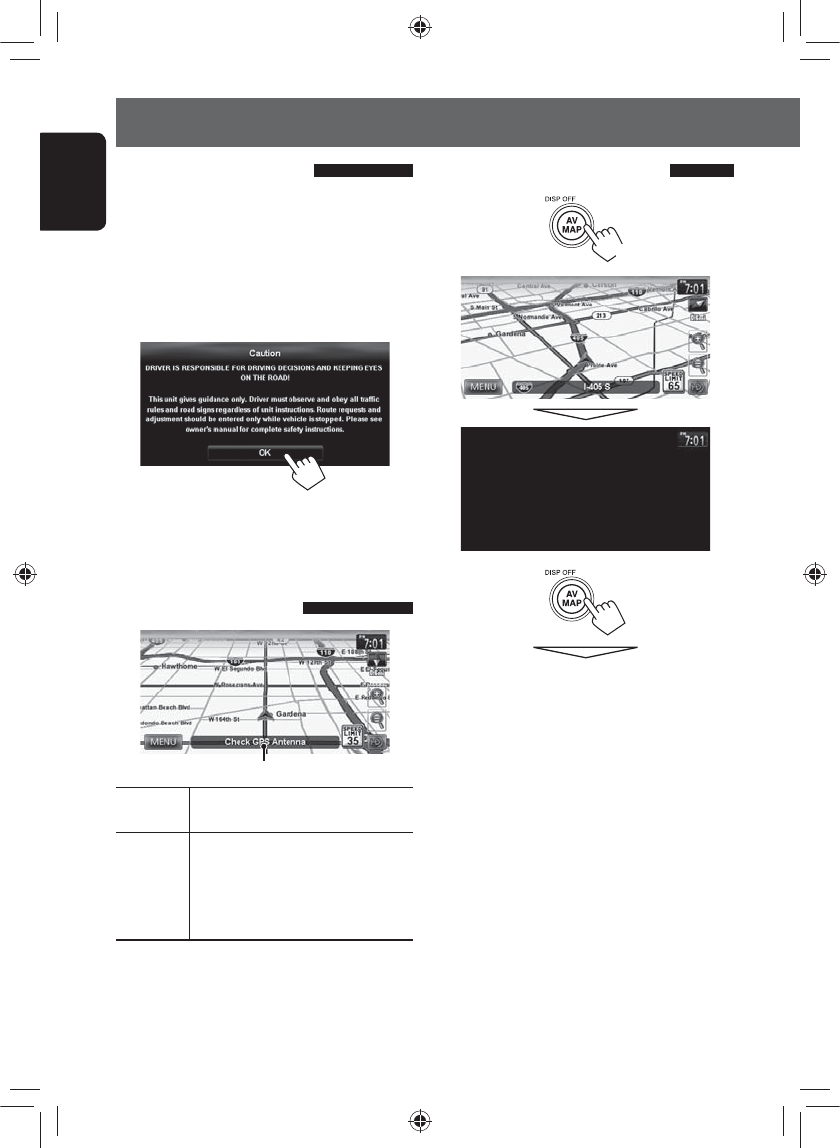
ENGLISH
10
Basic operations
Turning on the power
Turn on the ignition switch.
Startup screen appears for about 5 seconds.
• You can change the startup screen. (☞ page 75)
• When displaying the map screen for the first time
after turning on the power, the screen below
appears. Press [OK] to use the map screen.
• The power is turned off when the ignition switch is
turned off.
Messages about the status of
GPS signal reception
“Check GPS
Antenna”
Check the connection of the GPS
antenna.
“Acquiring
GPS Signal”
• Acquiring GPS signals. Wait until
signal reception is completed.
• GPS signals cannot be received. Move
to the place where the System receives
the GPS signals.
Current status of the GPS signal reception
Turning off/on the screen
• You can erase the clock display while the screen is
turned off. (<Clock on Video/Screen-Off>, ☞
page 74)
The screen is turned on.
[Hold]
EN_KW-NT30_50[J].indb 10
EN_KW-NT30_50[J].indb 10
1/31/2011 3:24:06 PM
1/31/2011 3:24:06 PM
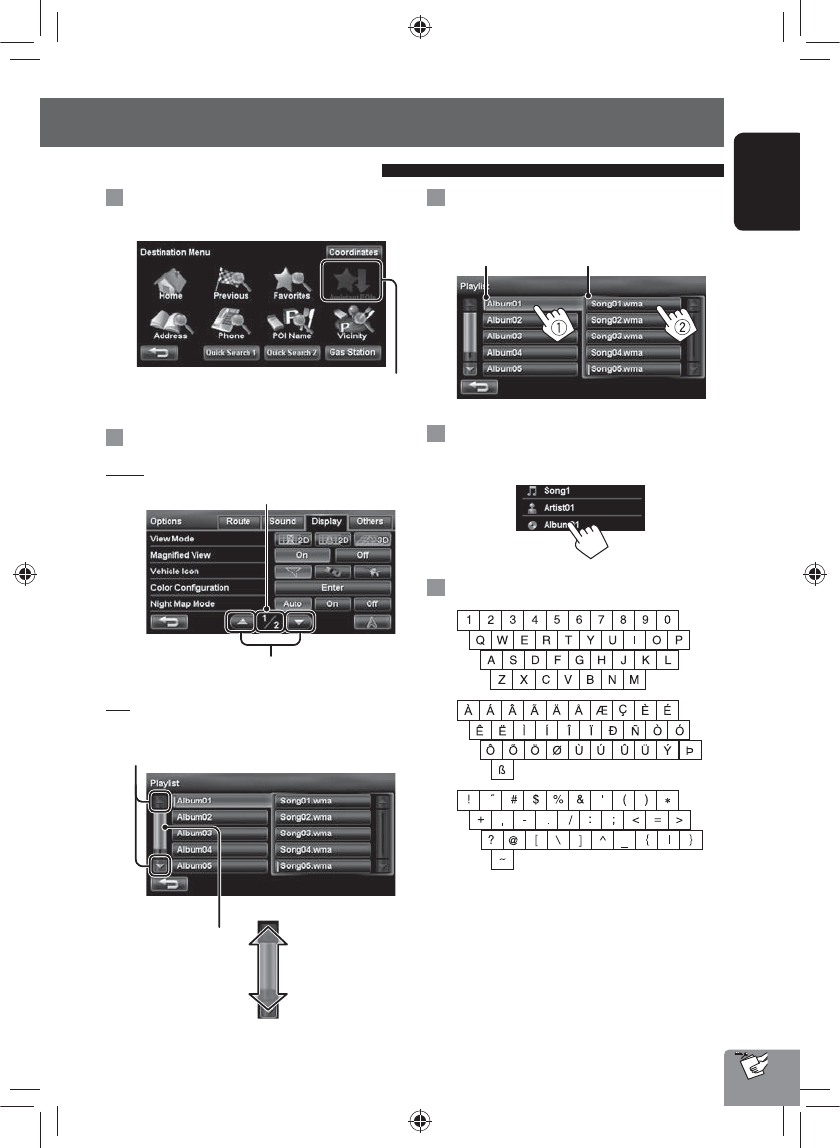
11
ENGLISH
Current page/total menu pages
Changes the page
Changes the page
Current folder Current track
When items on the menu are not
available
To change the page of menu/list
Menu
List
Ex.: Folder/track list
To select folder/track on the list
Select a folder (1), then a track (2).
Scrolling the track/song information
When all the text is not shown at once...
Characters you can use
Operations on the touch panel
Non-available items will be shaded
Skips the list up or down
Basic operations
EN_KW-NT30_50[J].indb 11
EN_KW-NT30_50[J].indb 11
1/31/2011 3:24:06 PM
1/31/2011 3:24:06 PM
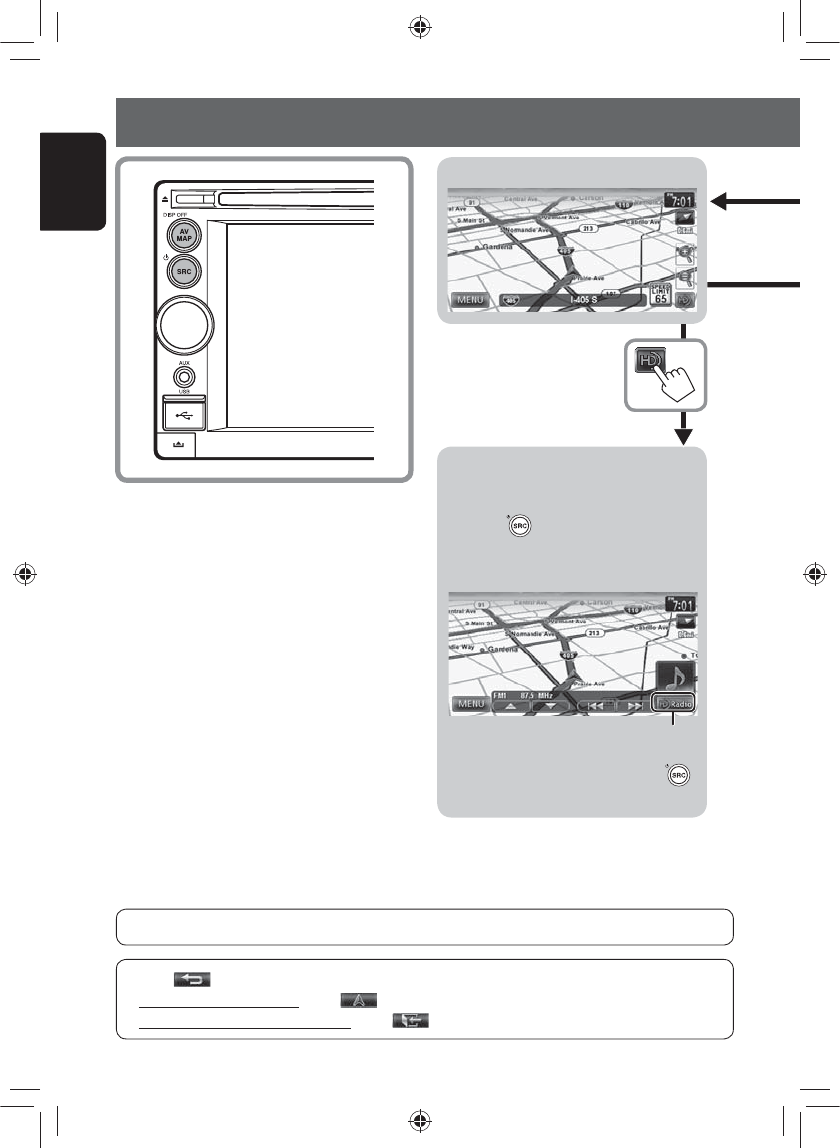
ENGLISH
12
Switching screens
Map screen
• Press [ ] to return to the previous screen.
• On navigation screens only: press [ ] to display the current position on the map.
• On <Settings> on <AV Menu> only: press [ ] to display the current source screen.
While driving at a speed greater than 6 mi (10 km/h), some screens on the navigation menus are not available.
Erases the AV control bar
The AV control bar is displayed on the map
screen. You can perform AV source operations
using the AV control bar.
• Pressing also displays the AV control
bar. In this case, the AV control bar
disappears automatically after 5 seconds.
• You can change the source by pressing
while the AV control bar is displayed.
EN_KW-NT30_50[J].indb 12
EN_KW-NT30_50[J].indb 12
1/31/2011 3:24:07 PM
1/31/2011 3:24:07 PM
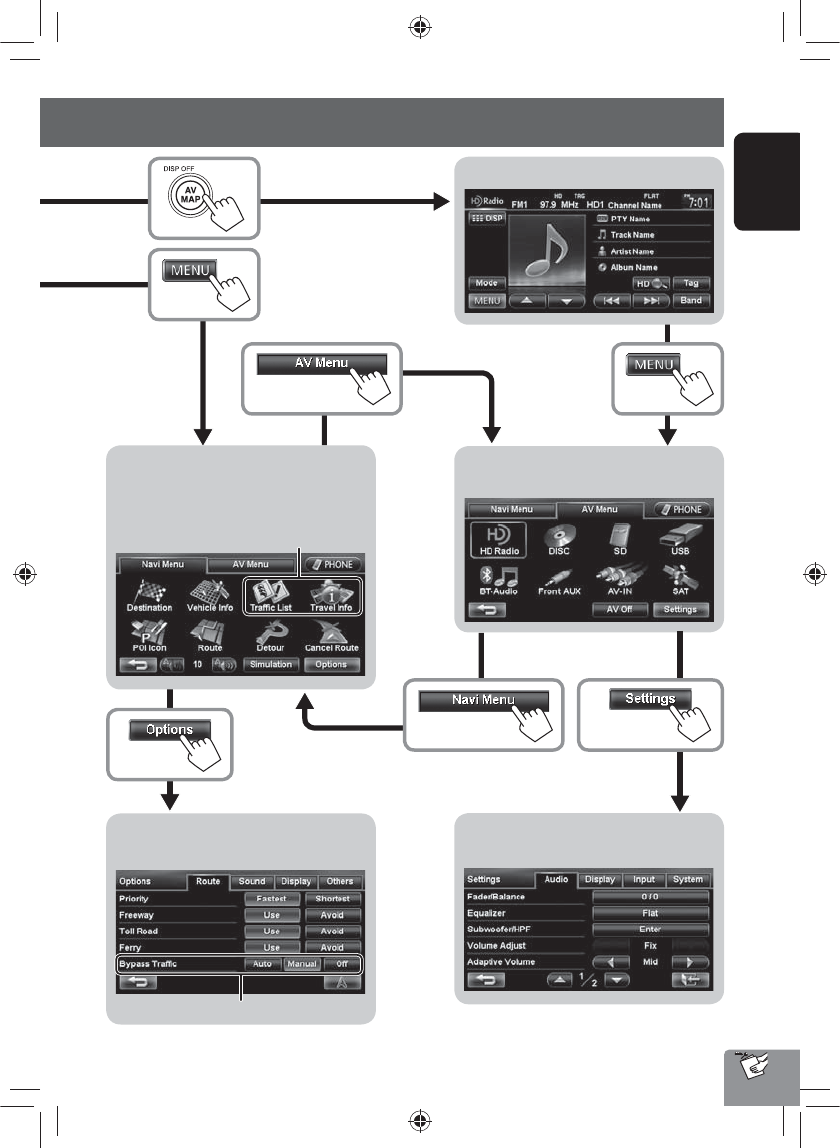
13
ENGLISH
Navi Menu
Shows the destination menu and information
about the navigation system.
Options
Changes the navigation settings. (☞ page 40)
AV Menu
Changes or turns off the AV source.
Settings
Changes the detailed settings. (☞ page 72)
AV screen
Only for KW-NT50HDT
Only for KW-NT50HDT
Switching screens
EN_KW-NT30_50[J].indb 13
EN_KW-NT30_50[J].indb 13
1/31/2011 3:24:07 PM
1/31/2011 3:24:07 PM
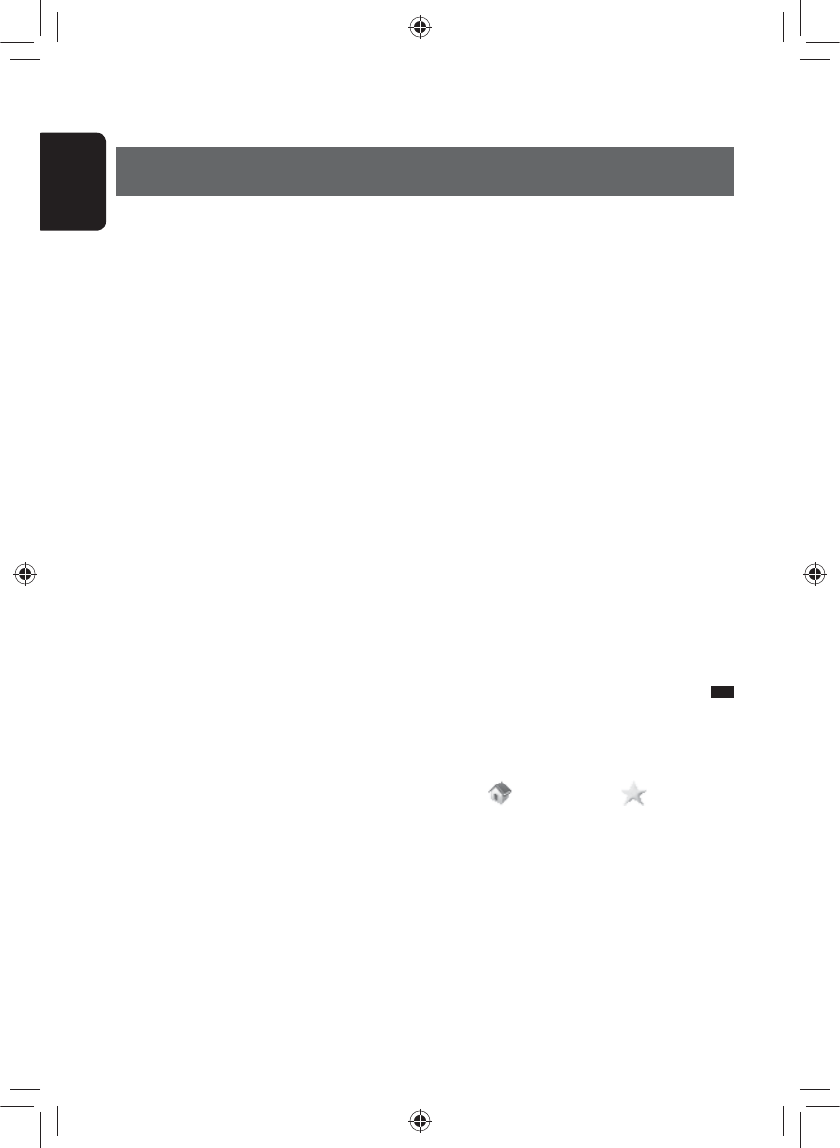
14
ENGLISH
Safety instructions/information for the Navigation System
Navigation System
SAFETY INSTRUCTIONS
Use of the Navigation System is only permitted if the
traffic conditions are suitable and you are absolutely
sure that no risk, obstruction or inconvenience will be
incurred to you, your passengers or other road users.
The requirements of the Road Traffic Regulations must
always be followed. The destination must not be
entered while driving the car.
The Navigation System serves solely as an aid to
navigation. It never releases the drivers from their
duties to drive carefully and to make own judgement
in road traffic. Inaccurate or incorrect instructions
may happen to be given due to changing traffic
conditions. The actual road signs and traffic regulations
must therefore always be observed. In particular,
the Navigation System cannot be used as an aid to
orientation when visibility is poor.
This Navigation System must only be used for its
intended purpose. The volume of the car radio/
Navigation System must be adjusted so that external
noise is still audible.
Navigation guidance is performed, based on the
database, therefore, it may not be applicable to
the current situation because of changes in traffic
conditions (e.g. changes in tollroads, principal roads,
one-way traffic, or other traffic regulations). In this
case, observe the current traffic signs or regulations.
• Traffic signs should be observed carefully while
driving using the Navigation System. Navigation
System is only an aid. Driver must always decide
whether or not to heed the information provided.
JVC does not accept liability for erroneous data
provided by the Navigation System.
• Traffic guidance is restricted to passenger vehicles
only. Special driving recommendations and
regulations for other vehicles (e.g. commercial
vehicles) are not included.
• Do not operate the unit while driving.
Terms of licence
You are granted a non-exclusive licence to use the
database for your personal purposes. The present
licence does not authorise the granting of sublicenses.
Use of the data is only permitted in this specific JVC
system. It is forbidden to extract or make further use
of significant parts of the database content, or to
duplicate, modify, adapt, translate, analyse, decompile
or reverse-engineer any part thereof.
WARNING:
Map content, including names and appearance of streets
and bridges, POI information, etc. may be inaccurate. If
the traffic rules displayed by the unit are different from
the actual traffic rules, obey the actual traffic rules.
Road traffic regulations always take priority when a
vehicle is being driven in traffic. Navigation System is
only an aid. Errors may occur in individual data items/
entries. At all times, the driver must decide whether or
not to heed the information provided.
JVC does not accept liability for erroneous data provided
by the Navigation System.
© 2009 NAVTEQ All rights reserved.
Information/icons on the map
• The information on the map (such as street name, the
POI information, and speed limit) may not be always
displayed (for example, if the System does not have
the information of the position).
• Home ( ) and favorite point ( ) icons are
displayed after home/favorite points are registered.
• POI icons are displayed on the map depending on the
<POI Icon> setting (☞ page 15) and the map scale
is between 80 ft (25 m) and 800 ft (250 m).
– The following icons are displayed when the map
scale is between 80 ft (25 m) and 0.6 mi (1 km):
– Airport icon in the travel category
– Golf course icon in the leisure category
– Gas station icons
• POI icons may not be displayed correctly when the
System displays the wide area of map. In this case,
zoom in the map to display the detailed map.
EN_KW-NT30_50[J].indb 14
EN_KW-NT30_50[J].indb 14
1/31/2011 3:24:08 PM
1/31/2011 3:24:08 PM
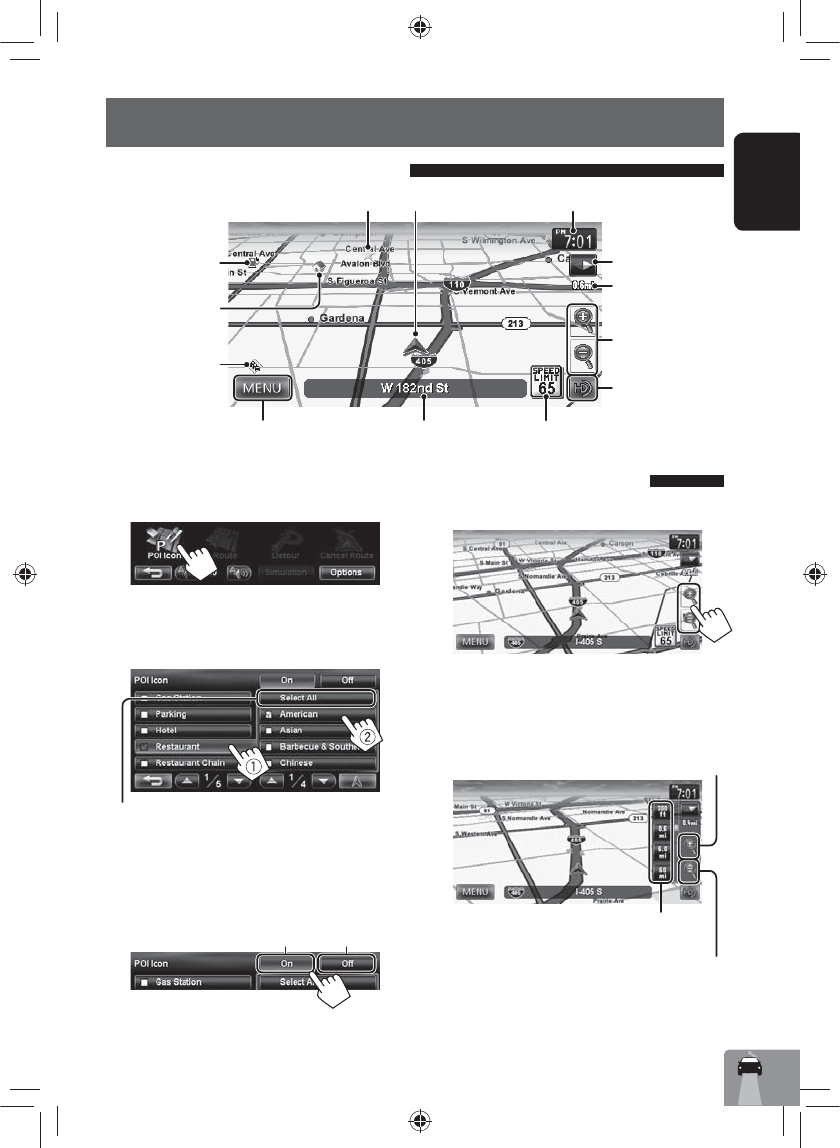
Zoom in
15
ENGLISH
To change the map scale
1 Display the zoom buttons and scale buttons.
• When the AV control bar is displayed, the zoom
buttons are not shown. Erase the AV control
bar by pressing the source icon on the bar.
(☞ page 12)
2
• If the scale is set to 60 mi (100 km) or higher, the
map view becomes North Up regardless of the
current map view setting.
Basic operations
Your position
Current street
Current time
Speed limit on the current street
Scale
Direction
Shows <Navi Menu> (☞ page 13)
Favorite points (☞ pages 17 and 34)
Home (☞ pages 17
and 34)
POI (Point Of Interest)
(☞ “List of POI icons”,
page 43)
Zoom buttons
(☞ below)
Traffic information
(only for KW-NT50HDT)
(☞ page 35)
Zoom out
You can also select a scale directly by pressing
one of the scale buttons.
Shows the AV control
bar (☞ page 12)
About the current position screen
To display/hide POI icons on the map
1 On <Navi Menu>:
2 Select categories (1) and sub-categories
(2) of POI which you want to be displayed on
the map.
• The selected items are marked with “✔.”
3 Activate or deactivate the POI icons of the
selected categories.
Displays the selected POI icons Deactivates
[Select All]: Selects all sub-categories
[Deselect All]: Deselects all sub-categories.
EN_KW-NT30_50[J].indb 15
EN_KW-NT30_50[J].indb 15
1/31/2011 3:24:08 PM
1/31/2011 3:24:08 PM
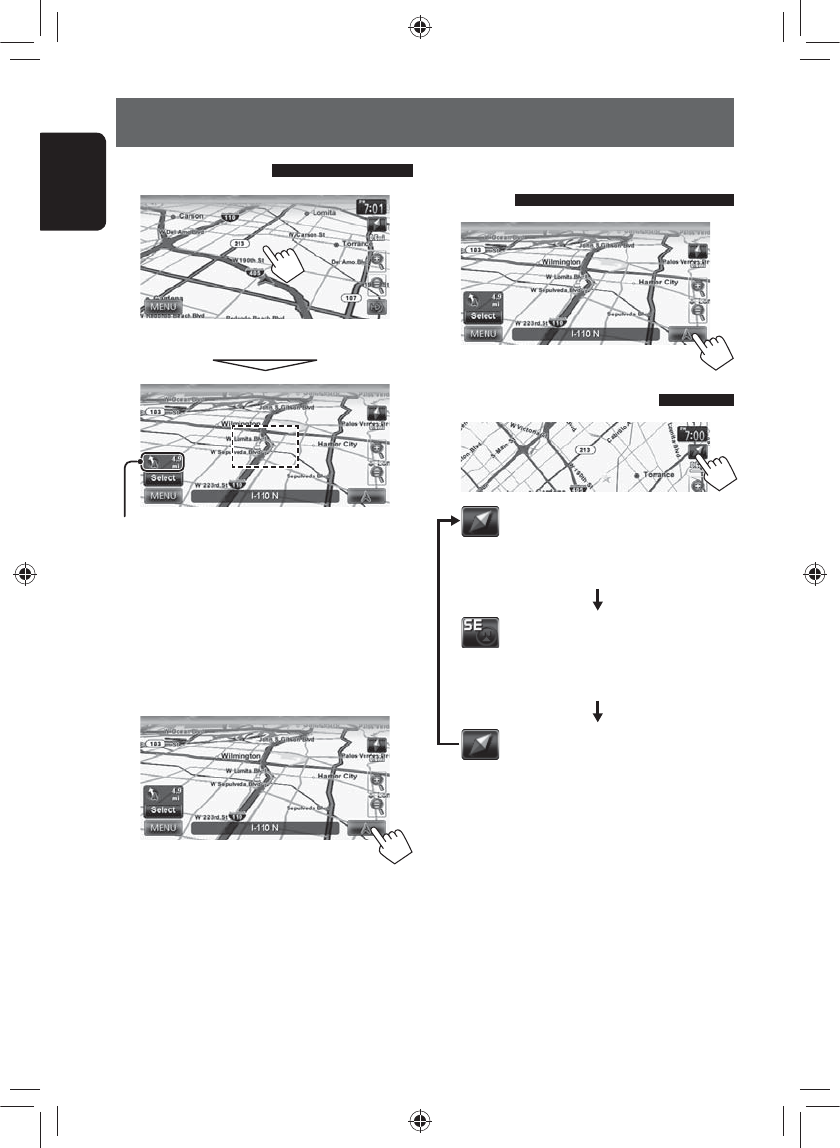
16
ENGLISH
To scroll the map
The position you touched is centered on the map.
• Touch and hold the map to keep scrolling the map.
• The scrolling speed varies depending on the position
you are touching and holding:
– Inner area: slow
– Outer area: fast
To display the current position
Direction and distance from your current position
To display your current
position
To change the map view
3D Map
The three dimensional map is displayed in
“heading up.”
• The icon shows the direction of north.
2D North Up
The map view is oriented with north
“upwards,” as in usual paper maps.
• The icon shows the direction of the car.
2D Heading Up
The map rotates so that you are always
displayed heading “upwards.”
• The icon shows the direction of north.
• You can also change the map view through the
navigation menu (<Options> - <Display> -
<View Mode>, ☞ page 41).
Basic operations
EN_KW-NT30_50[J].indb 16
EN_KW-NT30_50[J].indb 16
1/31/2011 3:24:08 PM
1/31/2011 3:24:08 PM
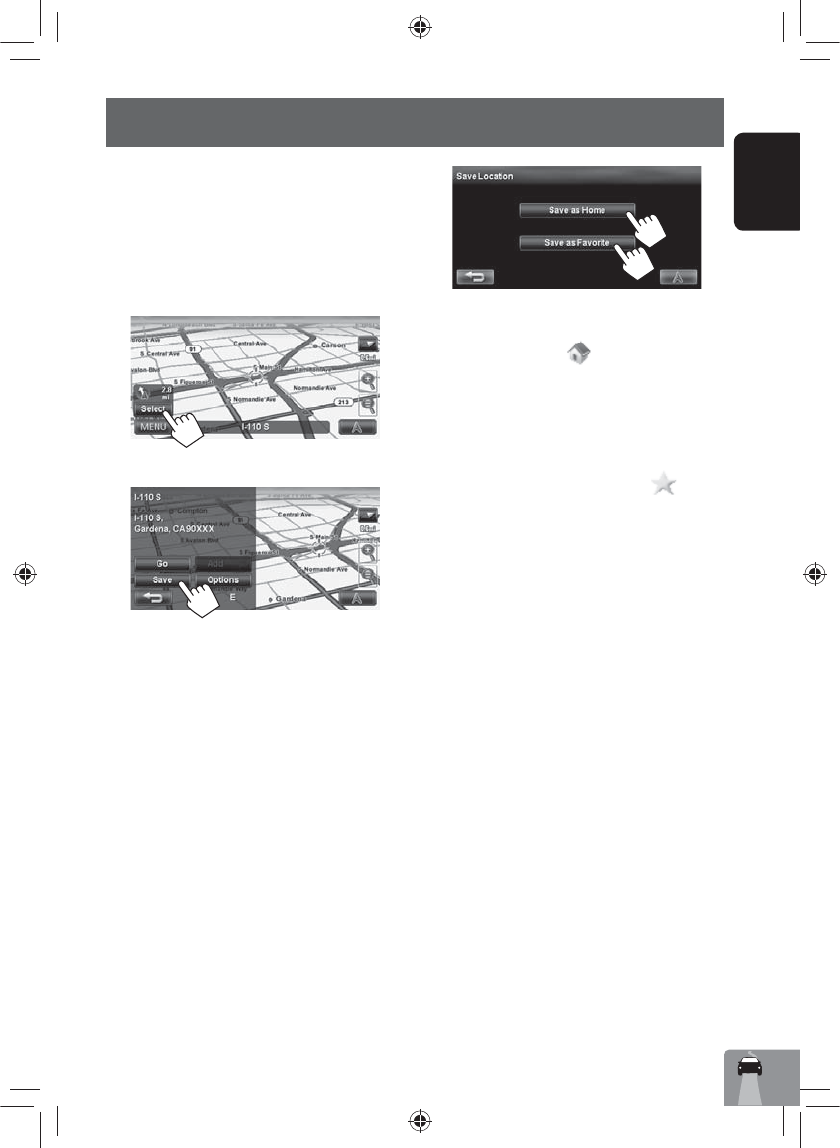
17
ENGLISH
Registering your home/favorite points
You can register one point as your home or 100 favorite
points.
1 Scroll the map to select the position you
want to select as a destination.
• To search the destination using <Destination
Menu>, ☞ pages 19 to 27.
2
3
4
[Save as Home]:
The selected position is saved as home and the
home is marked with icon on the map.
• When the home is already registered, you
are asked if you want to replace the old home.
Press [Yes] to replace, or press [No] to cancel.
[Save as Favorite]:
The selected position is saved as a favorite point
and the favorite point is marked with icon on
the map.
• To edit the registration, ☞ page 34.
EN_KW-NT30_50[J].indb 17
EN_KW-NT30_50[J].indb 17
1/31/2011 3:24:09 PM
1/31/2011 3:24:09 PM
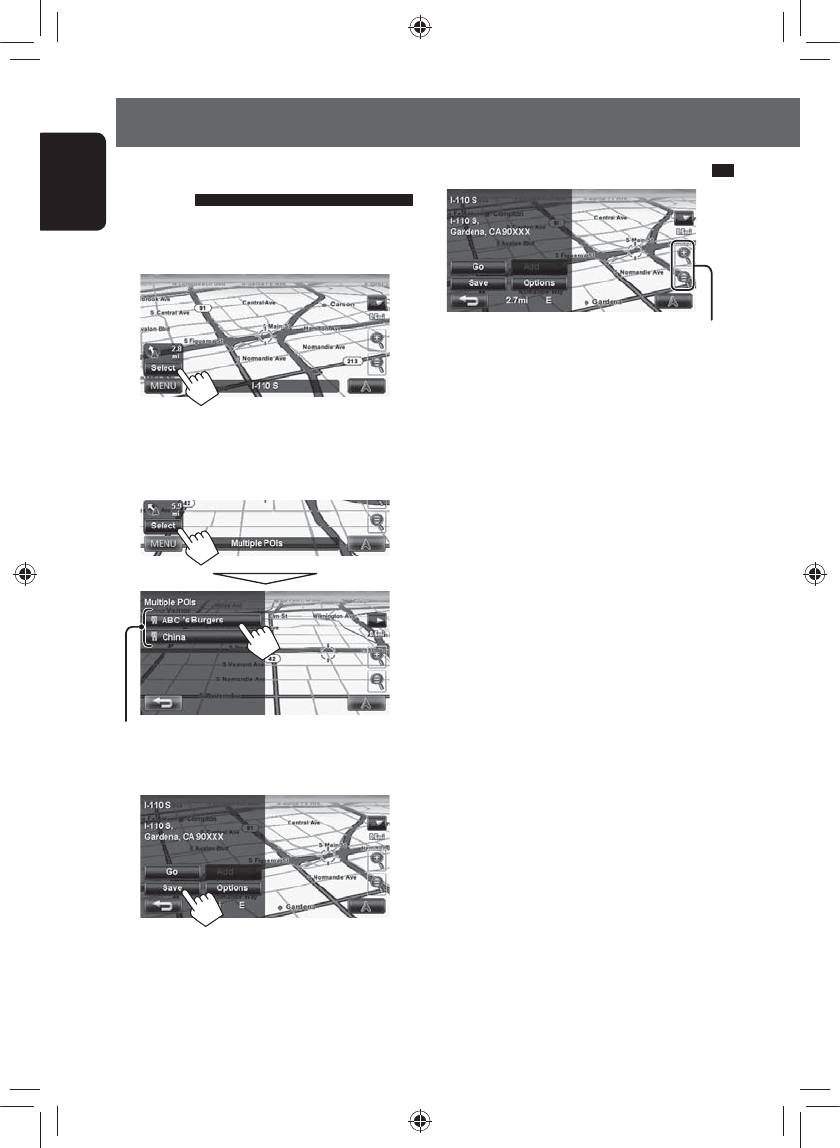
18
ENGLISH
Searching for a place
Setting a destination by scrolling
the map
1 Scroll the map to select the position you
want to select as a destination. (☞ page 16)
2
• If there are several POIs on the selected position,
select one from the list.
– The list appears only when <POI Icon> is set
to <On>. (☞ page 15)
3 The search result is displayed.
Guidance starts.
• To cancel guidance, ☞ page 29.
• To set the selected position as via point, ☞ page 28.
• To change route options, ☞ page 29.
• For details about the search result screen, ☞ right.
About the search result screen
• You can change the map scale by pressing the zoom
buttons.
• You can display the map of selected area on whole
screen by touching the map part once. (If you press
more than once, the map scrolls.) To display the
information screen again, press [Select].
Zoom buttons
POIs
EN_KW-NT30_50[J].indb 18
EN_KW-NT30_50[J].indb 18
1/31/2011 3:24:09 PM
1/31/2011 3:24:09 PM
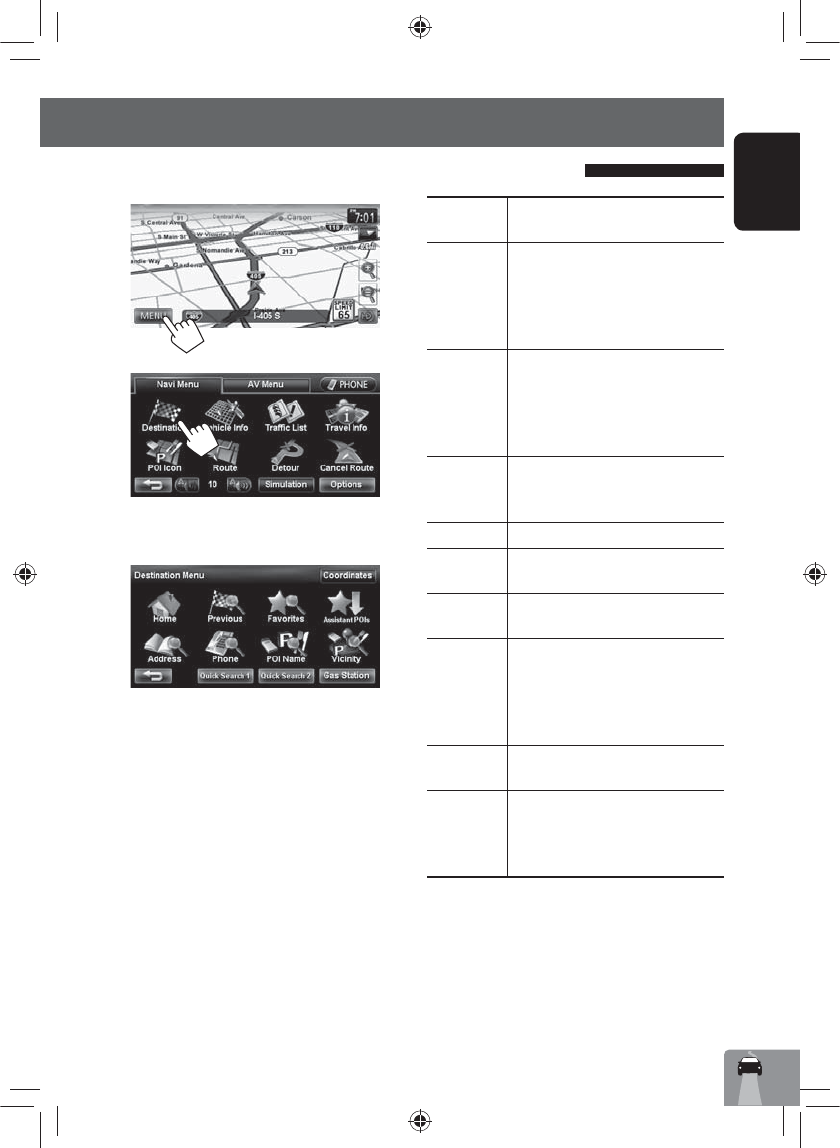
19
ENGLISH
Searching for a place
Home *Goes to your home.
• To register your home, ☞ page 17.
Previous *Searches from the history of previous
destinations and via points.
• You can select a place from the last
50 destinations and via points.
• To delete the history, ☞ page 39.
Favorites *Searches from your favorite points.
• To register your favorite points,
☞ page 17.
• To edit the information about the
favorite points, ☞ page 34.
Assistant
POIs
Searches from the list of POIs (Point Of
Interest) saved on the SD card using
Street Director Assistant. (☞ page 25)
Address Searches by an address. (☞ page 21)
Phone Searches by a telephone number.
(☞ page 22)
POI Name Searches from the database of POI.
(☞ page 23)
Vicinity Searches for POIs (Point Of Interest)
around your current position, the
position selected on the map, the
destination, or the route you are taking.
(☞ page 24)
Coordinates Searches by coordinates of the
destination. (☞ page 25)
Quick
Search
Searches for POIs of a registered
category — [Quick Search 1]/[Quick
Search 2]/[Gas Station] (Initial). (☞
page 26)
* Selectable only when at least one place is registered.
• When searching from the Destination Menu, results
are always displayed using the 2D North up map
view regardless of the current map view setting.
(☞ page 16)
Setting a destination using the <Destination Menu>
1
2
3 Select a method to search for a destination.
EN_KW-NT30_50[J].indb 19
EN_KW-NT30_50[J].indb 19
1/31/2011 3:24:09 PM
1/31/2011 3:24:09 PM
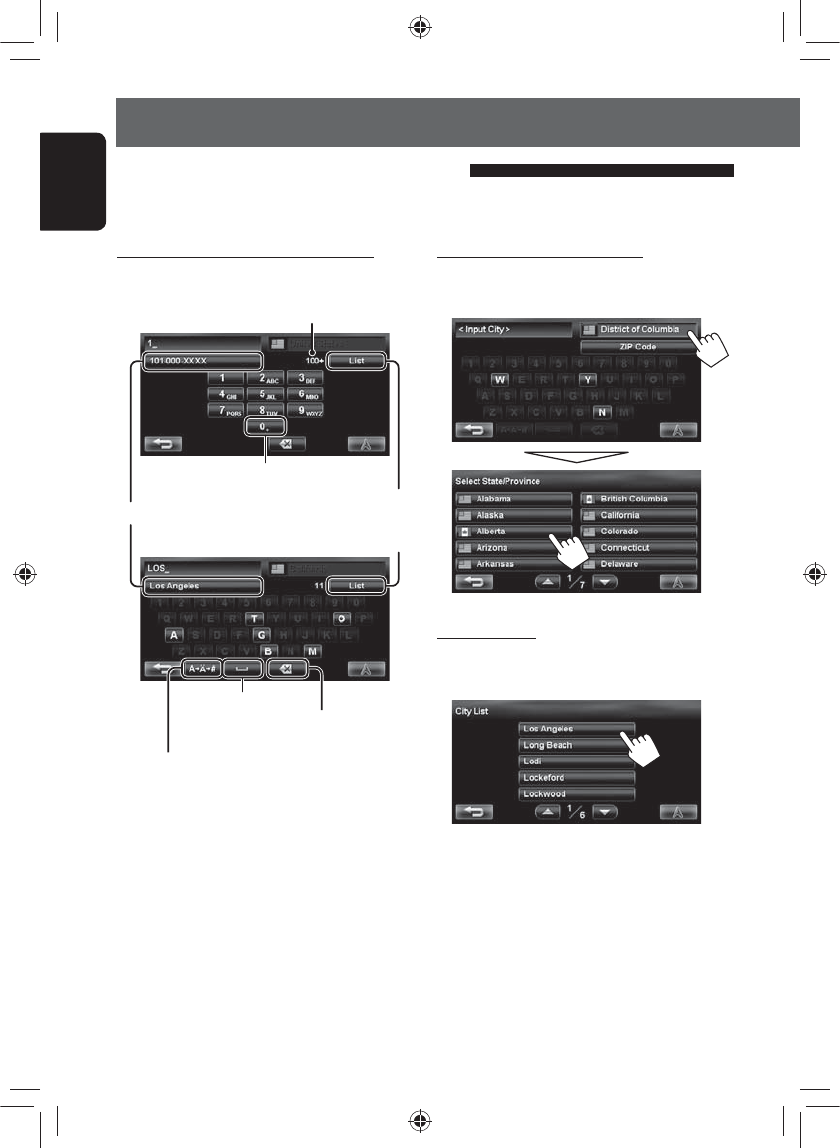
20
ENGLISH
Searching for a place
Displays other keyboards
• For available characters, ☞ page 11.
Enters a space
Selects 1st candidate
Number of matches
• When there are more than 100 matches, “100+” is
displayed and only first 100 matches are displayed.
Press: Deletes last character
Hold: Deletes all characters
Displays the list of matches
(☞ “List of matches” on
the right)
About search screens and input screens
Read through the following instructions for using search screens and input screens before using <Destination
Menu>.
State/Province selecting screen
You can change the State/Province if the selecting
button appears on the screen.
List of matches
When you press [List] on the input screen, the list of
matches appears. Select desired item from the list.
• When the number of matches is 5 or less, the list of
matches automatically appears.
To enter names, addresses, or numbers
• Buttons vary depending on the input item.
• Non-available items will be shaded on the menu
screen.
• For some input screens, available characters are
automatically narrowed down as the System
searches its database for matches.
• Lower cases are not available.
Hold: Adds “+1” or “+”
EN_KW-NT30_50[J].indb 20
EN_KW-NT30_50[J].indb 20
1/31/2011 3:24:10 PM
1/31/2011 3:24:10 PM
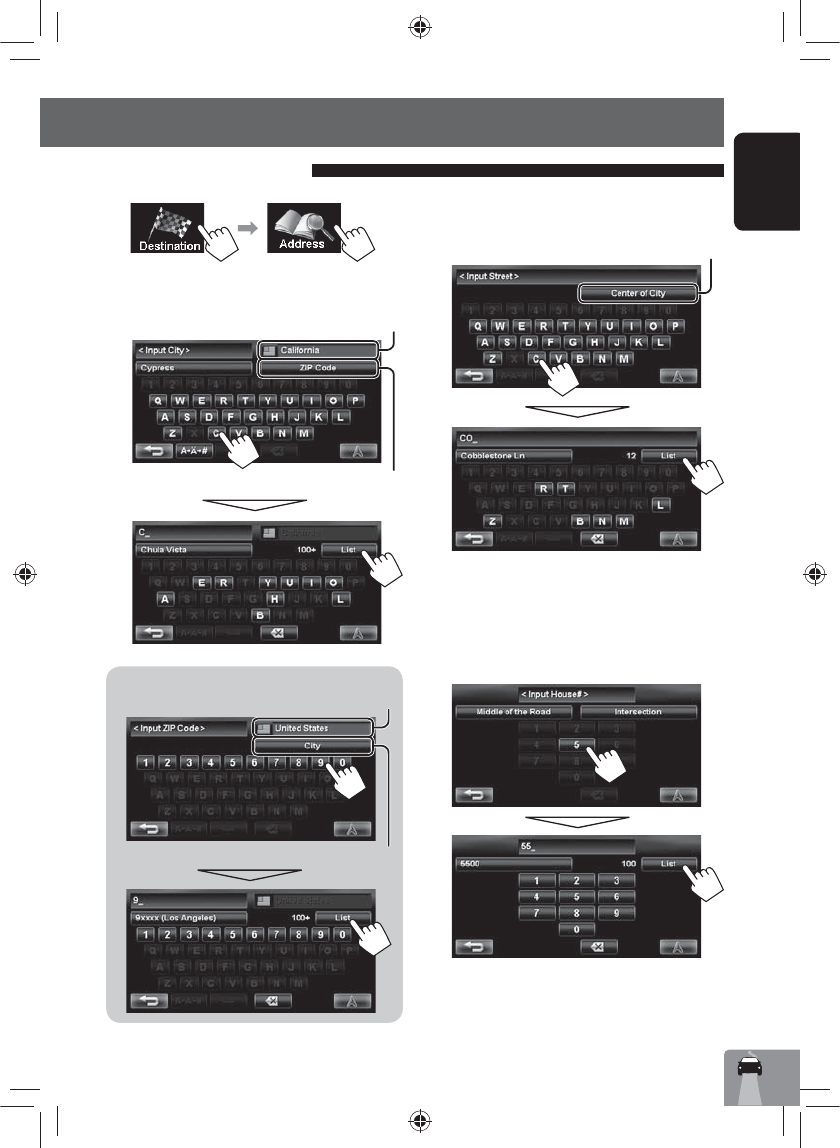
To specify the zip code
21
ENGLISH
1
2 Enter the city name, then select from the list
(☞ page 20).
Changes State or Province
Specifies the zip code (☞ “To specify the zip code” below)
Continued on the next page
Returns to the city input screen
Changes country
Searching for a place
By address <Address>
3 Enter the street name, then select from the
list (☞ page 20).
4 Enter the house number, then select from
the list (☞ page 20).
• If no data of house number for the selected
street is available in the database, select
[Middle of the Road] or [Intersection].
Selects the center of the city (Then, go to step 5.)
EN_KW-NT30_50[J].indb 21
EN_KW-NT30_50[J].indb 21
1/31/2011 3:24:10 PM
1/31/2011 3:24:10 PM

To select the center of the street or intersection
on the street
22
ENGLISH
5
Guidance starts.
• To cancel guidance, ☞ page 29.
• To set the selected position as via point, ☞ page 28.
• To change route options, ☞ page 29.
• For details about the search result screen,
☞ page 18.
Searching for a place
Specifies the crossing street to
select intersection on the street
Selects the center of the street
By telephone number
<Phone>
1
2 Enter the telephone number, then select
from the list (☞ page 20).
The search result is displayed.
Guidance starts.
• To cancel guidance, ☞ page 29.
• To set the selected position as via point, ☞ page 28.
• To change route options, ☞ page 29.
• For details about the search result screen,
☞ page 18.
Changes country
EN_KW-NT30_50[J].indb 22
EN_KW-NT30_50[J].indb 22
1/31/2011 3:24:11 PM
1/31/2011 3:24:11 PM
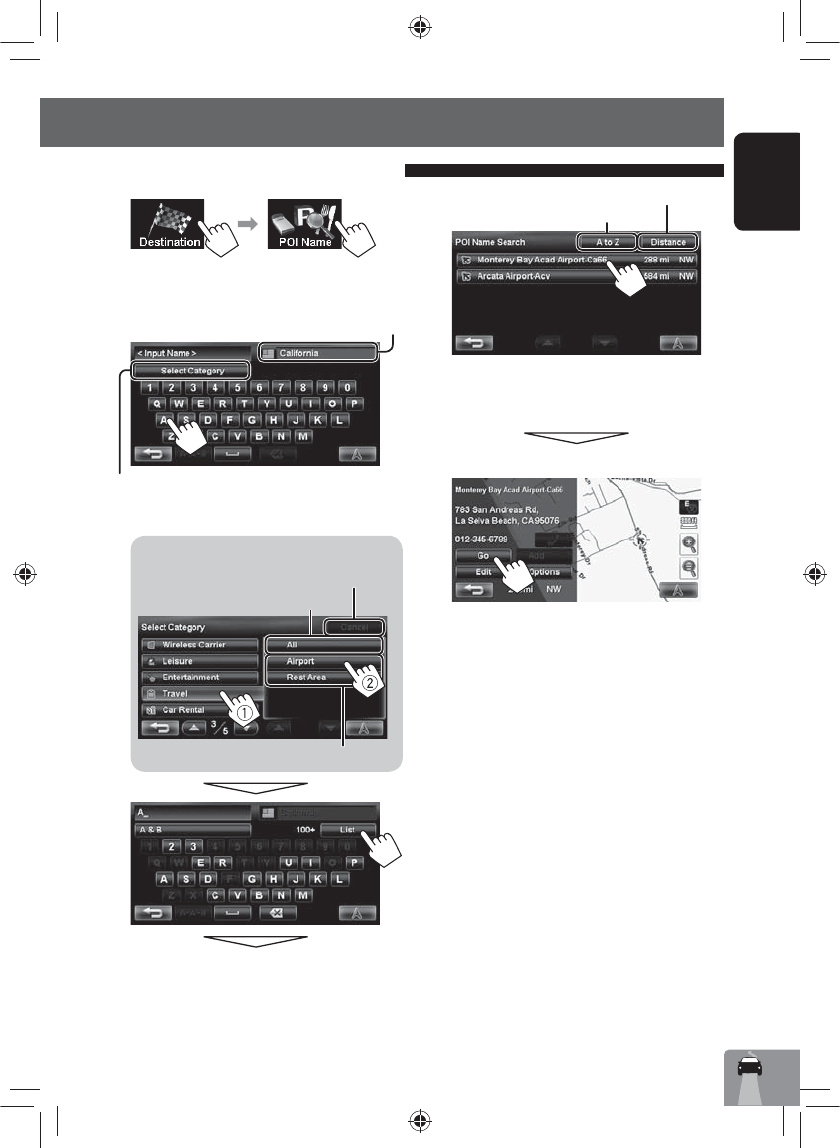
To specify the category and sub-category
23
ENGLISH
Searching for a place
1
2 Enter the POI name, then select from the list
(☞ page 20).
From the list of POI <POI Name>
The System displays up to 100 POIs.
When searching from a large number of items, it may
take some time for the search results to be displayed.
The search result is displayed.
Guidance starts.
• To cancel guidance, ☞ page 29.
• To set the selected position as via point, ☞ page 28.
• To change route options, ☞ page 29.
• For details about the search result screen,
☞ page 18.
Lists in alphabetical order
Lists from the nearest
Specifies the category and sub-category (☞ “To specify the
category and sub-category” below)
Changes State or Province
Selects all sub-categories
Sub-categories
Cancels the selected category
EN_KW-NT30_50[J].indb 23
EN_KW-NT30_50[J].indb 23
1/31/2011 3:24:11 PM
1/31/2011 3:24:11 PM
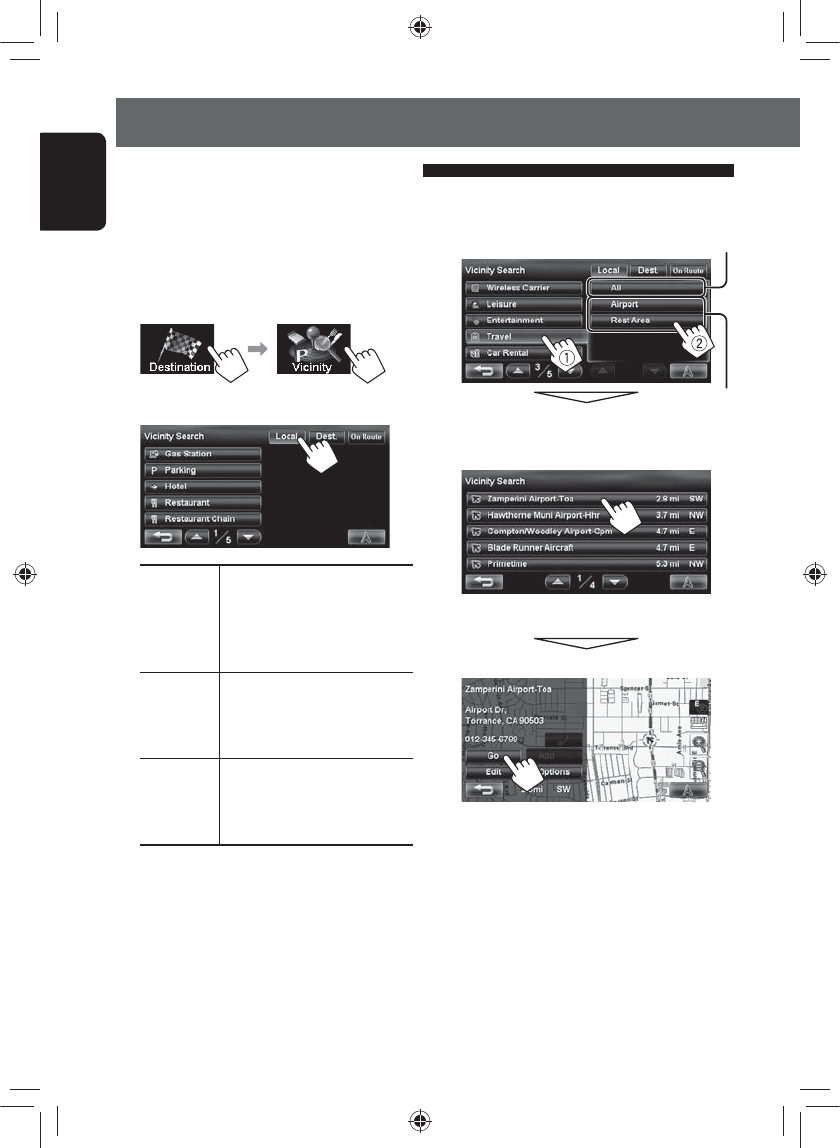
24
ENGLISH
Searching for a place
Selects all sub-categories
Sub-categories
3 Select a category (1), then a sub-category
(2) for the POI.
4 Select a POI from the list.
• The System displays up to 50 POIs.
The search result is displayed.
Guidance starts.
• To cancel guidance, ☞ page 29.
• To set the selected position as via point, ☞ page 28.
• To change route options, ☞ page 29.
• For details about the search result screen,
☞ page 18.
The System has a huge database of POIs (Point Of
Interest), such as restaurants, gas stations, hospitals,
etc.
You can search for a POI around the place where you are
now. While guided, you can also search for a POI near
the destination or along the route.
1
2 Select the area to search.
Local Within 12.5 mi (20 km) of your
current position or the position
selected on the map. If no POI
is found in this area, the System
expands the area to search.
Dest. Within 12.5 mi (20 km) of the
destination. If no POI is found in
this area, the System expands the
area to search.
On Route • On freeway: 180 mi (300 km)
along the route you are taking.
• Others: 15 mi (25 km) along the
route you are taking.
POI near a place/route <Vicinity>
“Searching...”
EN_KW-NT30_50[J].indb 24
EN_KW-NT30_50[J].indb 24
1/31/2011 3:24:12 PM
1/31/2011 3:24:12 PM
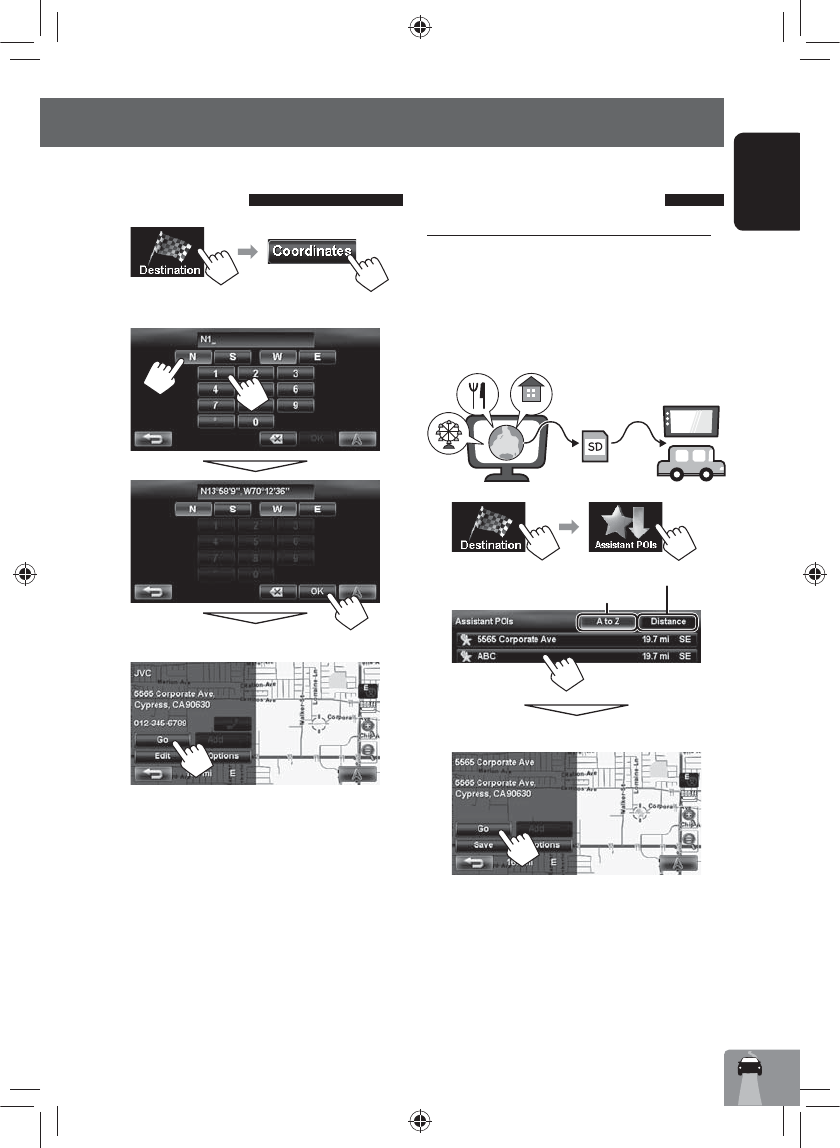
25
ENGLISH
By coordinates
<Coordinates>
1
2 Enter the latitude and the longitude.
The search result is displayed.
Guidance starts.
• To cancel guidance, ☞ page 29.
• To set the selected position as via point, ☞ page 28.
• To change route options, ☞ page 29.
• For details about the search result screen,
☞ page 18.
Searching for a place
From the list of POIs imported by
yourself <Assistant POIs>
Importing POI information on Google Maps
You can import POI information on Google Maps
through an SD card.
For details about Street Director Assistant, visit <http://
www.jvc.co.jp/english/car/> (English website only).
• When the SD card is ejected, the imported POI cannot
be used.
1
2
The search result is displayed.
Guidance starts.
• To cancel guidance, ☞ page 29.
• To set the selected position as via point, ☞ page 28.
• To change route options, ☞ page 29.
• For details about the search result screen,
☞ page 18.
Lists in alphabetical order
Lists from the nearest
EN_KW-NT30_50[J].indb 25
EN_KW-NT30_50[J].indb 25
1/31/2011 3:24:12 PM
1/31/2011 3:24:12 PM
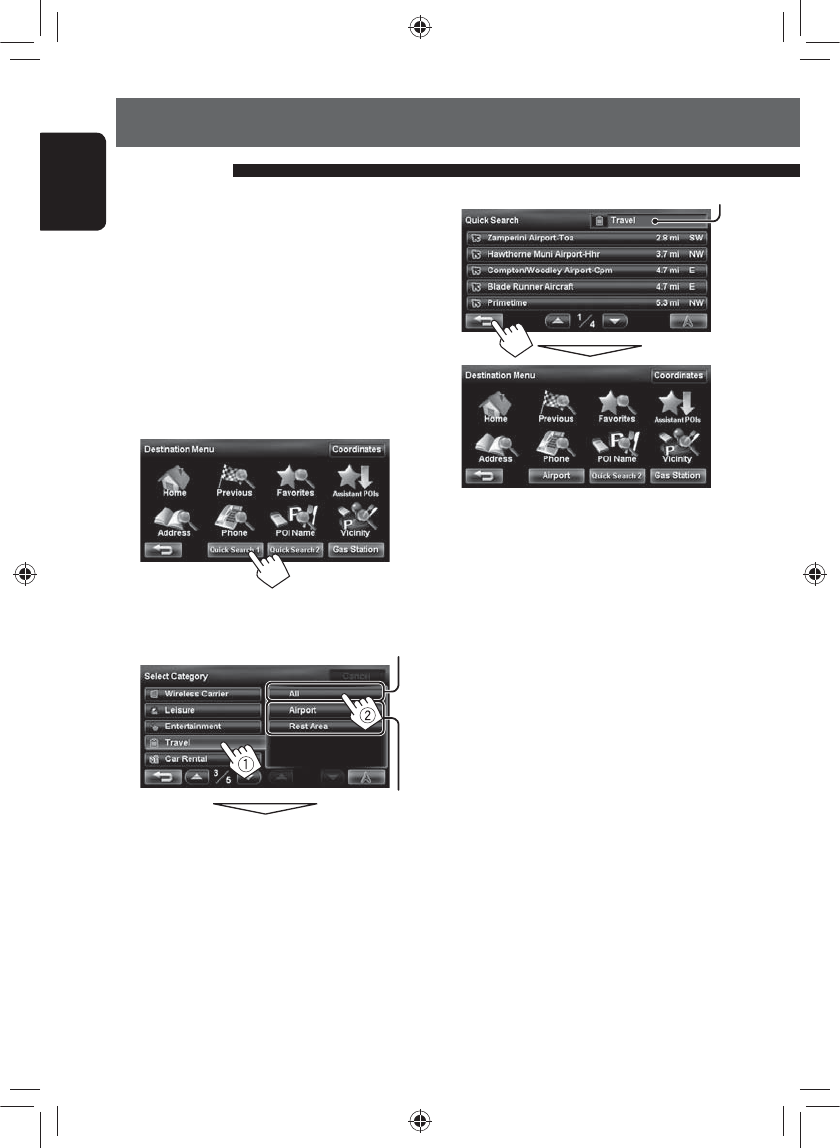
Tentative
26
ENGLISH
Searching for a place
Quick Search
You have three [Quick Search] buttons in
<Destination Menu>. You can assign a POI category
to each button. When you press one of the buttons, the
System searches for a POI of the registered category.
• [Gas Station] is registered to one of the three
buttons when shipped from the factory. You can also
change the registered category of this button.
To register a category to the buttons
1 Select one of the [Quick Search] buttons to
register the category.
2 Select a category (1), then a sub-category
(2) of the POI.
The search for the selected category starts to
register it to the [Quick Search] button.
Selects all sub-categories
Sub-categories
3
4 Repeat steps 1 to 3 until three categories are
registered.
The selected category (or sub-category) name is
assigned to the button.
• The selected category is registered to the [Quick
Search] button even if you cancel the searching
before the search is completed.
Registered category
EN_KW-NT30_50[J].indb 26
EN_KW-NT30_50[J].indb 26
1/31/2011 3:24:13 PM
1/31/2011 3:24:13 PM
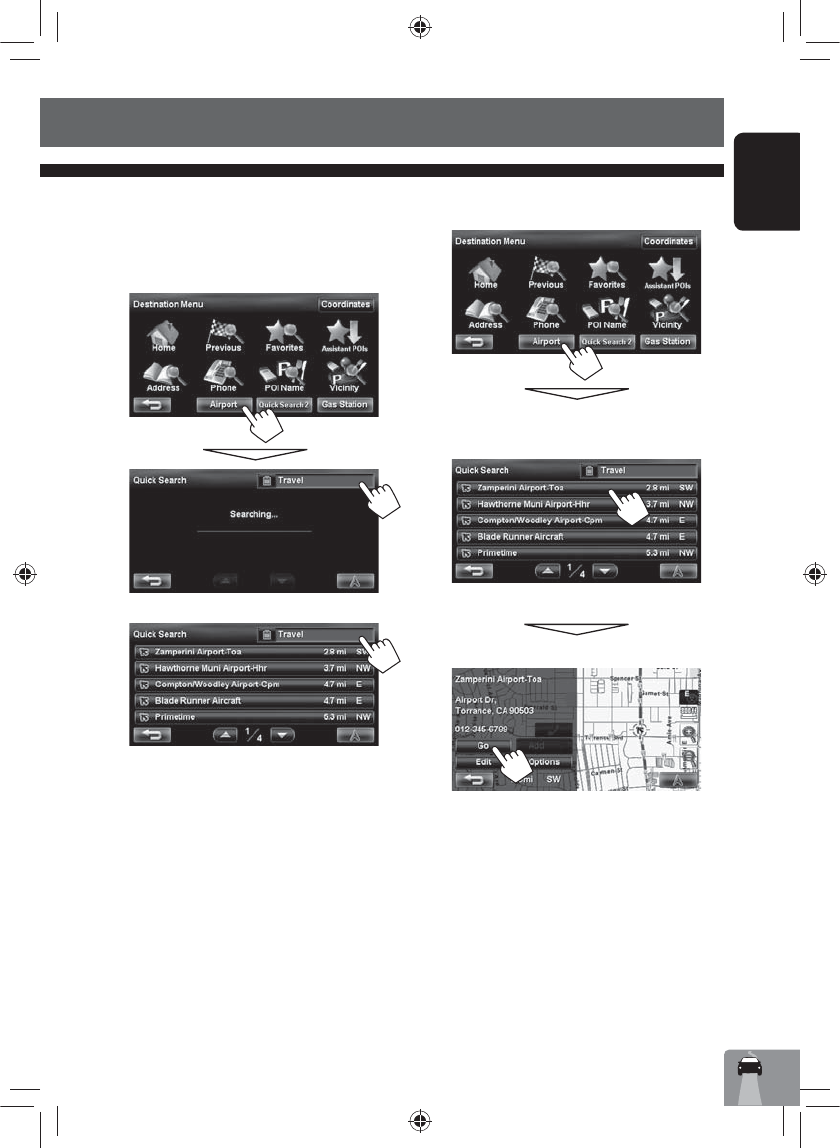
27
ENGLISH
To change a category assigned to the
[Quick Search] button
1 Select one of the [Quick Search] buttons
whose category you want to change.
2 Perform steps 2 and 3 of “To register a
category to the buttons” (☞ page 26).
or
To use Quick Search
1
2 Select a POI from the list.
• The System displays up to 50 search results.
The search result is displayed.
Guidance starts.
• To cancel guidance, ☞ page 29.
• To set the selected position as via point, ☞ page 28.
• To change route options, ☞ page 29.
• For details about the search result screen,
☞ page 18.
“Searching...”
Searching for a place
EN_KW-NT30_50[J].indb 27
EN_KW-NT30_50[J].indb 27
1/31/2011 3:24:13 PM
1/31/2011 3:24:13 PM
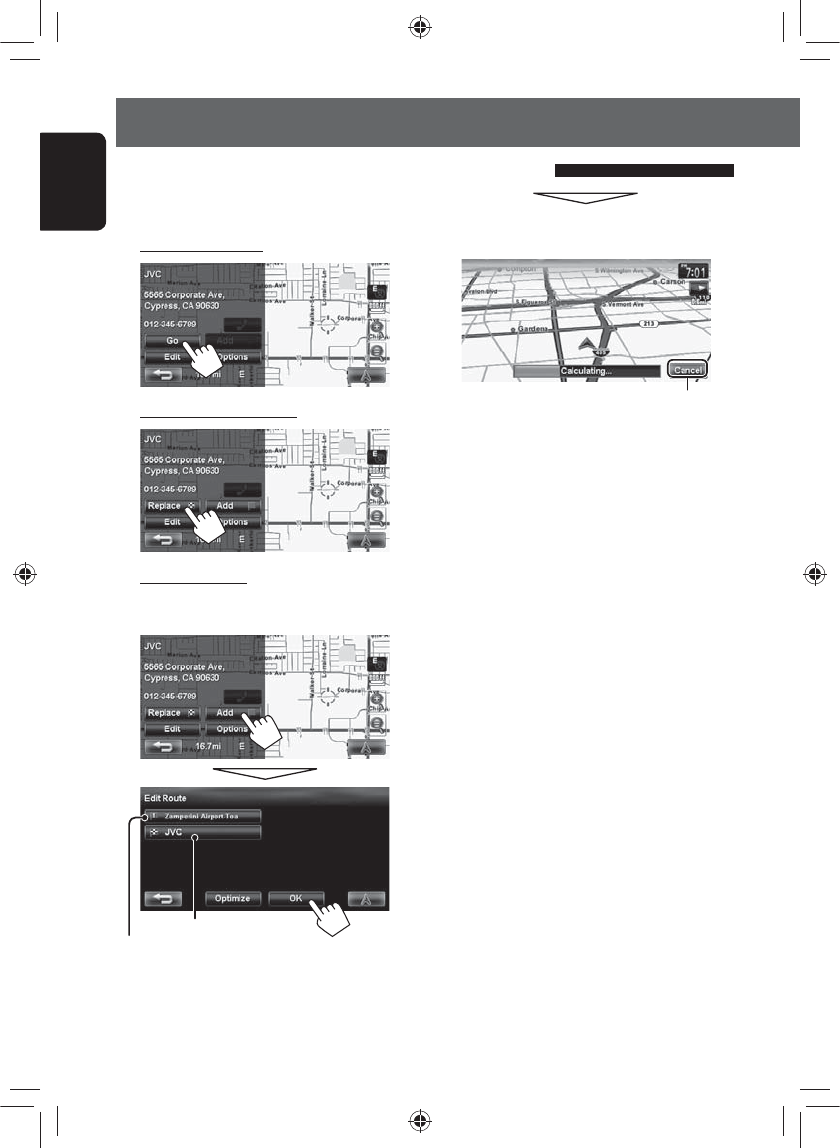
28
ENGLISH
Cancels the calculation
How you are guided
Via point
Destination
1 Select a destination or via point. (☞ pages 18
to 27)
2 To set as destination
To change the destination
To set as via point
You can add the via points only after selecting your
destination.
• You can select up to four via points.
• For editing your route, ☞ page 32.
The System starts calculating the route to the selected
destination, and guidance starts.
To cancel guidance, ☞ page 29.
Starting guidance to the destination or via point
EN_KW-NT30_50[J].indb 28
EN_KW-NT30_50[J].indb 28
1/31/2011 3:24:14 PM
1/31/2011 3:24:14 PM
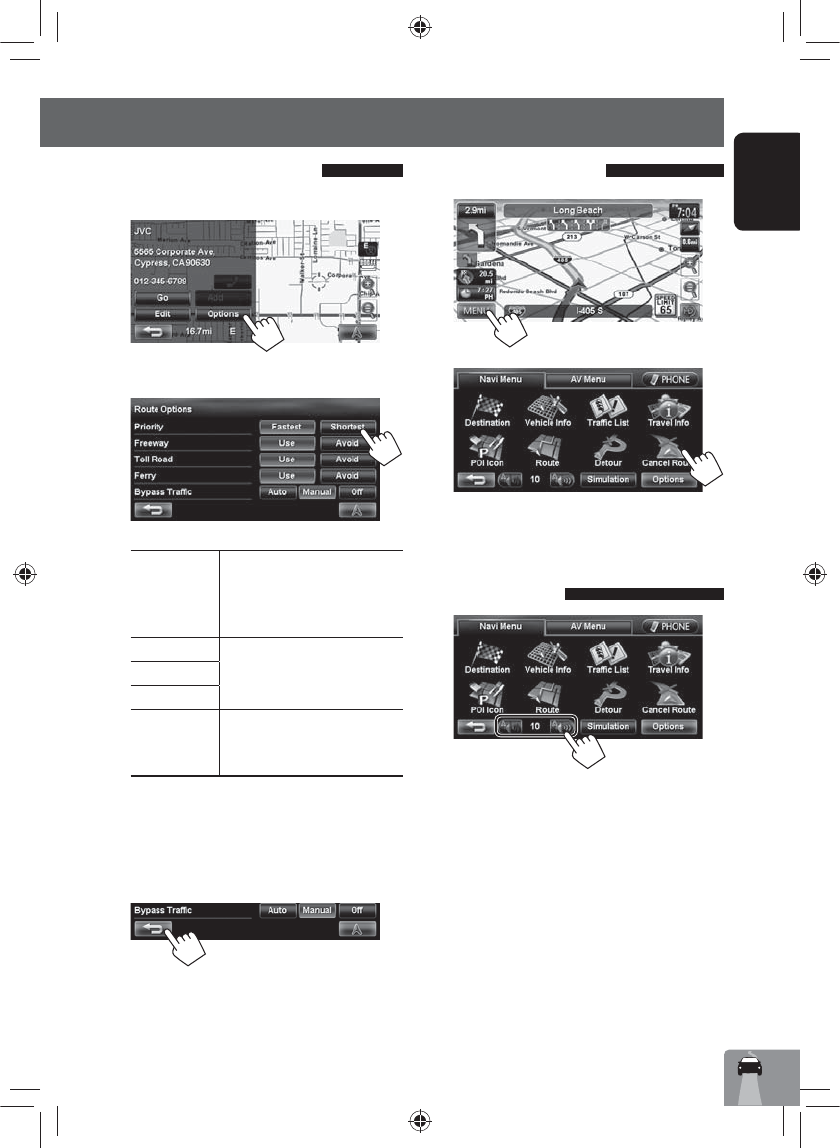
29
ENGLISH
Changing route options
1 On the search result screen:
2 Set options.
Priority Select the priority for route
calculation ([Fastest]: fastest
route/[Shortest]: shortest
route).
Freeway Select whether to use ([Use]) or
avoid ([Avoid]) these types of
options to go to the destination.
Toll Road
Ferry
Bypass Traffic
(Only for KW-
NT50HDT)
Select the route calculation
method with traffic information.
(☞ page 35)
• You can also change these settings through the
navigation menu (<Options> - <Route>,
☞ page 40).
• The settings are effective next time the System
calculates a route.
3
Canceling guidance
1
2
A confirmation message appears.
Adjusting the volume of the
voice guidance
• About the adjustable volume range, ☞ page 73
(<Amplifier Gain>).
• You can also adjust the volume through the
navigation menu (<Guidance Volume>,
☞ page 40).
How you are guided
EN_KW-NT30_50[J].indb 29
EN_KW-NT30_50[J].indb 29
1/31/2011 3:24:14 PM
1/31/2011 3:24:14 PM
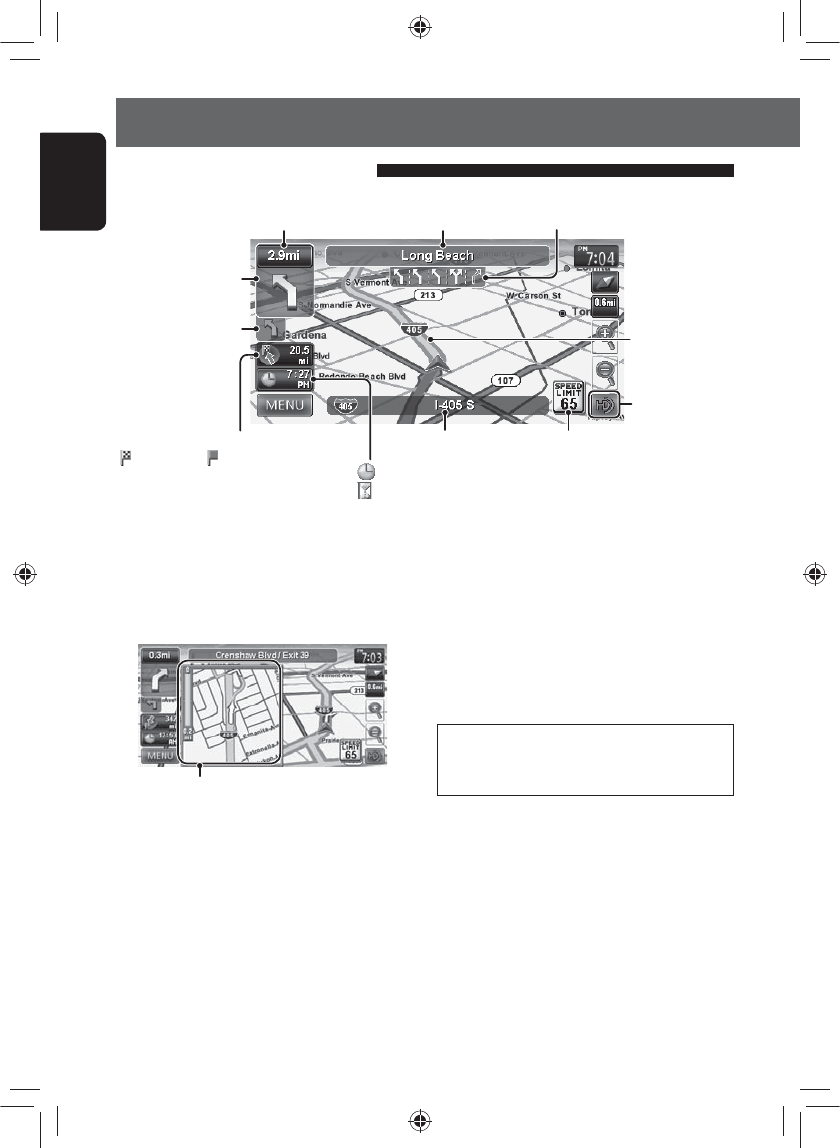
30
ENGLISH
How you are guided
Distance to the next turn
• Press to listen to the last voice guidance again. Next street
Route to take
Guidance at turns
When you approach a turn, the System guides you with voice guidance and indications on the screen.
• Guidance voice comes out only through the front speakers (and the F OUT jacks on the rear).
Direction and distance to the destination
() or a via point ( )
• Press to switch the information
between the final destination and the
nearest via point.
Current street
Lanes to take
(Appears when coming within 3 mi (5 km) of it.)
Next turn to make
The second turn to make
(if any)
: Estimated time of arrival (ETA)
: Remaining time to the selected destination or a via point
• Press to switch the information between estimated time of arrival (ETA)
and remaining time.
Speed limit on the current street
What if I miss a turn?
Don’t worry. The System calculates a new route
quickly.
Magnified map
• You can select whether or not to display the magnified
map through the navigation menu (<Options> -
<Display> - <Magnified View>, ☞ page 41).
To remove the magnified map, touch the map part
on the right side of the screen.
• When you reach the area approximately within 120 ft (40 m) around the destination/via point, the Navigation
System considers you to have reached your destination/via point.
Shows AV control
bar
About route guidance screen
EN_KW-NT30_50[J].indb 30
EN_KW-NT30_50[J].indb 30
1/31/2011 3:24:14 PM
1/31/2011 3:24:14 PM
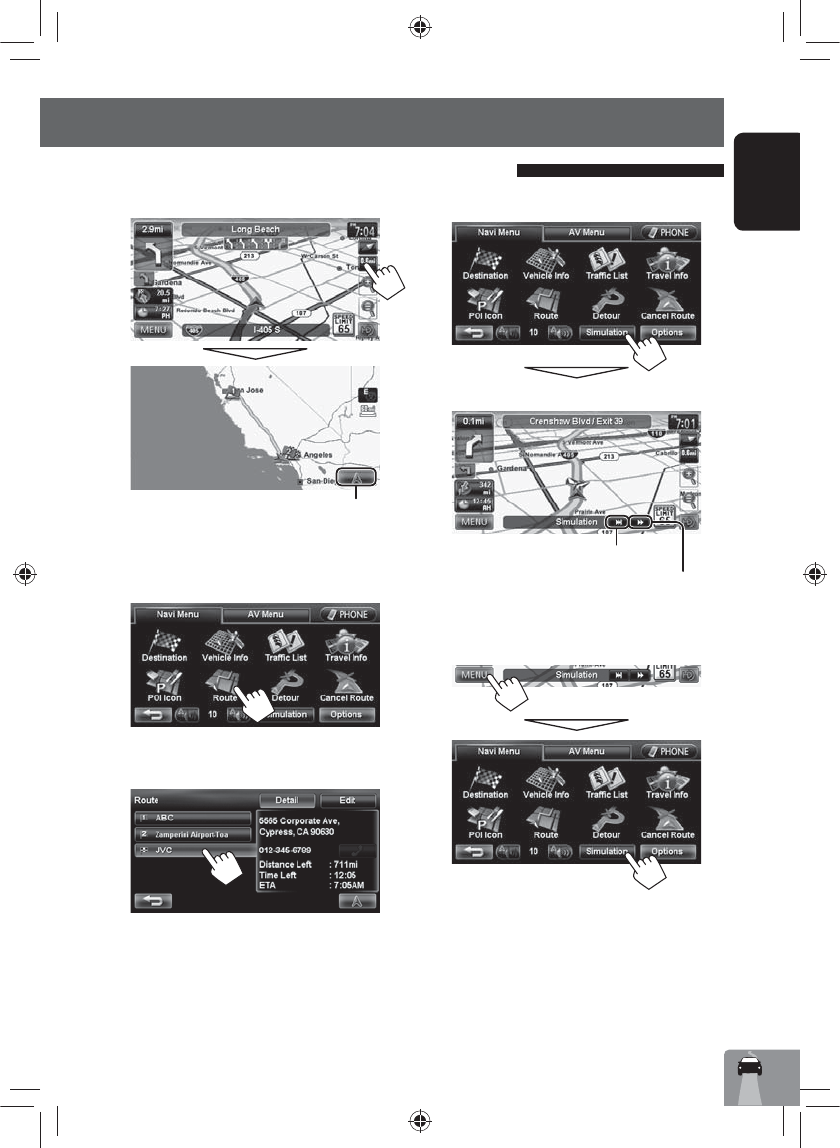
31
ENGLISH
To check the entire route
To check the information on the
destination and via points
1
2 Select a desired point to check its detailed
information.
Getting information on your route and places
To confirm how your trip will go
Drive simulation starts.
To cancel the simulation and resume guidance
A confirmation message appears.
Shows the simulation just before the next turn
Changes the speed of the drive simulation
(normal/faster)
Returns to previous screen
How you are guided
EN_KW-NT30_50[J].indb 31
EN_KW-NT30_50[J].indb 31
1/31/2011 3:24:15 PM
1/31/2011 3:24:15 PM
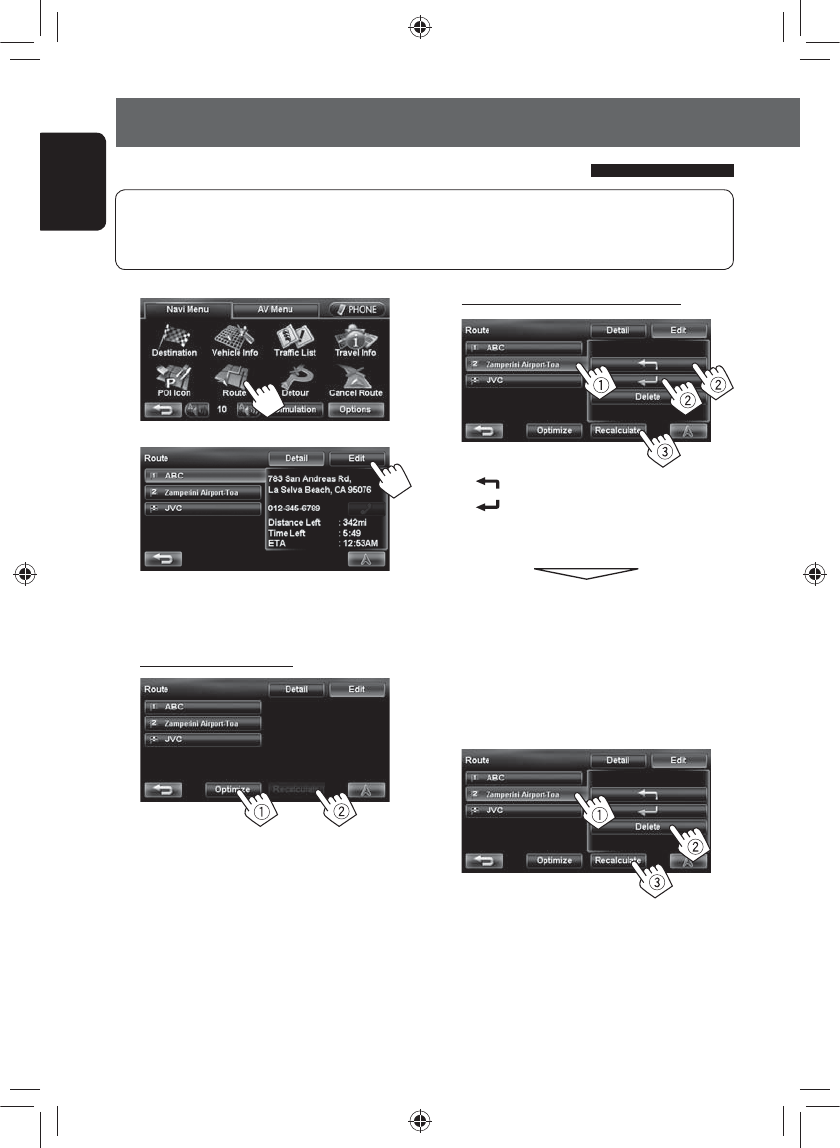
32
ENGLISH
Arranging your route
1
2
3 Change the sequence of the destination/via
points.
To optimize the sequence
• Highways are always used to calculate the route if distance to a destination exceeds a certain distance.
• If the destination cannot be reached without using highways, ferries, or toll roads, they are used to calculate
the route without respect to the <Route> settings. (☞ page 40)
To rearrange the sequence manually
[]: Moves up the order of selected point.
[]: Moves down the order of selected point.
• Repeat 1 and 2 to move other via points
before pressing [Recalculate].
The System starts calculating the new route, and
guidance starts.
To delete a via point
Press [Delete] after selecting the item you want
to delete, then press [Recalculate].
Changing the sequence of the destination/via points
EN_KW-NT30_50[J].indb 32
EN_KW-NT30_50[J].indb 32
1/31/2011 3:24:15 PM
1/31/2011 3:24:15 PM
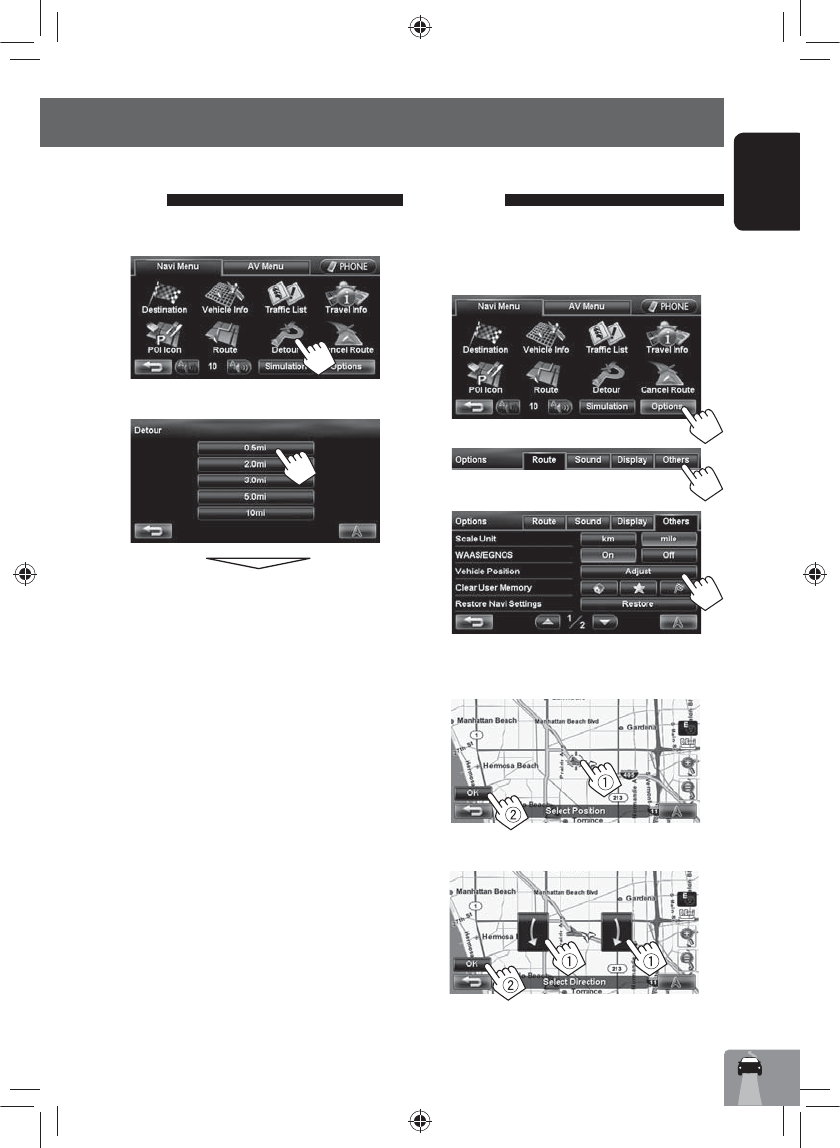
33
ENGLISH
Avoiding a congestion
ahead
If you realize a congestion exists ahead...
1
2 Select the distance to avoid.
A detour is calculated, and guidance starts.
• A detour may not be calculated depending on the
route.
Adjusting the vehicle
position
If you find your current position is displayed on a wrong
place on the map, use this setting to correct your
position.
1
2
3
4 Move the cursor to the position where you
want to set as current position.
5 Adjust the direction.
Arranging your route
EN_KW-NT30_50[J].indb 33
EN_KW-NT30_50[J].indb 33
1/31/2011 3:24:16 PM
1/31/2011 3:24:16 PM
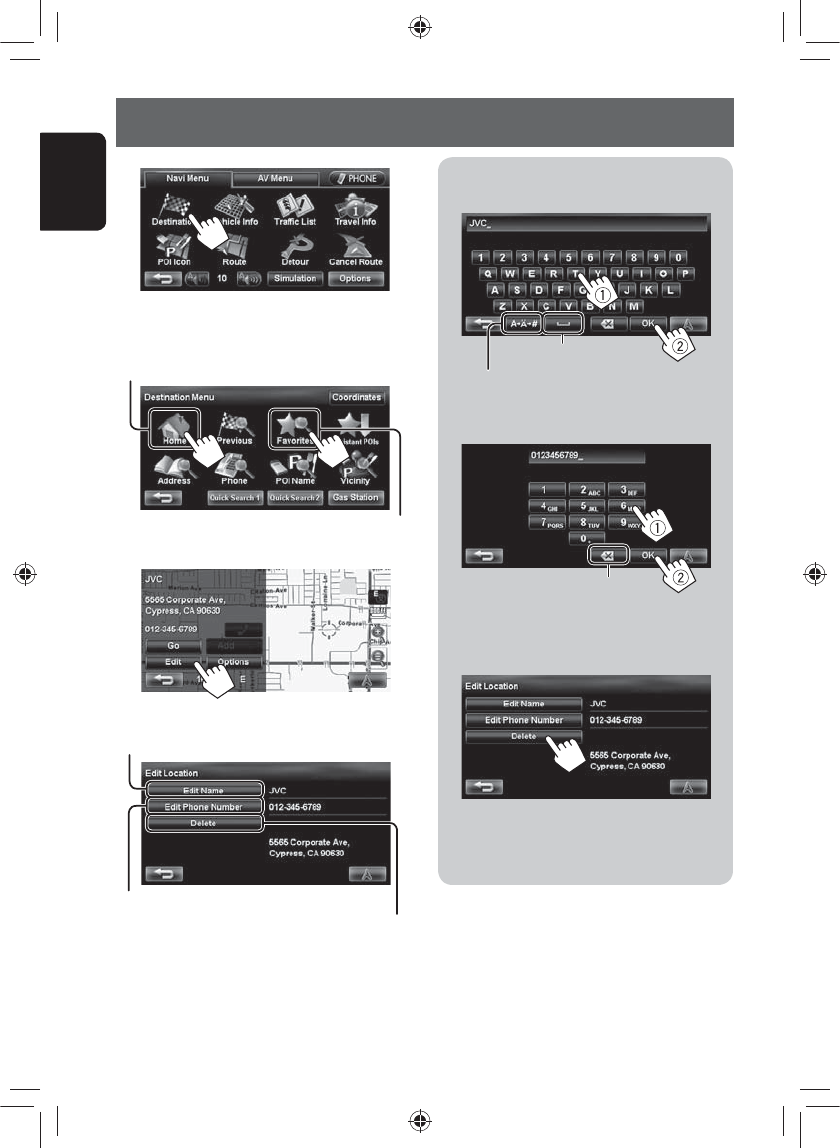
34
ENGLISH
Editing registration of home/favorite points
A To edit the name
• You can use up to 30 characters.
B To edit the phone number
C To delete the registration
A confirmation message appears.
To delete all registered items, ☞ page 39.
1
2 Select a registered point you want to edit.
3
4 Edit the information.
B Displays the phone number editing screen
A Displays the name editing screen
C Deletes the registration
Displays other keyboards
• For available characters, ☞ page 11.
Enters a space
Press: Deletes last character
Hold: Deletes all characters
Selects your home
Displays the favorite point list and select one to
edit on the list.
EN_KW-NT30_50[J].indb 34
EN_KW-NT30_50[J].indb 34
1/31/2011 3:24:16 PM
1/31/2011 3:24:16 PM
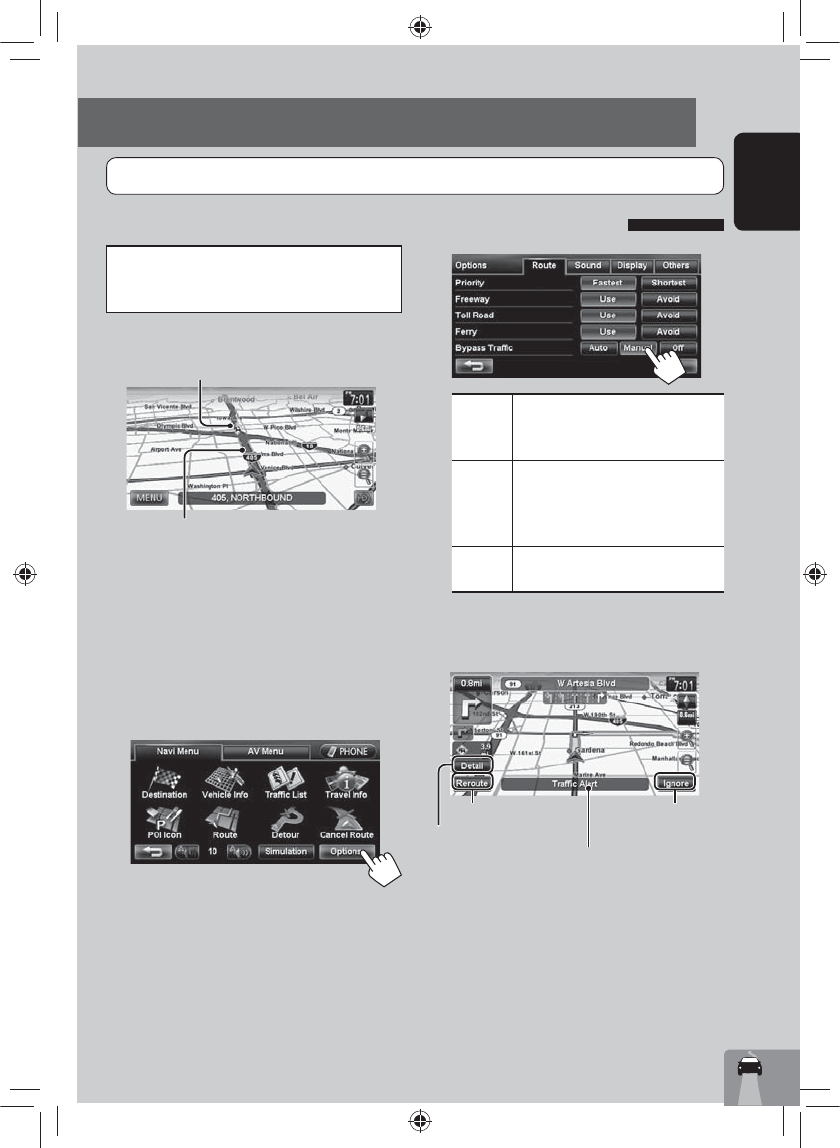
35
ENGLISH
As the traffic information is transmitted by radio
stations, JVC cannot assume responsibility for the
completeness or accuracy of the information.
Traffic information on the map
• Traffic icons are displayed on the map when its scale
is between 80 ft (25 m) and 1.5 mi (2.5 km) with
<Traffic Icon> setting activated (☞ page 41).
How traffic information is reflected in
navigation
The traffic information is reflected in navigation
differently according to <Bypass Traffic> setting.
1
Traffic icon (☞ page 36)
Congestion
Using information service (Only for KW-NT50HDT)
2
Auto The System automatically calculates
a new route when you approach a
traffic event.
Manual Operating buttons appear on
the screen when you approach a
traffic event. Recalculate the route
manually. (☞ below)
Off The System does not take traffic
information into account.
• It may not avoid a congestion even if <Auto> is
selected.
When <Manual> is selected...
• The traffic alert indication disappears while you are
checking due to a change of traffic conditions. The
traffic alert indication also disappears if you do not
confirm the rerouting in one minute.
Shows the detail of the alert
Recalculates the route Ignores the traffic alert
Appears when you approach a traffic
event on your route
Using the traffic information service (Total Traffic HD NET WORK Service)
This function is available on KW-NT50HDT only, not equipped with on KW-NT30HD.
EN_KW-NT30_50[J].indb 35
EN_KW-NT30_50[J].indb 35
1/31/2011 3:24:17 PM
1/31/2011 3:24:17 PM
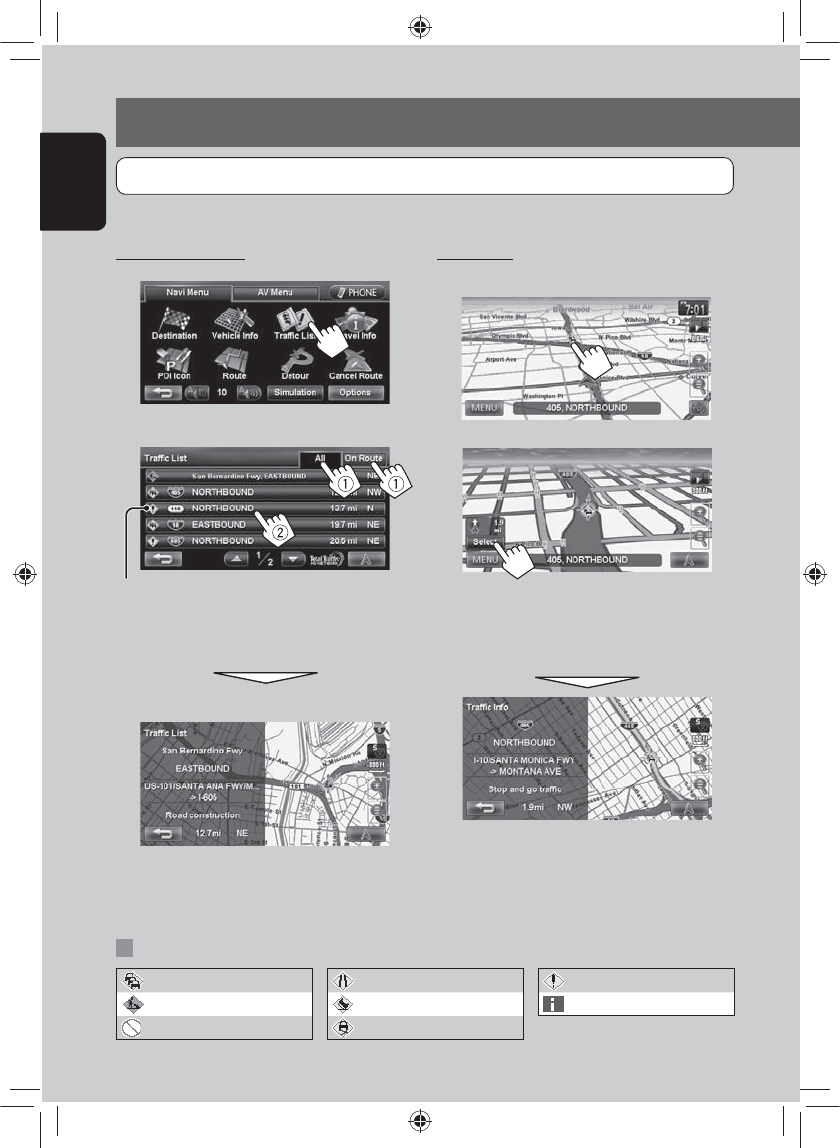
36
ENGLISH
Using information service (Only for KW-NT50HDT)
On the map
1 Touch the traffic icon.
2
• If there are several POIs on the selected position,
select one from the list.
– The list appears only when <POI Icon> is set
to <On>. (☞ page 15)
The icons of traffic alert which are not on your route are
shown in gray when all the information is displayed.
From <Traffic List>
1
2 Select a list (1), then a traffic alert (2).
[All]: Lists all the information.
[On Route]: Lists the information on your route.
Details of the selected alert are displayed.
List of traffic icons
Traffic jam Narrow lanes Other caution event
Roadworks Accident Information
Road is blocked or closed Condition
Checking the traffic information
This function is available on KW-NT50HDT only, not equipped with on KW-NT30HD.
EN_KW-NT30_50[J].indb 36
EN_KW-NT30_50[J].indb 36
1/31/2011 3:24:17 PM
1/31/2011 3:24:17 PM
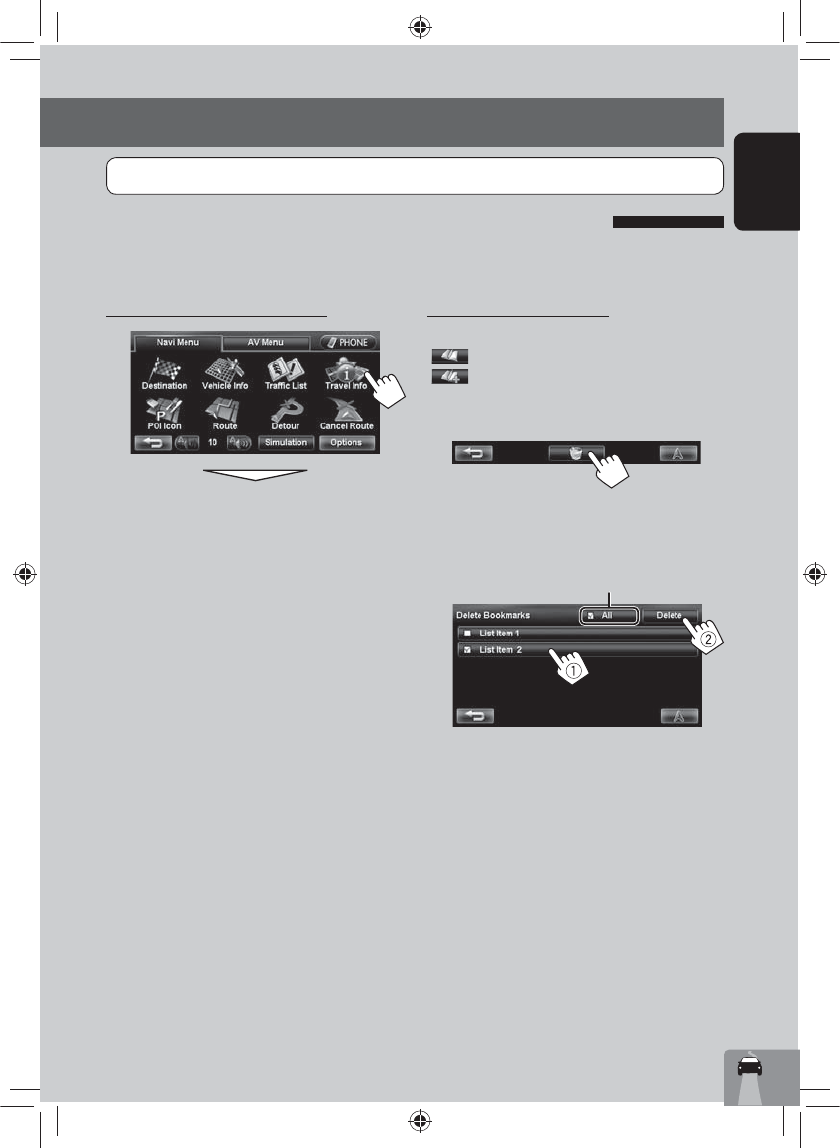
37
ENGLISH
To display the information screen
The information screen appears.
• The contents of the screen depend on the
broadcast.
Selects/deselects all items
Using information service (Only for KW-NT50HDT)
Using the area information service (Total Traffic HD NET WORK Service)
You can use the information service provided by HD Radio broadcasts.
• The contents of the information service depends on the HD Radio station.
To bookmark favorite items
You can store favorite items on the bookmark list.
[]: Displays the bookmark list.
[]: Adds the selected item to the bookmark list.
To delete the item from the bookmark list
1
2 Select items to delete (1), then delete them
(2).
The selected items are marked with "✔."
This function is available on KW-NT50HDT only, not equipped with on KW-NT30HD.
EN_KW-NT30_50[J].indb 37
EN_KW-NT30_50[J].indb 37
1/31/2011 3:24:19 PM
1/31/2011 3:24:19 PM
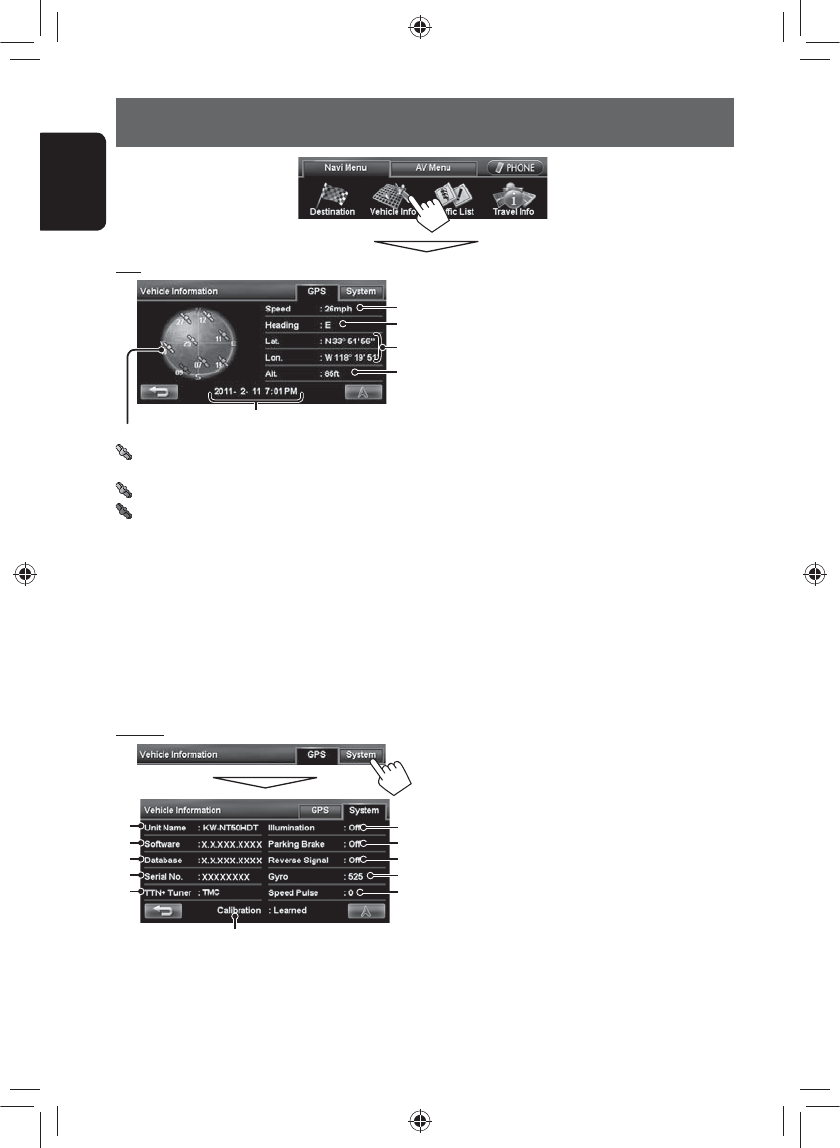
p
6
7
8
9
q
w
e
r
t
5
2
3
4
1
y
38
ENGLISH
Checking the information of the navigation system
8 Version of the map database
9 Serial number
p Connection status of the illumination control lead
<On>: The illumination signal is detected.
q Connection status of the parking brake lead
<On>: The parking brake is engaged.
w Connection status of the reverse gear signal lead
<On>: Reverse gear signal is detected.
• If the rear view screen is displayed when shifting
the gear to the reverse (R) position, the reverse
gear signal is detected (<On>).
e Status of the gyroscope
r Speed pulse rate
t Status of calibration *2 *3
<Processing>: The current position cannot be
determined without data from GPS satellites.
<Learning>: The current position can be
determined even when the System cannot receive
data from GPS satellites.
<Learned>: The current position can be
determined accurately even when the System
cannot receive data from GPS satellites.
y Information service being received
(Traffic or Area information; only for KW-NT50HDT)
*1 These information may not be shown correctly when
the reception of GPS signals is poor.
*2 The calibration does not function without the
connection of GPS antenna and the speed signal
lead. For the connection, ☞ Installation/Connection
Manual (separate volume).
*3 Driving under various conditions completes the
calibration faster. If <Processing> remains on the
screen for long period, check the connection of the
GPS antenna and the speed signal lead.
GPS
1 Current speed *1
2 Direction of the car *1
3 Latitude and longitude of your current position *1
4 Altitude of your current position *1
5 Date/Local time
• When the System cannot receive the GPS signals, the
value of each item above are shown as “- -.”
System
6 Name of the unit
7 Version of the software
Satellites
(Green): Receiving the GPS signals and used for the
positioning.
(Yellow): Receiving the GPS signals.
(Gray): Not receiving the GPS signals.
EN_KW-NT30_50[J].indb 38
EN_KW-NT30_50[J].indb 38
1/31/2011 3:24:19 PM
1/31/2011 3:24:19 PM
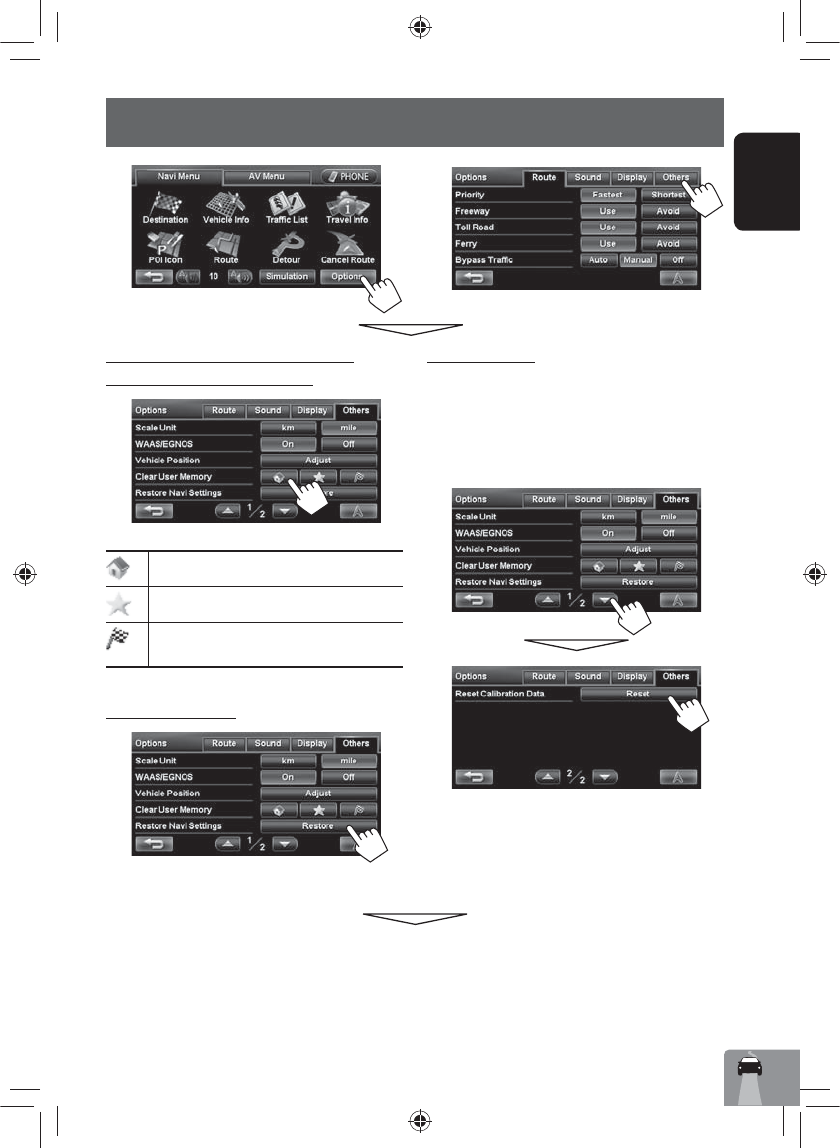
39
ENGLISH
Initializing memories/navigation settings
1 2
Memories of home, favorite points or
previous destination/via points
Deletes your home.
Deletes all favorite points.
Deletes all the places in the list of previous
destinations/via points.
Navigation settings
The initial settings of the navigation menu are restored.
A confirmation message appears.
Calibration Data
The Navigation System is gradually optimized by
automatic calibration.
Reset the calibration data in the following cases:
• When you reinstall the unit in another car.
• When you replace or rotate the tires.
EN_KW-NT30_50[J].indb 39
EN_KW-NT30_50[J].indb 39
1/31/2011 3:24:20 PM
1/31/2011 3:24:20 PM
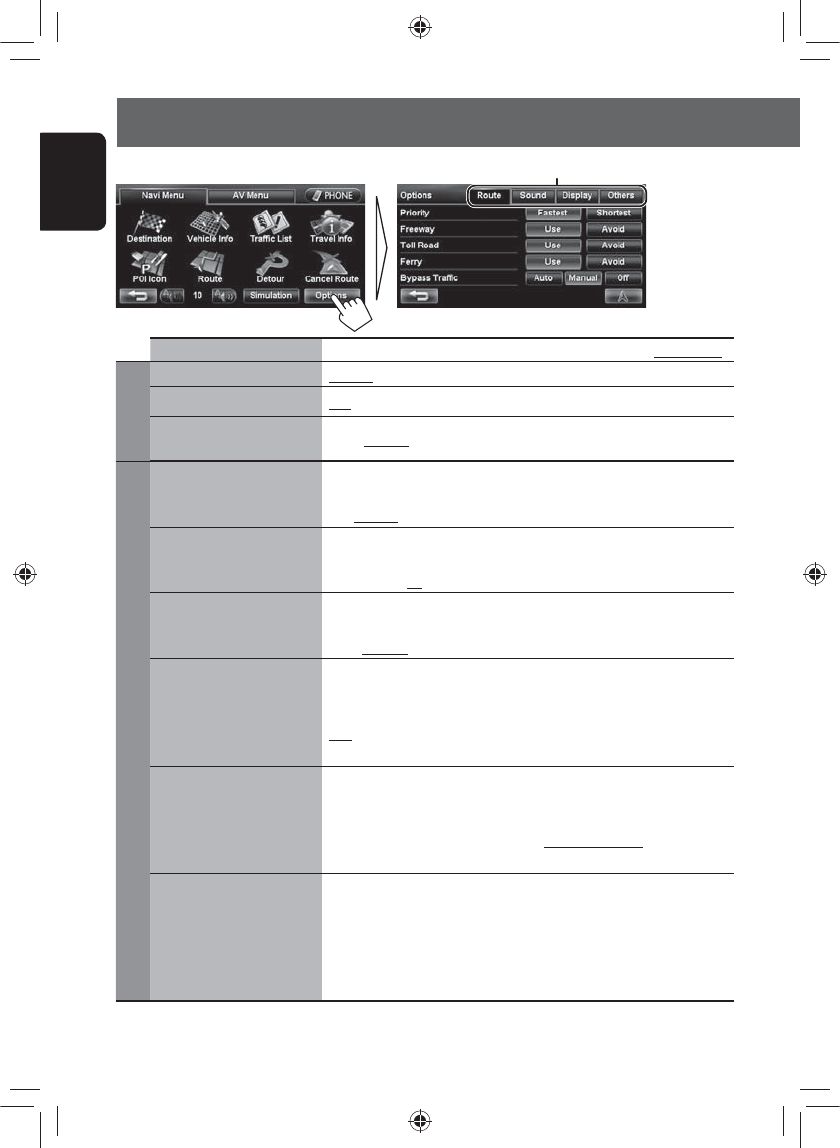
40
ENGLISH
Navi Menu —Options
Menu items Selectable settings Initial: Underlined
Route
Priority Fastest, Shortest (☞ page 29)
Freeway/ Toll Road/ Ferry Use, Avoid (☞ page 29)
Bypass Traffic
(Only for KW-NT50HDT) Auto, Manual, Off (☞ page 35)
Sound
Attention tone* Select the type of attention tone, coming out before the voice guidance by
pressing [2] or [3].
Off, Normal, Prompt, A.I.
Guidance Volume* Adjust the volume of the voice guidance. (The adjustment does not affect
the audio volume.)
0 to 20; Initial 10
Output* Select the guidance output channel (for front channel only). (This setting
does not affect the output balance (Fader setting) of AV source.)
L ch., L+R ch., R ch.
Music Mix You can turn down the volume of the AV source while voice guidance is
produced.
Muting: The AV source sound does not come out.
Att.: The AV source sound is lowered.
Normal: The AV source sound is not affected.
Speed Alert The System sounds an alarm when you surpass the speed limit of the
current road by the set value. Press [+] or [−] to select the value. The unit
(“km/h” or “mph”) follows the <Scale unit> setting. (☞ page 41)
Off, 3mph (5km/h), 6mph (10km/h), 10mph (15 km/h),
15mph (25km/h), 20mph (35km/h)
POI Alert Alert sounds when you approach within 0.2 mi (300 m) of a POI of the
selected category. (You can select any categories from the following; Gas
Station, Parking, Car Rental and Car Dealer & Service.)
• To select categories for POI alert, press [Edit], then select categories and
sub-categories (the selected items are marked with “✔”). To activate
POI alert for selected categories, press [On]. To deactivate it, press [Off].
* When adjusting these items, test tone is produced.
Navigation menu items
Switches the category by pressing the corresponding tab
EN_KW-NT30_50[J].indb 40
EN_KW-NT30_50[J].indb 40
1/31/2011 3:24:20 PM
1/31/2011 3:24:20 PM
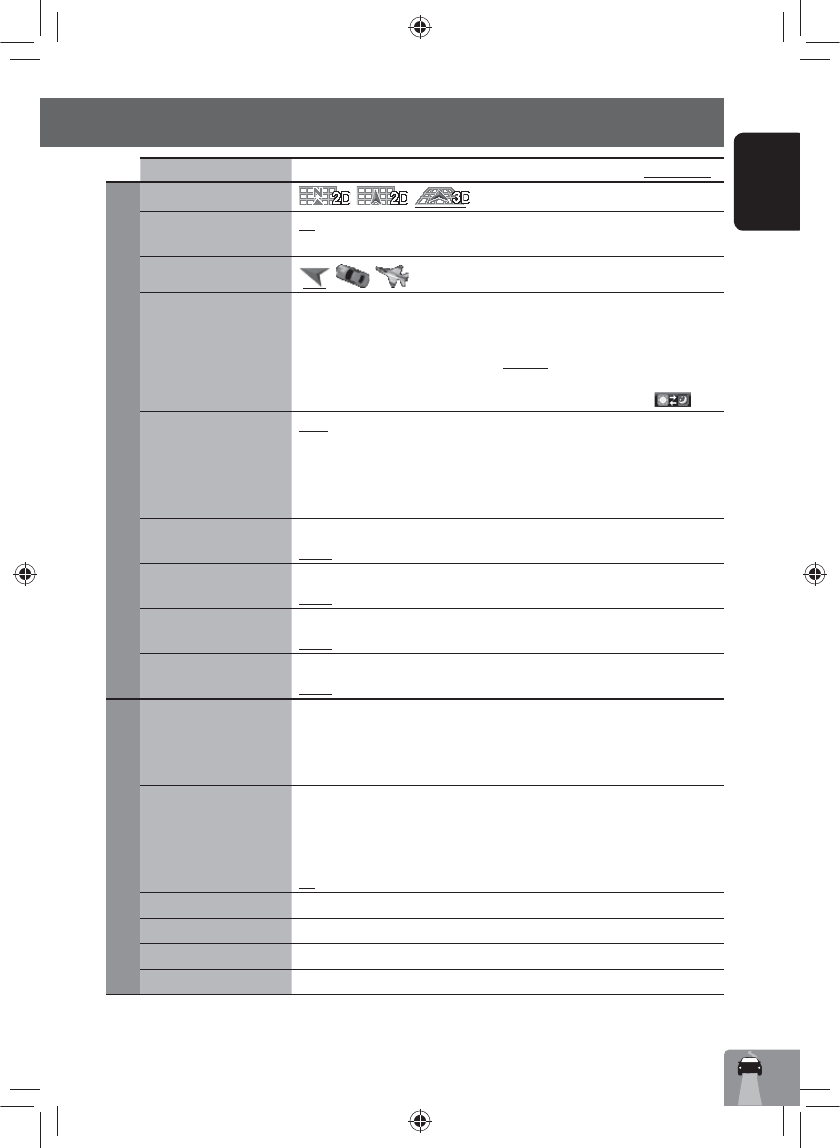
41
ENGLISH
Menu items Selectable settings Initial: Underlined
Display
View Mode , , (☞ page 16)
Magnified View
(☞ page 30)
On: A magnified map is displayed when approaching the next turn.
Off: No magnified map is displayed.
Vehicle Icon , ,
Color Configuration Change the color of the map and the route you take for day time and night
time. Press [Enter] to display the adjustment screen, then change the
following settings:
• Day Map Color/Night Map Color: Normal, Soft, Vivid
• Day Route Color/Night Route Color: Select from 3 colors.
To switch between the day color setting and night color setting, press [ ].
Night Map Mode Auto: Switches to the night screen when you turn on the headlights.
• The illumination control lead connection needs to be completed. (☞
Installation/Connection Manual)
On: Activates night screen.
Off: Deactivates night screen.
Current Street Name Select whether to show or hide the current street name on the map.
Show, Hide (☞ page 15)
Speed Limit Sign Select whether to show or hide the speed limit icon on the map.
Show, Hide (☞ page 15)
One Way Select whether to show or hide the information of one way road on the map.
Show, Hide
Traffic Icon
(Only for KW-NT50HDT)
Select whether to show or hide the traffic icon on the map.
Show, Hide (☞ page 36)
Others
Scale unit Select the measuring units for distance.
• The unit setting you find at your first access to the menu varies depending
on your State/Province selection in the initial settings (☞ page 9).
km, mile
WAAS /EGNOS Select whether to use WAAS and EGNOS to increase the accuracy of
positioning.
• For some areas or conditions, the position accuracy may not be improved
even if <On> is selected. In this case, select <Off>.
On, Off
Vehicle Position ☞ page 33
Clear User Memory ☞ page 39
Restore Navi Settings ☞ page 39
Reset Calibration Data ☞ page 39
Navigation menu items
EN_KW-NT30_50[J].indb 41
EN_KW-NT30_50[J].indb 41
1/31/2011 3:24:21 PM
1/31/2011 3:24:21 PM

42
ENGLISH
• The route calculated by the System is one of the
possible routes to your destination. The route is not
always the most appropriate one.
• If no-exit roads (only entering the rotary from the
roads is allowed) exist on the rotary, the no-exit
roads can neither be shown in the route guidance on
the display nor counted in the route guidance voice
message.
• The following phenomena may occur even if the
System is working correctly...
– It may guide to a closed road or to a route
requiring U-turn.
– It may not guide to your destination if there
is only a narrow road or no road to your
destination.
– It may show a different road name.
– It may not ask you to turn at a junction even if
you need to.
– It may give guidance different from the actual
road conditions.
– It may give incorrect distance information.
Additional information
How you are guided
• If GPS signal reception is poor, navigation guidance
may not be correct.
• The System may not receive GPS signals in the
following places...
– in a tunnel or parking lot in a building
– under an overhead road
– in a place surrounded by high buildings or by
closely standing trees
• Make sure to connect reverse signal lead
(☞ Installation/Connection Manual); otherwise, your
current position may not be displayed correctly.
• The position of your car may not be detected correctly
in the following cases...
– when driving on a road close to the other one
(e.g. a highway and ordinary road running in
parallel)
– when turning at an almost straight fork in the
road
– when driving on a gridiron road
– after taking a ferry, etc.
– when driving on a steep mountain road
– when driving on a spiral road
– when turning left or right after running on a long
straight road
– when driving in a zigzag line on a broad road
– when starting your car shortly after starting the
engine
– when driving for the first time after installing the
unit
– when changing tires or attaching chains on the
tires
– when tire slip occurs continuously and frequently
– after driving on areas other than a road (e.g.
private lands or parking lots)
– after driving in underground or tower type
parking lots
– after rotating your car on a turntable
– after frequent stops and starts in a congestion
– when the accuracy of GPS is deteriorated
intentionally
– when driving on a road constructed recently
EN_KW-NT30_50[J].indb 42
EN_KW-NT30_50[J].indb 42
1/31/2011 3:24:21 PM
1/31/2011 3:24:21 PM
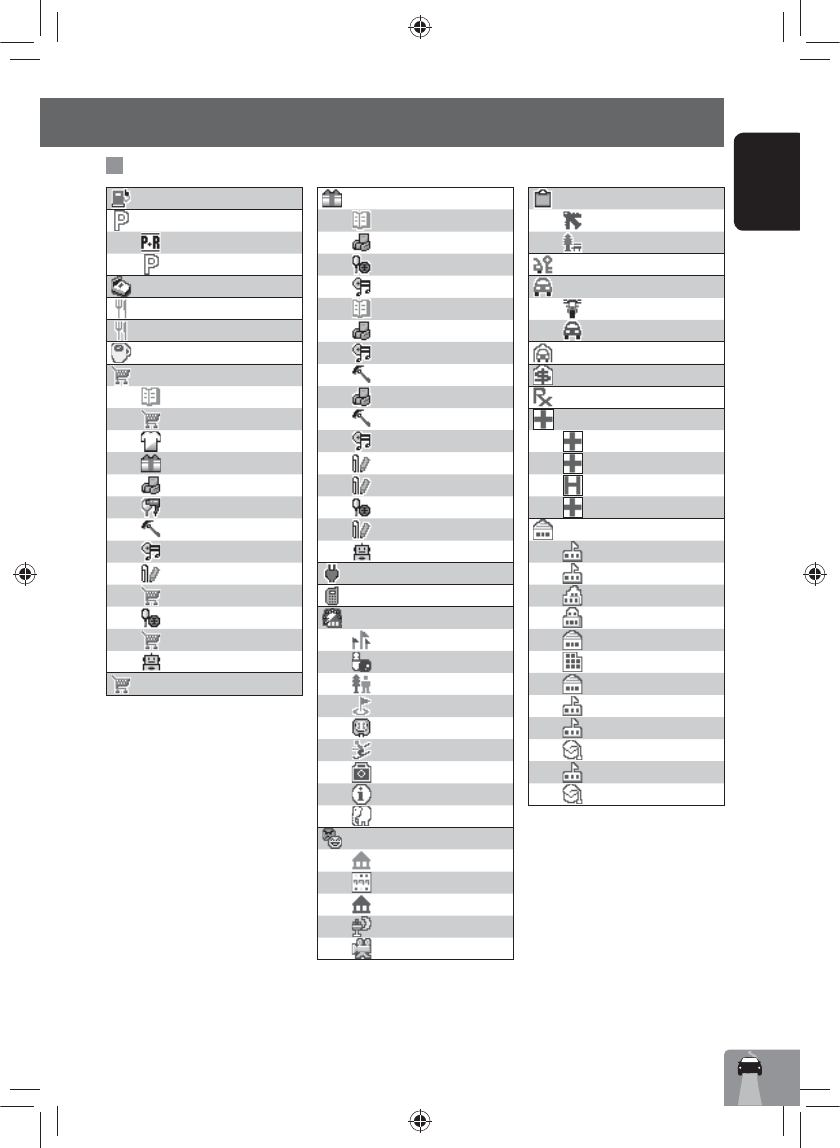
43
ENGLISH
Special store
Barnes & Noble Booksellers
Bed Bath & Beyond
Big5
Blockbuster Video
Borders
Crate & Barrel
Hollywood Video
Home Depot
IKEA
Lowe’s
Movie Gallery
Office Depot
Office Max
Sports Authority
Staples
Toys“r”us
Electronics
Wireless Carrier
Leisure
Amusement Park
Bowling Center
Camping Ground
Golf Course
Recreation Facility
Ski Resort
Tourist Attraction
Travel Agency
Zoo
Entertainment
Art Galleries
Casino
Museum
Night Life
Theater
Gas Station
Parking
Park & Ride
Parking Garage
Hotel
Restaurant
Restaurant Chain
Desserts & Cafe
Shopping
Book Store
Convenience store
Fashion
Flower & Jewelry
Furniture
Hair & Beauty
Home Improvement
Music & Video
Office Supply
Shopping Mall
Sporting Goods
Supermarket
Toys
Department & Grocers
List of POI icons
Travel
Airport
Rest Area
Car Rental
Car Dealer & Service
Motorcycle Dealer
Used Car Dealer
Auto Service shop
Bank
Pharmacy
Medical
Dentist
Emergency
Hospital/Polyclinic
Medical Service
Community
City Hall
Community Center
Court House
Exhibition Center
Government Office
Library
Place of Worship
Police & Fire
Post Office
School
Service
University & College
Additional information
EN_KW-NT30_50[J].indb 43
EN_KW-NT30_50[J].indb 43
1/31/2011 3:24:21 PM
1/31/2011 3:24:21 PM
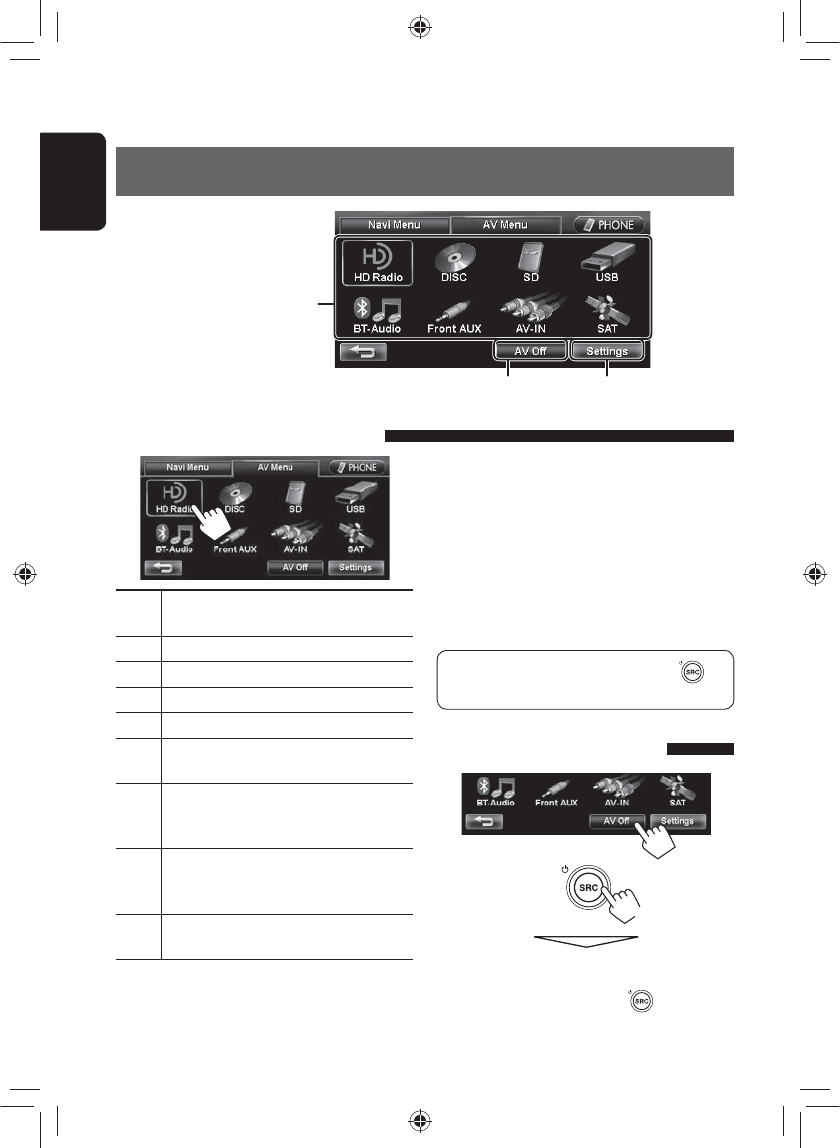
44
ENGLISH
Common operations on AV screens
HD
Radio
Switches to the radio broadcast. (☞ pages 45
to 49)
DISC Plays a disc. (☞ pages 50 to 56)
SD Plays files on an SD card. (☞ pages 57 and 58)
USB *
Plays files on a USB device. (☞ pages 57 and 58)
iPod *Plays an iPod/iPhone. (☞ pages 59 to 65)
BT
Audio
Plays a Bluetooth audio player. (☞ page 85)
Front
AUX
Switches to an external component connected
to the AUX input terminal on the monitor
panel. (☞ page 69)
AV-IN Switches to an external component connected
to VIDEO IN/LINE IN jacks on the rear panel.
(☞ page 69)
SAT Switches to the satellite radio broadcast.
(☞ pages 66 to 68)
* “iPod” is shown as the source instead of “USB” when an
iPod/iPhone is connected.
The iheartradio icon is displayed when the unit is in
iheartradio mode.
or
<AV Menu> screen
Selects the source (☞ below)
Displays <Settings> (☞ pages
72 to 75)
Turns off the AV source (☞ below)
Turning off the AV source
AV source is turned off.
• To activate the AV function, press .
AV Operations
[Hold]
Selecting the playback source
• Available sources depend on the external
components you have connected, media you have
attached and the <Front Aux Input>, <AV
Input> or <Bluetooth Audio> settings you have
made (☞ pages 74 and 75).
• You can erase the clock display while a video source
is played back (such as DVD, video from an external
component, or iPod video). (<Clock on Video/
Screen-Off>, ☞ page 74)
You can also change the source by pressing
repeatedly.
EN_KW-NT30_50[J].indb 44
EN_KW-NT30_50[J].indb 44
1/31/2011 3:24:22 PM
1/31/2011 3:24:22 PM
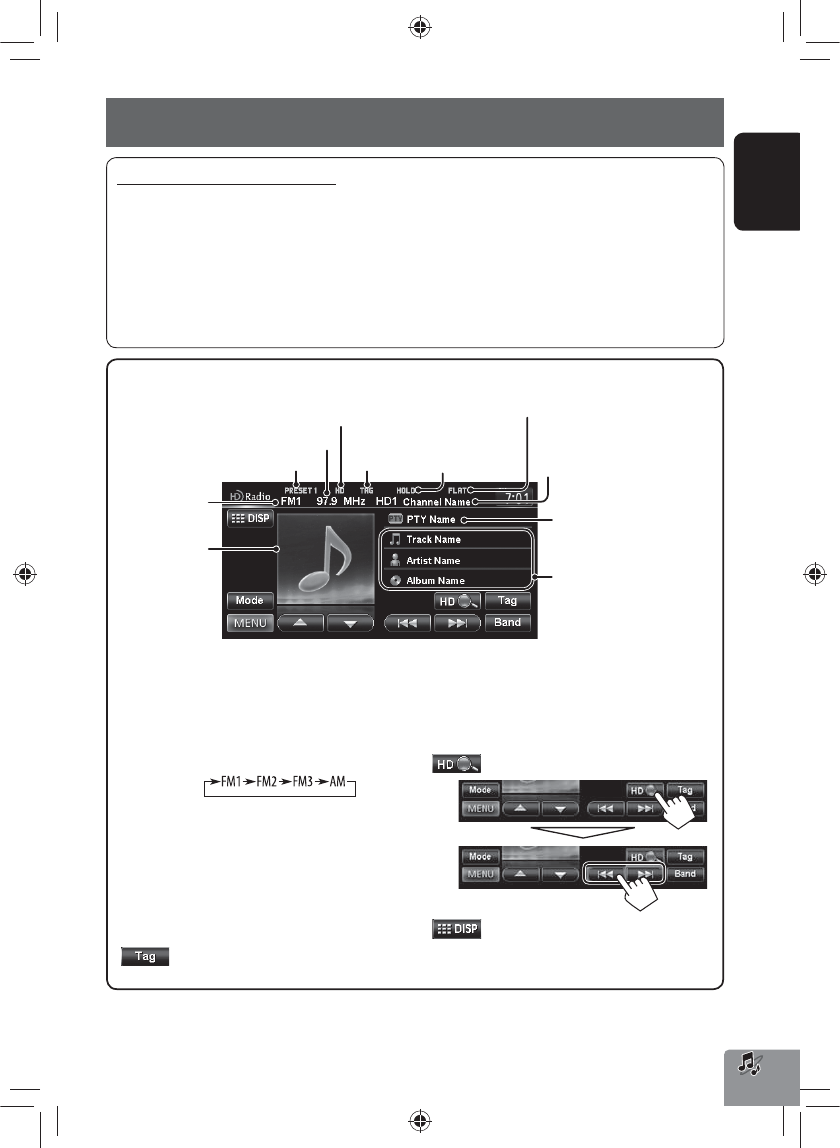
45
ENGLISH
Listening to the HD Radio™ broadcast
Band
Reception indicators
• HD: Lights when receiving an HD Radio broadcast
• ST: Lights when receiving an FM stereo broadcast Sound mode (☞ page 70)
Station frequency currently tuned in
Preset no. Station Call Sign and channel
number for the HD Radio broadcast
Only when receiving HD Radio
station: the song information
currently received
* The station logo is displayed when there is no album artwork.
If there is no artwork or station logo available, the default artwork is displayed.
• When tuning into an HD Radio Multicast sub-channel directly (such as from the preset list), “Linking...”
appears for a while.
[Band] Selects the band.
[4] [¢] • Searches for a station.
Press: Auto search
Hold: Manual search
• Selects a sub-channel when
receiving HD Radio Multicast
channels.
[5] [∞] Selects a preset station.
[ ] ☞ page 48
[ ] Searches for HD Radio stations only.
[ ] Switches between the preset list
screen and tuner source screen.
[Mode]☞ pages 46 to 48
PTY code for the HD Radio
broadcast
TAG indicator
(☞ page 48)
HOLD indicator
(☞ page 46)
What is HD Radio™ broadcasting?
HD Radio stations can deliver high-quality digital sound—AM digital will have FM-like sound quality (in stereo)
and FM digital will have CD-like sound quality—with static-free and clear reception. Furthermore, stations can
offer text and data, such as artist names, song titles, and Program Service Data (PSD).
• HD Radio tuners can also tune in to conventional analog broadcasts.
• Many HD Radio stations offer more than one channel of programming. This service is called multicasting.
• By using PSD, you can easily purchase the songs at iTunes Store.
• To find HD Radio stations in your area, visit <http://www.hdradio.com/>.
Displays the
album artwork or
the station or the
station logo*.
EN_KW-NT30_50[J].indb 45
EN_KW-NT30_50[J].indb 45
1/31/2011 3:24:22 PM
1/31/2011 3:24:22 PM
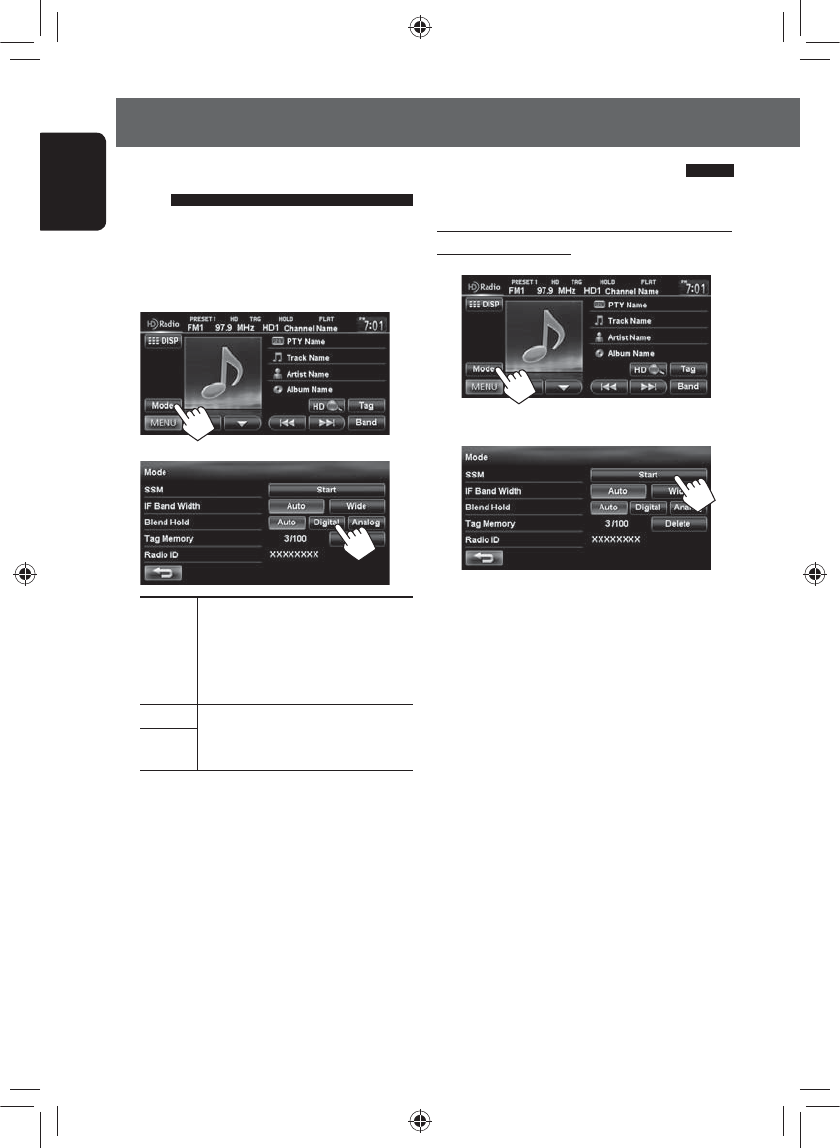
46
ENGLISH
Listening to the HD Radio™ broadcast
Storing stations in memory
You can preset six channels for each band.
Automatic presetting — SSM (Strong-station
Sequential Memory)
1
2
A confirmation message appears.
Local stations with the strongest signals are
searched and stored automatically.
To stop searching, press [4] or [¢].
• During SSM search, all stations including
conventional stations are searched and stored for the
selected band.
Changing HD Radio reception
mode
While receiving an HD Radio broadcast, you can change
the reception mode — digital or analog.
• This setting cannot take effect for the conventional
FM/AM stations.
1
2
Auto Switch between digital and analog
audio automatically.
• In the case when the radio station
forces the reception mode to digital,
the HOLD indicator flashes.
Digital Tuning to digital audio or analog audio
only.
• HOLD indicator lights.
Analog
• The setting automatically returns to <Auto> in the
following cases:
– When you tune in to another broadcast.
EN_KW-NT30_50[J].indb 46
EN_KW-NT30_50[J].indb 46
1/31/2011 3:24:23 PM
1/31/2011 3:24:23 PM
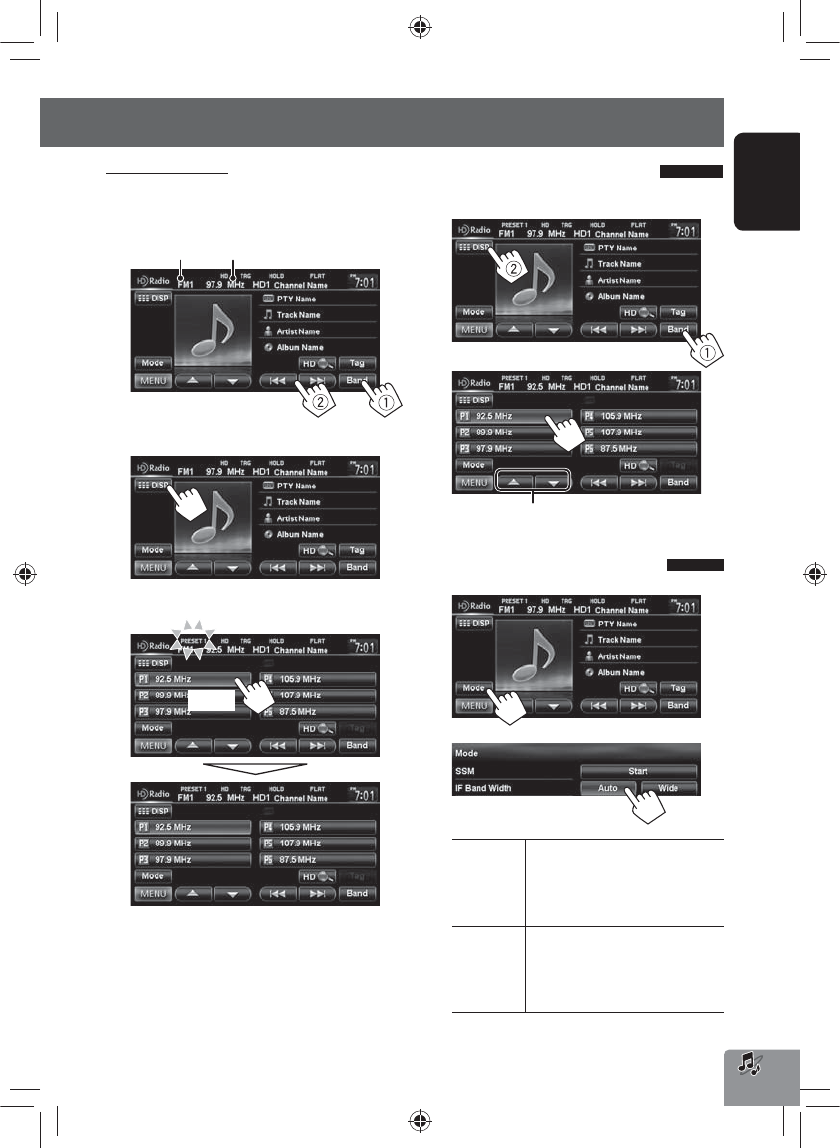
47
ENGLISH
[Hold]
Manual presetting
1 Tune in to a station or channel you want to
preset. (☞ page 45)
2 Display the preset list.
3 Select a preset number.
Band The station frequency you want to preset
Also changes preset stations
Selecting a preset station
1 Display the preset list.
2
Reducing the interference
1
2
Auto Increases the tuner selectivity to
reduce interference noises between
adjacent stations. (Stereo effect may
be lost.)
Wide Subject to the interference from
adjacent stations, but sound quality
will not be degraded and the stereo
effect will remain.
Listening to the HD Radio™ broadcast
EN_KW-NT30_50[J].indb 47
EN_KW-NT30_50[J].indb 47
1/31/2011 3:24:23 PM
1/31/2011 3:24:23 PM
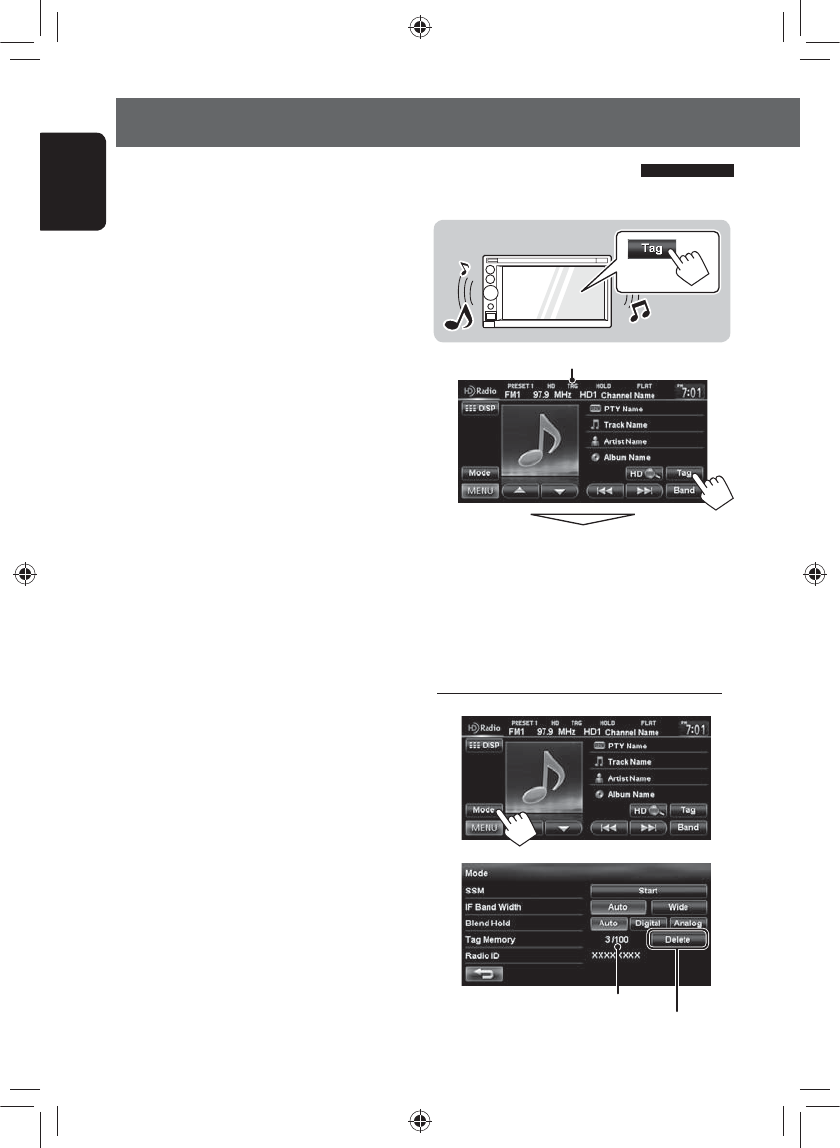
48
ENGLISH
Tagging/purchasing your favorite songs from iTunes Store
Lights up while receiving a song with PSD
Step 1: Tagging the song
The tagged PSD is stored on the unit.
• When iPod/iPhone is connected, the tagged PSD
is automatically transferred to the iPod/iPhone. Go
to “Step 3: Purchasing songs from iTunes Store
(☞ page 49)” to purchase the song.
To check/delete the PSDs stored on the unit
1
2
The number of stored PSDs/max storage
Listening to the HD Radio™ broadcast
While receiving a song with PSD...
Some HD Radio broadcasts provide PSD (Program
Service Data) for a song. You can tag the song and store
its PSD while listening the song.
By using the tagging function, you can easily purchase
the songs from iTunes Store.
Notes on storing tagged PSDs
• When pressing [Tag] within 10 seconds before
or after the PSD changes (while the TAG indicator
flashes), the tags for two songs are stored.
• You cannot tag a song in the following cases:
– When the broadcast currently received does not
support the iTunes Tagging or does not support
PSD.
– When stored PSDs on the unit exceeds 100.
– When the song is already tagged.
– While transferring the tagged PSDs to your iPod/
iPhone is in progress.
• You can enjoy iTunes Tagging with the following
types of iPod/iPhone models:
– iPod classic
– iPod nano (6th Generation)
– iPod nano (5th Generation)
– iPod nano (4th Generation)
– iPod nano (3rd Generation)
– iPod touch (4th Generation)
– iPod touch (3rd Generation)
– iPod touch (2nd Generation)
– iPod touch (1st Generation)
– iPhone 4
– iPhone 3GS
– iPhone 3G
– iPhone
Deletes all PSDs from the unit
EN_KW-NT30_50[J].indb 48
EN_KW-NT30_50[J].indb 48
1/31/2011 3:24:24 PM
1/31/2011 3:24:24 PM
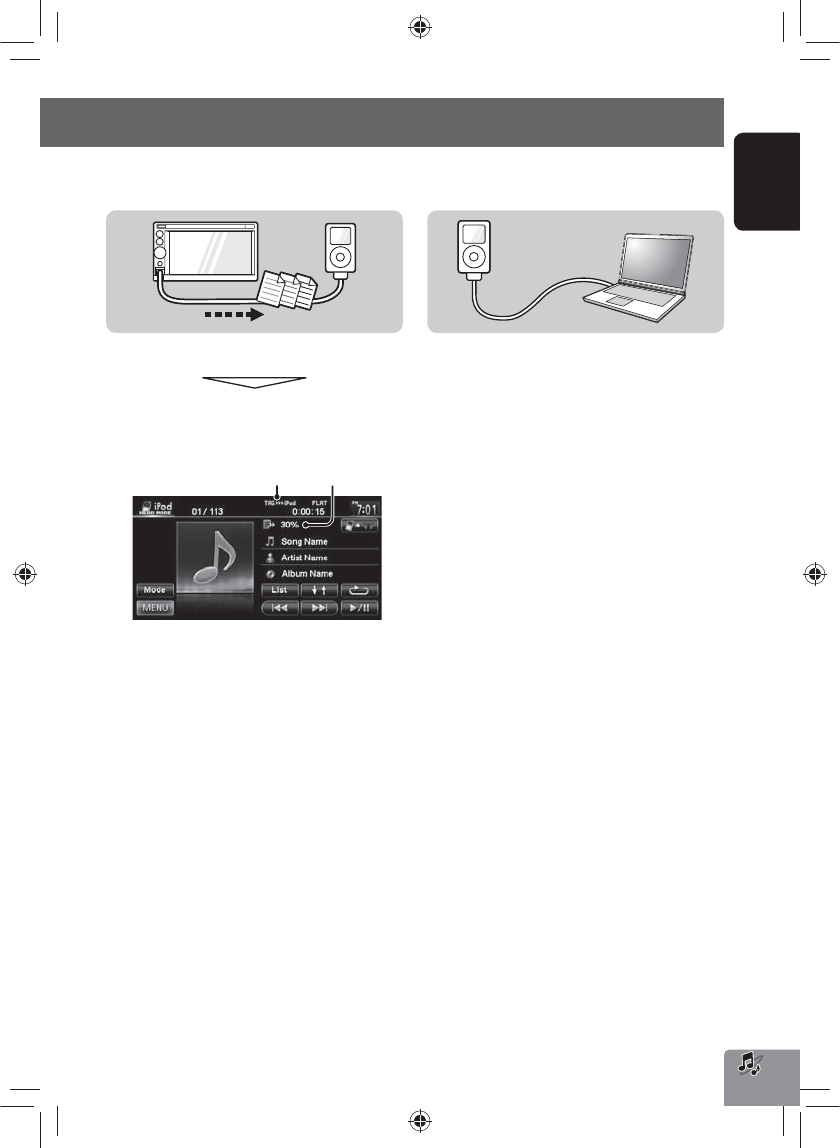
49
ENGLISH
Step 2: Transferring the tagged PSD to
your iPod/iPhone
Connect the iPod/iPhone to the unit (☞ page 59).
The source is changed to “iPod,” and the tagged PSDs
are transferred automatically to your iPod/iPhone.
• After the data transfer is completed, the tagged PSDs
are automatically deleted from the unit.
• Your iPod/iPhone must have 64 KB free space, which
is required for transferring a tagged PSD.
Step 3: Purchasing songs from iTunes
Store
• iTunes 7.4 or later version is required to purchase the
tagged songs.
• For details about iPod/iPhone and iTunes, refer also
to the instructions supplied with the iPod/iPhone or
visit <http://www.apple.com/>.
1 Connect the iPod/iPhone to the PC.
2 Synchronize the iPod/iPhone to the iTunes.
The tagged PSDs are transferred to PC, and iTunes
displays the list of the tagged songs.
• After the data transfer is completed, the stored
PSDs are automatically deleted from the iPod/
iPhone.
Transferring
progress
Appears during
transferring the PSDs
Listening to the HD Radio™ broadcast
EN_KW-NT30_50[J].indb 49
EN_KW-NT30_50[J].indb 49
1/31/2011 3:24:24 PM
1/31/2011 3:24:24 PM
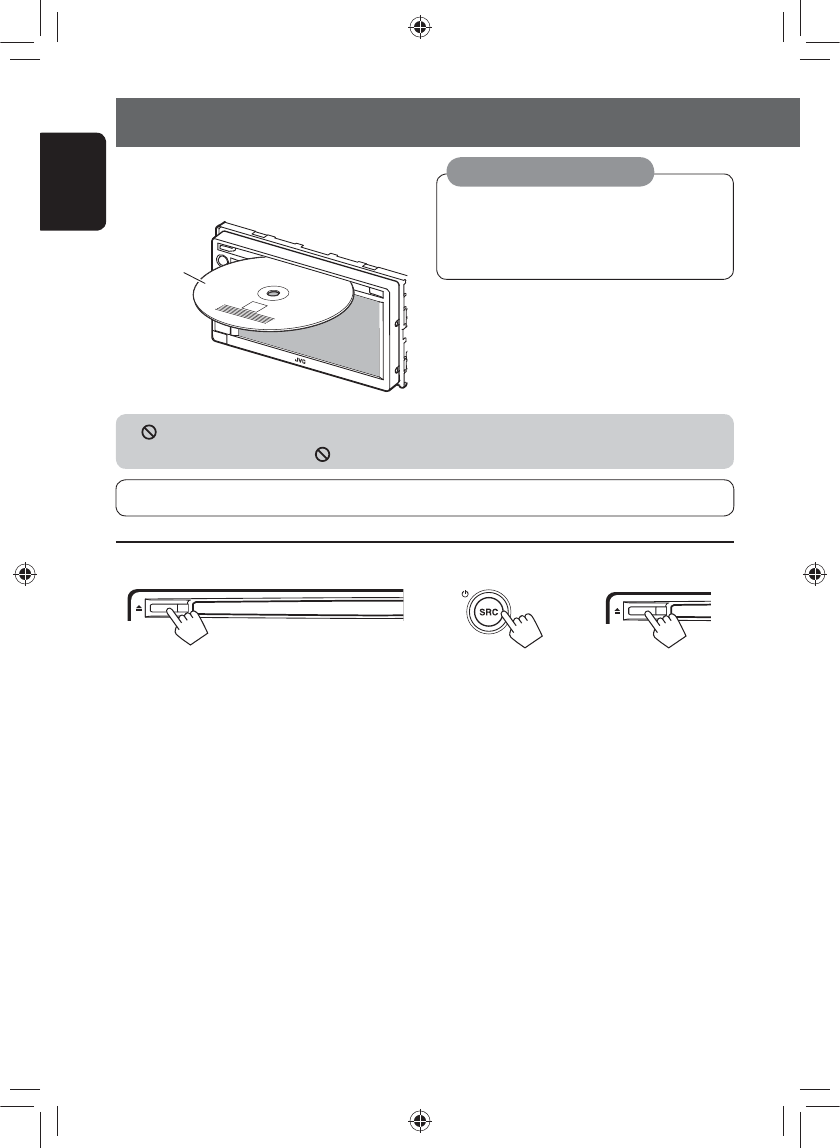
+
50
ENGLISH
~ Insert a disc.
The source changes to “DISC” and playback starts.
Disc operations
When playing back a multi-channel encoded disc, the multi-channel signals are downmixed.
Label side
If “ ” appears on the screen, the unit cannot accept the operation you have tried to do.
• In some cases, without showing “ ,” operations will not be accepted.
Discs produce very little noise compared with other
sources. Lower the volume before playing a disc
to avoid damaging the speakers by the sudden
increase of the output level.
Caution on volume setting:
To eject a disc
• You can eject a disc when playing another AV source.
• If the ejected disc is not removed within 15 seconds,
the disc is automatically inserted again into the
loading slot to protect it from dust.
• If the disc cannot be ejected, ☞ page 4.
To prohibit disc ejection
A confirmation message appears.
To cancel the prohibition, repeat the same
procedure.
[Hold]
• If a disc does not have any disc menu, all tracks on it
will be played repeatedly until you change the source
or eject the disc.
EN_KW-NT30_50[J].indb 50
EN_KW-NT30_50[J].indb 50
1/31/2011 3:24:24 PM
1/31/2011 3:24:24 PM
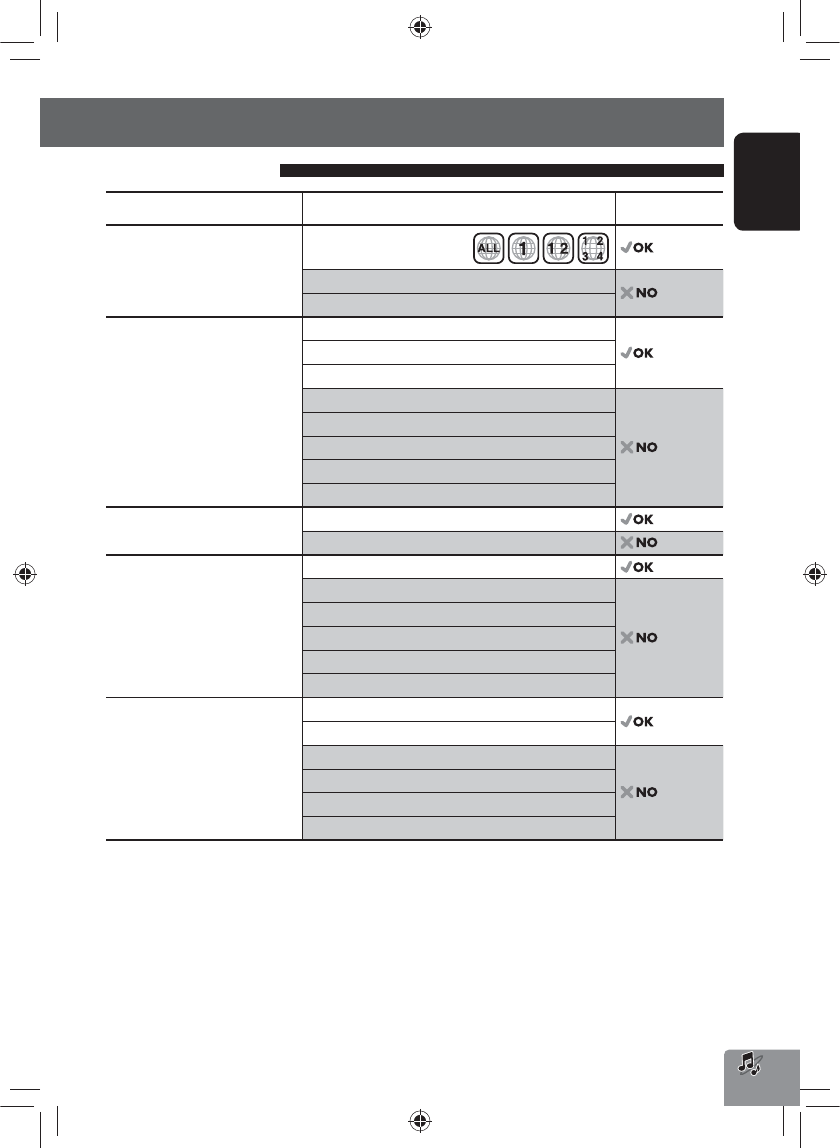
Disc operations
51
ENGLISH
Playable disc types
Disc type Recording format, file type, etc. Playable
DVD
• DTS sound cannot be reproduced
or output from this unit.
DVD Video (Region Code: 1) *1
DVD Audio
DVD-ROM
DVD Recordable/Rewritable
(DVD-R/-RW * 2, +R/+RW * 3)
• DVD Video: UDF bridge
• DVD-VR
• MP3/WAV: ISO 9660 level 1,
level 2, Romeo, Joliet
DVD Video
DVD-VR *4
MP3/WAV
JPEG
WMA/AAC
DivX/MPEG1/MPEG2/MPEG4
DVD+VR
DVD-RAM
Dual Disc DVD side
Non-DVD side
CD/VCD Audio CD/CD Text (CD-DA)
VCD (Video CD)
DTS-CD
SVCD (Super Video CD)
CD-ROM
CD-I (CD-I Ready)
CD Recordable/Rewritable
(CD-R/-RW)
• ISO 9660 level 1, level 2, Romeo,
Joliet
CD-DA
MP3/WAV
WMA/AAC
JPEG
DivX/MPEG1/MPEG2
MPEG4
*1 If you insert a DVD Video disc of an incorrect Region Code, “Region code error” appears on the screen.
*2 DVD-R recorded in multi-border format is also playable (except for dual layer discs).
DVD-RW dual layer discs are not playable.
*3 It is possible to play back finalized +R/+RW (Video format only) discs. “DVD” is selected as its disc type when a
+R/+RW disc is loaded. +RW double layer discs are not playable.
*4 This unit cannot play back contents protected with CPRM (Content Protection for Recordable Media).
EN_KW-NT30_50[J].indb 51
EN_KW-NT30_50[J].indb 51
1/31/2011 3:24:24 PM
1/31/2011 3:24:24 PM
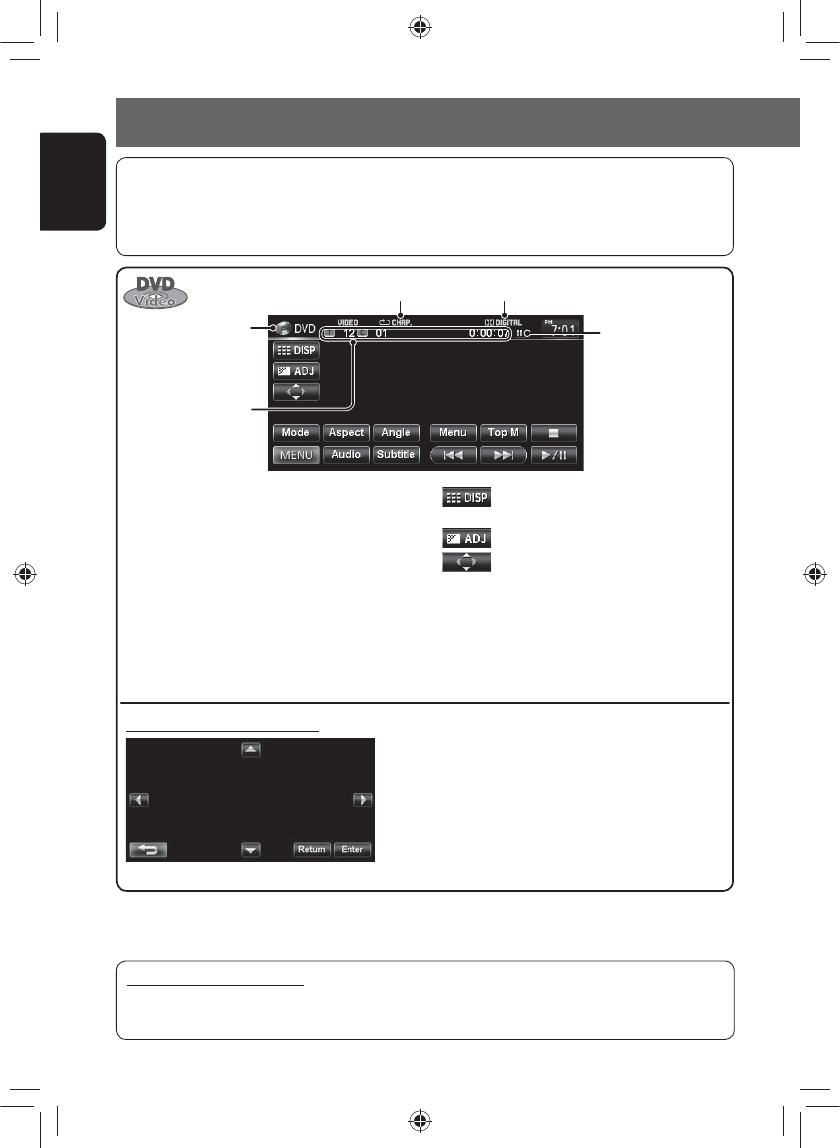
52
ENGLISH
Audio format
Title no./Chapter no./
Playing time
[3 / 8] Starts playback/pauses.
[7] Stops playback.
[4] [¢]Press: Selects chapter.
Hold: Reverse/forward search .
(Search speed: x2 ] x10)
[Aspect]Selects aspect ratio. (☞ page 72)
[Angle] Selects view angle.
[Audio] Selects audio language.
[Subtitle] Selects subtitle language.
[Menu] [Top M] Displays the disc menu.
Disc type
Playback mode
Using the menu selecting screen
Only for DVD Video/DVD-VR:
Pressing DISP or touching the screen shows the operating buttons and playback information on the screen. The
operating buttons and playback information disappear by pressing DISP or when no operation is done for about
5 seconds.
[5] [∞] [2] [3] Selects the menu items.
[Enter] Confirms the selection.
[Return] Returns to the previous menu.
[ ]Hides/displays the operating
buttons on the screen.
[ ]Adjusts the picture. (☞ page 72)
[ ]Displays the menu selecting
screen. (☞ below)
[Mode] • Selects repeat playback mode.
(☞ page 55)
• Changes the settings for disc
playback. (☞ page 56)
Caution for DualDisc playback
The Non-DVD side of a “DualDisc” does not comply with the “Compact Disc Digital Audio” standard. Therefore,
the use of Non-DVD side of a DualDisc on this product may not be recommended.
Disc operations
Playback status
(8: pause/7: stop)
EN_KW-NT30_50[J].indb 52
EN_KW-NT30_50[J].indb 52
1/31/2011 3:24:25 PM
1/31/2011 3:24:25 PM
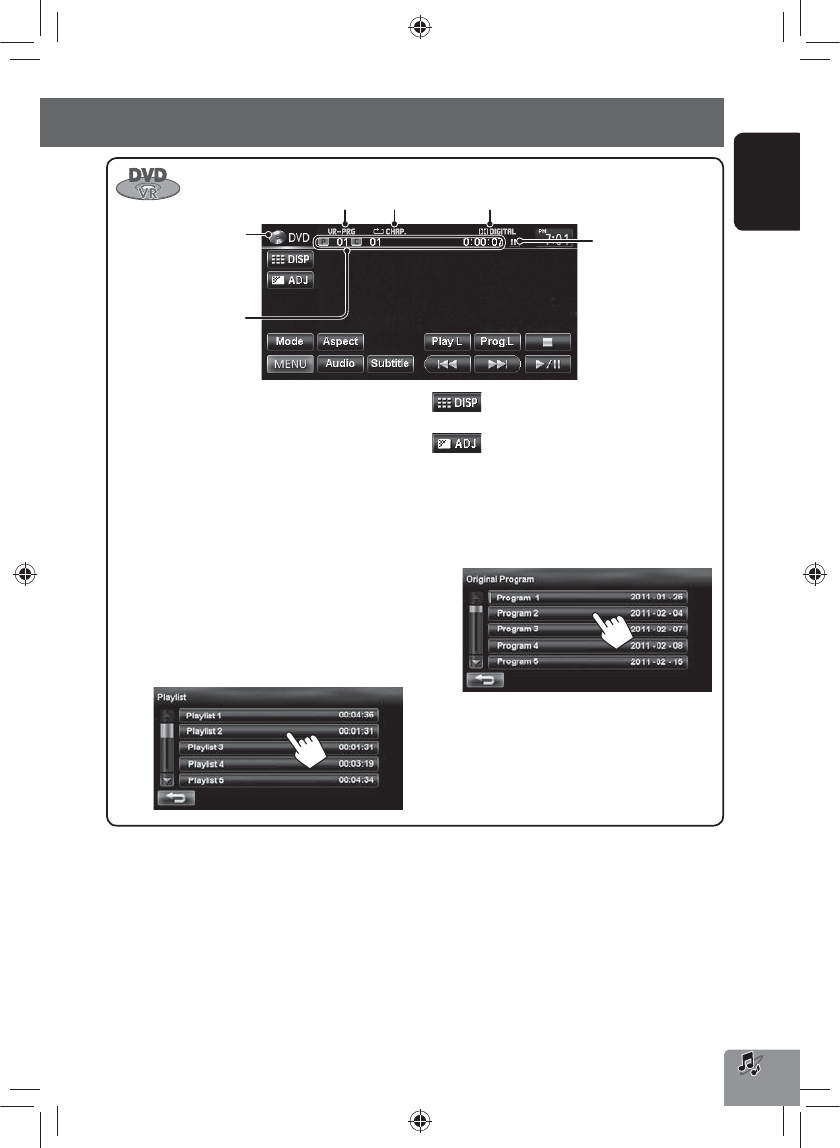
53
ENGLISH
Program no. (or Playlist
no.)/Chapter no. (or file
no.)/Playing time
[3 / 8] Starts playback/pauses.
[7] Stops playback.
[4] [¢]Press: Selects chapter.
Hold: Reverse/forward search .
(Search speed: x2 ] x10)
[Aspect]Selects aspect ratio. (☞ page 72)
[Audio] Selects audio channel (ST: stereo,
L: left, R: right).
[Subtitle] Shows (ON)/hides (OFF) the subtitle.
[Play L] Displays the Playlist.
• For details about DVD-VR
format and Playlist, refer to the
instructions supplied with the
recording equipment.
[ ]Hides/displays the operating buttons
on the screen.
[ ]Adjusts the picture. (☞ page 72)
[Mode] • Selects repeat playback mode.
(☞ page 55)
• Changes the settings for disc
playback. (☞ page 56)
[Prog.L] Displays the Original Program.
Audio format
Playback mode
Disc type
VR playback mode—VR-PRG
(program) or VR-PLAY (playlist)
Playback status
(8: pause/7: stop)
Disc operations
EN_KW-NT30_50[J].indb 53
EN_KW-NT30_50[J].indb 53
1/31/2011 3:24:25 PM
1/31/2011 3:24:25 PM
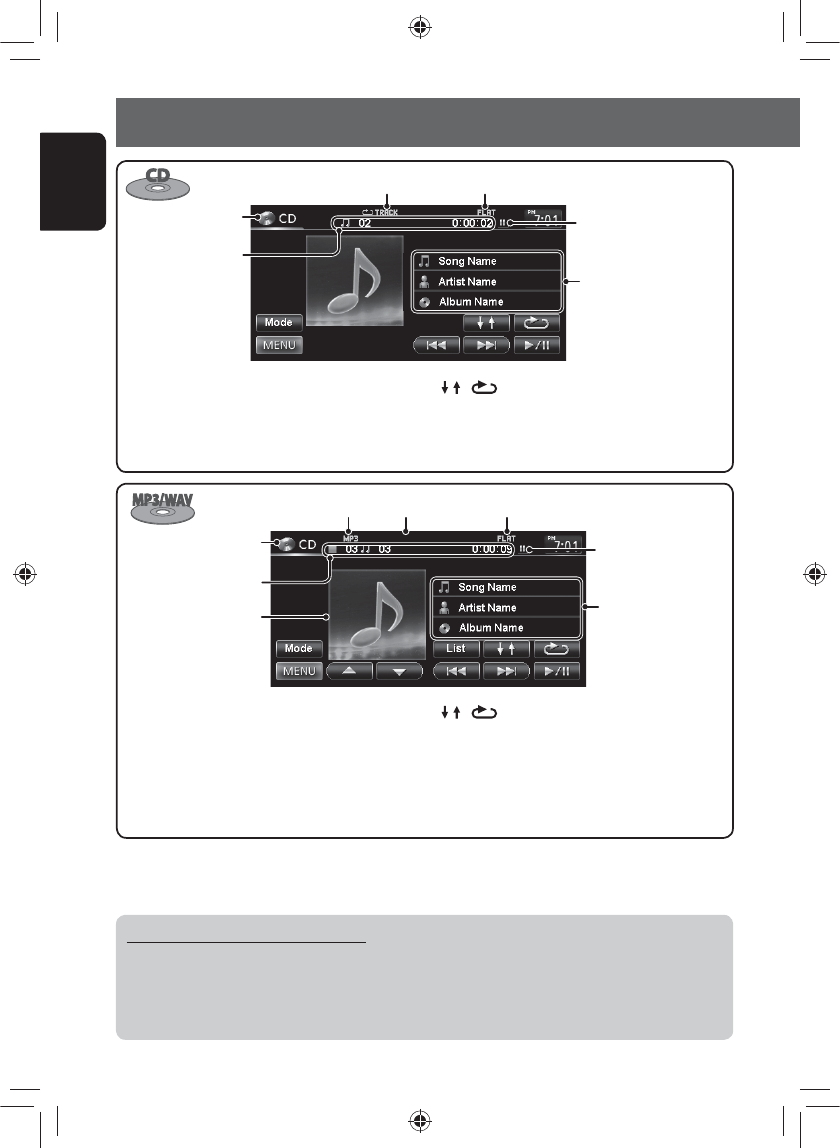
54
ENGLISH
Disc operations
[ ] [ ] Selects playback modes.
(☞ page 55)
[Mode] Changes the settings for disc
playback. (☞ page 56)
Track no./Playing time
Playback mode Sound mode (☞ page 70)
Disc type
The track information
appears when it is recorded.
[3 / 8] Starts playback/pauses.
[4] [¢]Press: Selects track.
Hold: Reverse/forward search.
* When switching the folder, the folder name and file name appear for about 5 seconds even if tag data is recorded.
Audio format (MP3/WAV)
While playing, “Jacket
picture” is shown if the file
has the tag data including
“Jacket picture”.
[3 / 8] Starts playback/pauses.
[4] [¢]Press: Selects track.
Hold: Reverse/forward search .
[5] [∞] Selects folder.
Folder no./Track no./
Playing time
Playback mode Sound mode (☞ page 70)
Disc type
Tag data appears only
when it is recorded. *
(Current folder name and
file name appear if not
recorded.)
[ ] [ ] Selects playback modes.
(☞ page 55)
[Mode] Changes the settings for disc
playback. (☞ page 56)
[List] Displays Folder/Track Lists.
(☞ page 11)
Playing Recordable/Rewritable discs
• This unit can recognize a total of 5 000 files and 250 folders (a maximum of 999 files per folder).
• Use only “finalized” discs.
• This unit can play back multi-session discs; however, unclosed sessions will be skipped while playing.
• Some discs or files may not be played back due to their characteristics or recording conditions.
Playback status (8: pause)
Playback status
(8: pause)
EN_KW-NT30_50[J].indb 54
EN_KW-NT30_50[J].indb 54
1/31/2011 3:24:26 PM
1/31/2011 3:24:26 PM
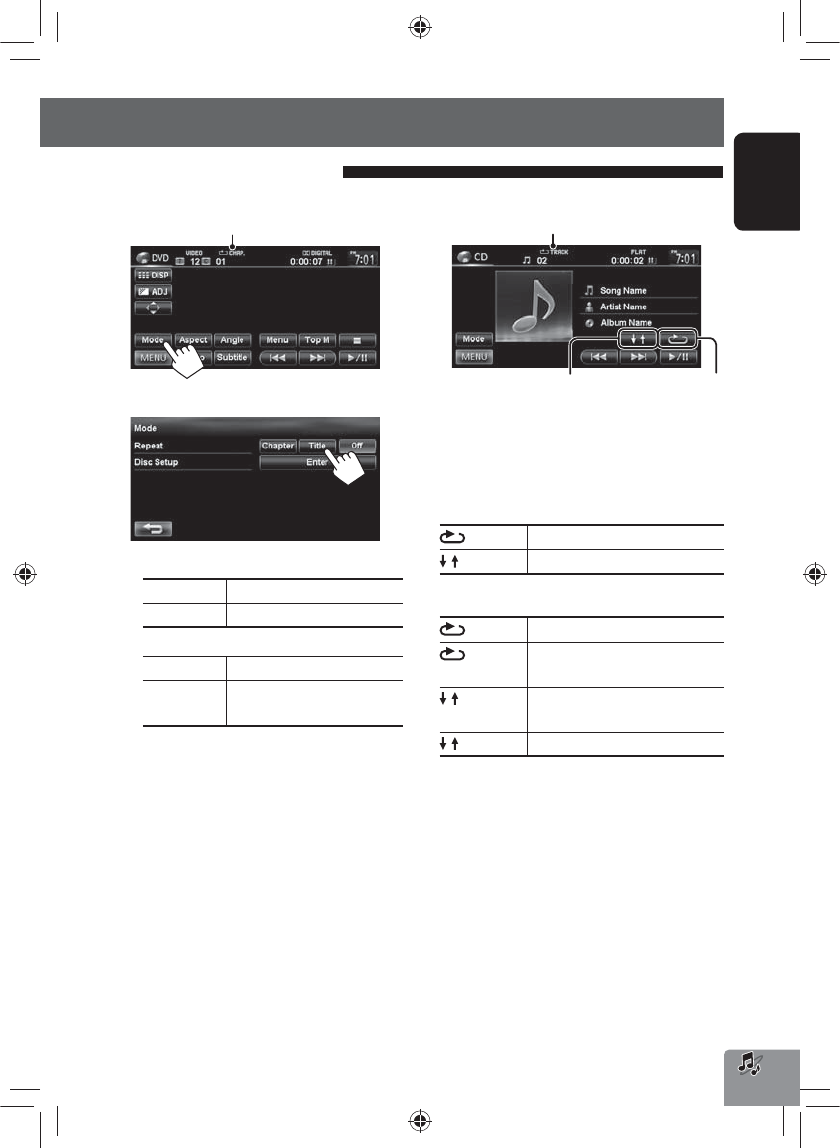
55
ENGLISH
Selecting playback modes
For CD/MP3/WAV
• You cannot activate the repeat mode and the random
mode at the same time.
• For CD:
TRACK Repeats current track.
DISC Randomly plays all tracks.
• For MP3/WAV:
TRACK Repeats current track.
FOLDER Repeats all tracks of the current
folder.
FOLDER Randomly plays all tracks of current
folder, then tracks of next folders.
DISC Randomly plays all tracks.
• Press the button repeatedly until the desired
playback mode is selected.
To cancel, press the button repeatedly until the
indicator disappears.
For DVD/DVD-VR
1
2 Select Repeat mode.
• For DVD:
Chapter Repeats current chapter.
Title Repeats current title.
• For DVD-VR
Chapter Repeats current chapter.
Program Repeats current program (not
available for Playlist playback).
To cancel, select <Off>.
Selects Repeat
playback mode
Selects Random
playback mode
Playback mode
Playback mode
Disc operations
EN_KW-NT30_50[J].indb 55
EN_KW-NT30_50[J].indb 55
1/31/2011 3:24:26 PM
1/31/2011 3:24:26 PM
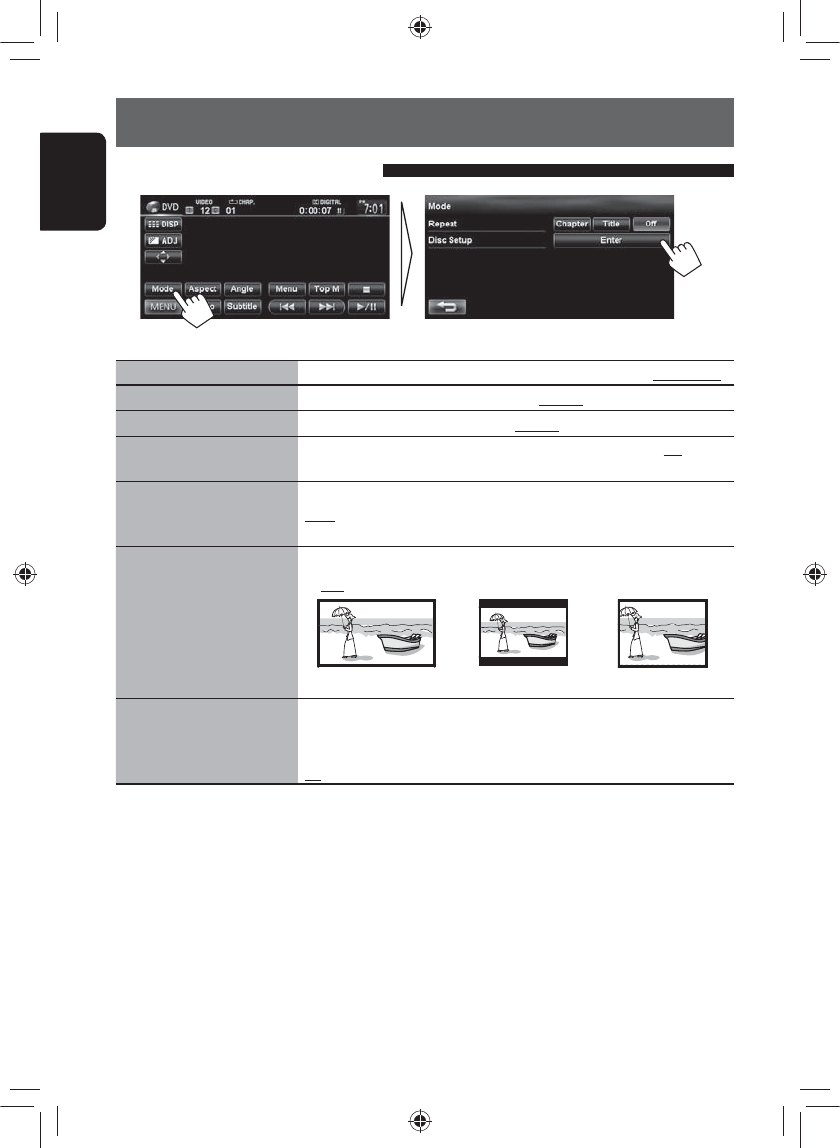
56
ENGLISH
Disc operations
Settings for the disc playback
Disc Setup items Selectable settings Initial: Underlined
Menu Language Select the initial disc menu language; Initial English (☞ also page 77).
Audio Language Select the initial audio language; Initial English (☞ also page 77).
Subtitle Language Select the initial subtitle language or erase the subtitle (Off); Initial Off
(☞ also page 77).
Video Output Format Select the color system of the external monitor.
NTSC, PAL
• This setting is valid only to the external monitor connected.
Monitor Type Select the monitor type to watch a wide screen picture on the external monitor.
◆ 16:9 ◆ 4:3 LB (Letterbox) ◆ 4:3 PS (PanScan)
The Monitor Type setting also determines how videos are displayed on the unit.
D. Range Compres. You can enjoy a powerful sound at a low volume level while playing Dolby
Digital software.
Auto : Select to apply the effect to multi-channel encoded software.
On : Select to always use this function.
EN_KW-NT30_50[J].indb 56
EN_KW-NT30_50[J].indb 56
1/31/2011 3:24:27 PM
1/31/2011 3:24:27 PM
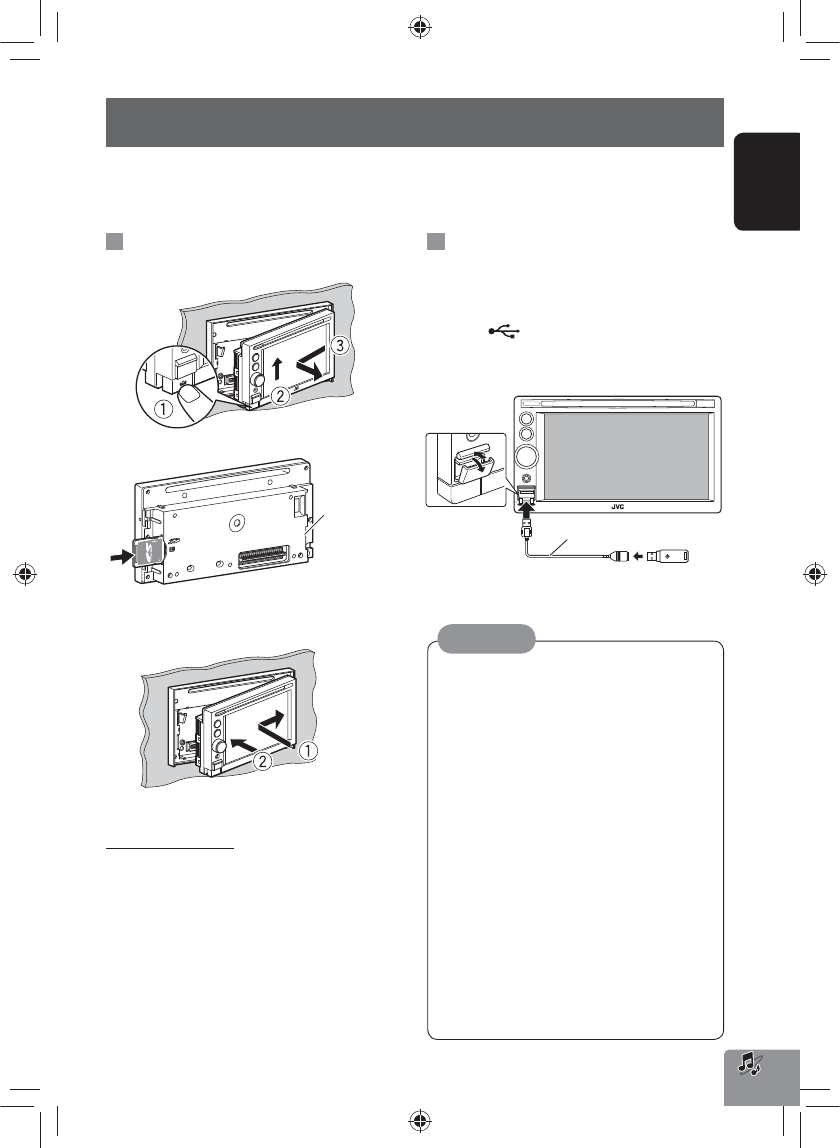
57
ENGLISH
SD/USB operations
This unit can play the MP3/WMA files stored in SD card/USB mass storage class device.
• All tracks in the SD card/USB device will be played repeatedly until you change the source.
• Make sure all important data has been backed up.
Inserting SD card
1 Detach the monitor panel.
2 Insert an SD card.
Push in the SD card until you hear a clicking sound.
3 Attach the monitor panel.
The source changes to “SD” and playback starts.
To eject the SD card
Detach the monitor panel, then push in the SD card
lightly.
Monitor panel
Connecting USB device
You can connect a USB mass storage class device such as
a USB memory, Digital Audio Player, etc. to the unit.
• You cannot connect a computer or portable HDD to
the USB ( ) terminal of the unit.
• When connecting a USB device, refer also to its
instructions.
The source changes to “USB” and playback starts.
• Avoid using the USB device if it might hinder your
safety driving.
• Do not start the car engine if a USB device is
connected.
• Do not pull out and attach the USB device
repeatedly while “File Check” is shown on the
screen.
•
Disconnect a USB device while playback is paused
or another source is selected.
• Electrostatic shock at connecting a USB device
may cause abnormal playback of the device. In
this case, disconnect the USB device then reset it
and detach the monitor panel (then attach it).
• Do not leave a USB device in the car, expose to
direct sunlight, or high temperature to avoid
deformation or cause damages to the device.
• For more details about USB operations,
☞ page 76.
Caution:
USB cable (not supplied)
EN_KW-NT30_50[J].indb 57
EN_KW-NT30_50[J].indb 57
1/31/2011 3:24:27 PM
1/31/2011 3:24:27 PM
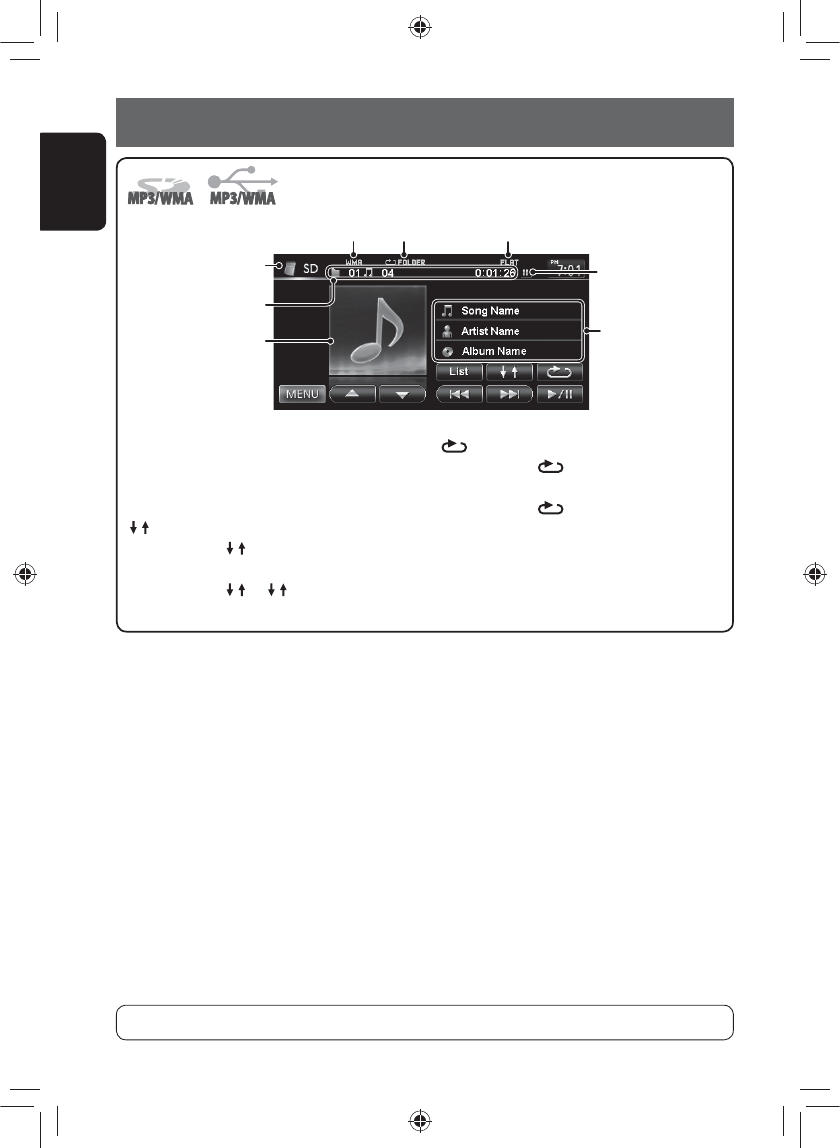
58
ENGLISH
*1 When switching the folder, the folder name and file name appear for about 5 seconds even if tag data is recorded.
*2 To cancel random or repeat mode, press the button repeatedly until the indicator disappears.
*3 You cannot activate the repeat mode and the random mode at the same time.
Source type (“SD” or “USB”)
[ ] Selects Repeat playback mode. *2 * 3
• TRACK: Repeats current
track.
• FOLDER: Repeats all tracks of
the current folder.
[List] Displays Folder/Track Lists.
(☞ page 11)
Audio format
(MP3/WMA)
While playing, “Jacket
picture” is shown if the file
has the tag data including
“Jacket picture”.
Folder no./Track no./
Playing time
Playback mode Sound mode (☞ page 70)
[3 / 8] Starts playback/pauses.
[4] [¢]Press: Selects track.
Hold: Reverse/forward search.
[5] [∞] Selects folder.
[ ] Selects Random playback mode. *2 *3
• FOLDER: Randomly plays all
tracks of the folder.
• SD/ USB: Randomly plays
all tracks.
• This unit can recognize a total of 5 000 files and 999 folders (a maximum of 999 files per folder).
Tag data appears only
when it is recorded. *1
(Current folder name
and file name appear if
not recorded.)
Playback status
(8: pause)
SD/USB operations
• While playing from a USB device, the playback order may differ from other players.
• This unit may be unable to play back some USB devices or some files due to their characteristics or recording
conditions.
• This unit may not play back files in a USB device properly when using a USB extension cord.
• This unit cannot assure proper functions or supply power to all types of the devices.
EN_KW-NT30_50[J].indb 58
EN_KW-NT30_50[J].indb 58
1/31/2011 3:24:27 PM
1/31/2011 3:24:27 PM
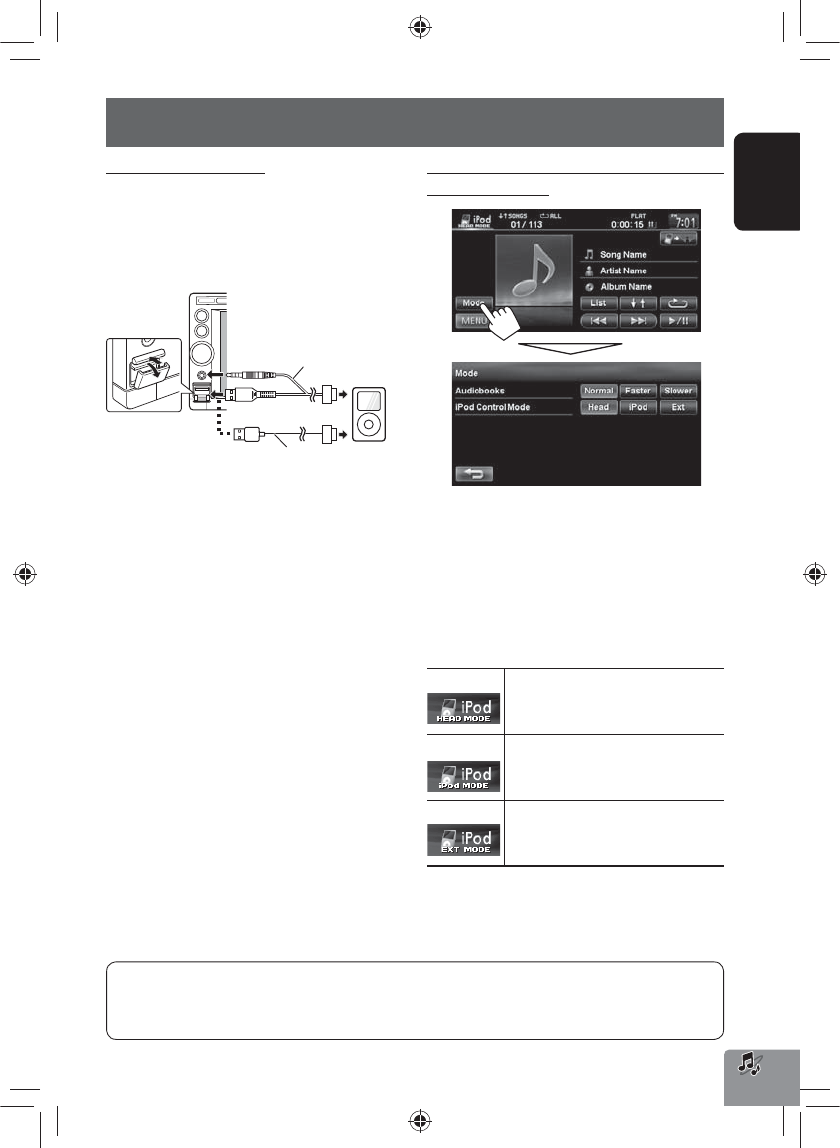
59
ENGLISH
Listening to the iPod/iPhone device
Connecting iPod/iPhone
• Use the following cables:
– To listen to the music: USB 2.0 cable (accessory
of the iPod/iPhone)
– To watch the video: USB Audio and Video cable
for iPod/iPhone—KS-U39 (not supplied)
• When you turn on this unit, the iPod/iPhone is
charged through the unit.
• You can control the following iPod/iPhone models:
– iPod with video (5th Generation) *
– iPod classic *
– iPod nano (6th Generation)
– iPod nano (5th Generation) *
– iPod nano (4th Generation) *
– iPod nano (3rd Generation) *
– iPod nano (2nd Generation)
– iPod nano (1st Generation)
– iPod touch (4th Generation) *
– iPod touch (3rd Generation) *
– iPod touch (2nd Generation) *
– iPod touch (1st Generation) *
– iPhone 4*
– iPhone 3GS *
– iPhone 3G *
– iPhone*
* To watch the video with its audio, connect the iPod/
iPhone using USB Audio and Video cable (KS-U39, not
supplied).
Setting the iPod control mode and the speed
of the audio books
Audiobooks
Select the speed of audio books.
iPod Control Mode
• When using iPod nano (1st Generation) or iPod
with video (5th Generation), only <Head> mode is
selectable.
Head Controls playback from this unit.
iPod Controls audio/video playback from the
iPod/iPhone.
• Playback information is shown.
Ext Allows any audio/video signals from
iPod/iPhone.
• No information is shown.
For some iPod/iPhone models, the performance may be abnormal or unstable during operation. In this case,
disconnect the iPod/iPhone device, then check its condition.
If the performance is not improved or slow, reset your iPod/iPhone.
USB 2.0 cable (accessory of
the iPod/iPhone)
KS-U39 (not supplied)
or
EN_KW-NT30_50[J].indb 59
EN_KW-NT30_50[J].indb 59
1/31/2011 3:24:27 PM
1/31/2011 3:24:27 PM
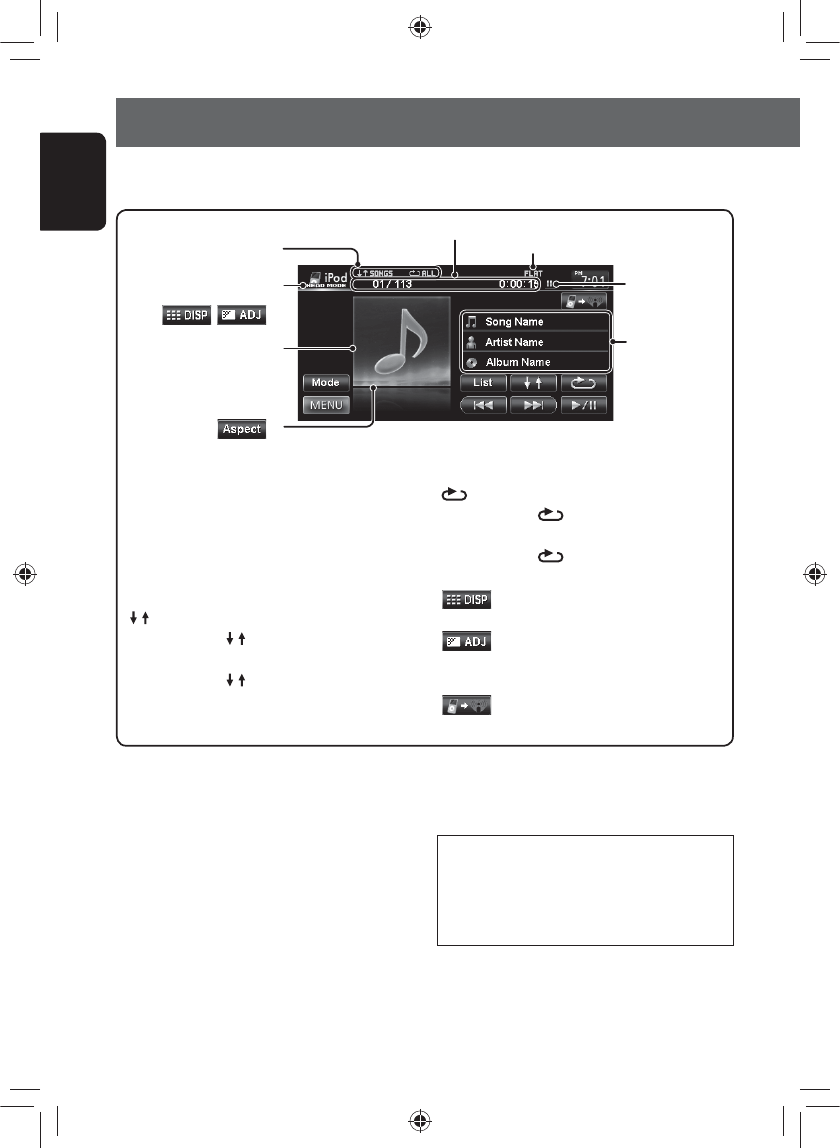
60
ENGLISH
*1 Appears only when video is played back.
*2 To cancel random or repeat mode, press the button repeatedly until the indicator disappears.
Track no./Total track number/Playing time
iPod control mode (☞ page 59)
Playback mode Sound mode (☞ page 70)
While playing, Artwork (the
picture displayed on the screen
of iPod/iPhone) is shown if the
song contains the Artwork.
[3 / 8] Starts playback/pauses.
[4] [¢]Press: Selects track/video.
Hold: Reverse/forward search.
[List] Displays the Music/Video menu on
the iPod/iPhone. (☞ page 61)
[Aspect] *1Selects aspect ratio. (☞ page 72)
[] Selects Random playback mode. *2
• SONGS: Functions the same as
“Shuffle Songs.”
• ALBUMS: Functions the same
as “Shuffle Albums.”
[]Selects Repeat playback mode. *2
• ONE: Functions the same as
“Repeat One.”
• ALL: Functions the same as
“Repeat All.”
[ ]*1Hides/displays the operating buttons
on the screen.
[ ]*1Adjusts the picture. (☞ page 72)
[Mode] Changes the iPod control mode or
speed of audio books. (☞ page 59)
[ ]Switches the iheartradio application
mode.
*1
Playback status
(8: pause/7: stop)
Song/video
information
• You cannot resume playback for video sources under some conditions.
• When playing back a track containing Artwork ,
operating buttons temporarily disappear while
loading its Artwork.
Notice:
When operating an iPod/iPhone, some operations
may not be performed correctly or as intended. In
this case, visit the following JVC web site: <http://
www.jvc.co.jp/english/car/> (English website only)
, *1
Listening to the iPod/iPhone device
• The operations explained in this manual are under <Head> mode (☞ page 59).
• When <iPod> or <Ext> mode is selected, only [Mode] is displayed.
EN_KW-NT30_50[J].indb 60
EN_KW-NT30_50[J].indb 60
1/31/2011 3:24:28 PM
1/31/2011 3:24:28 PM
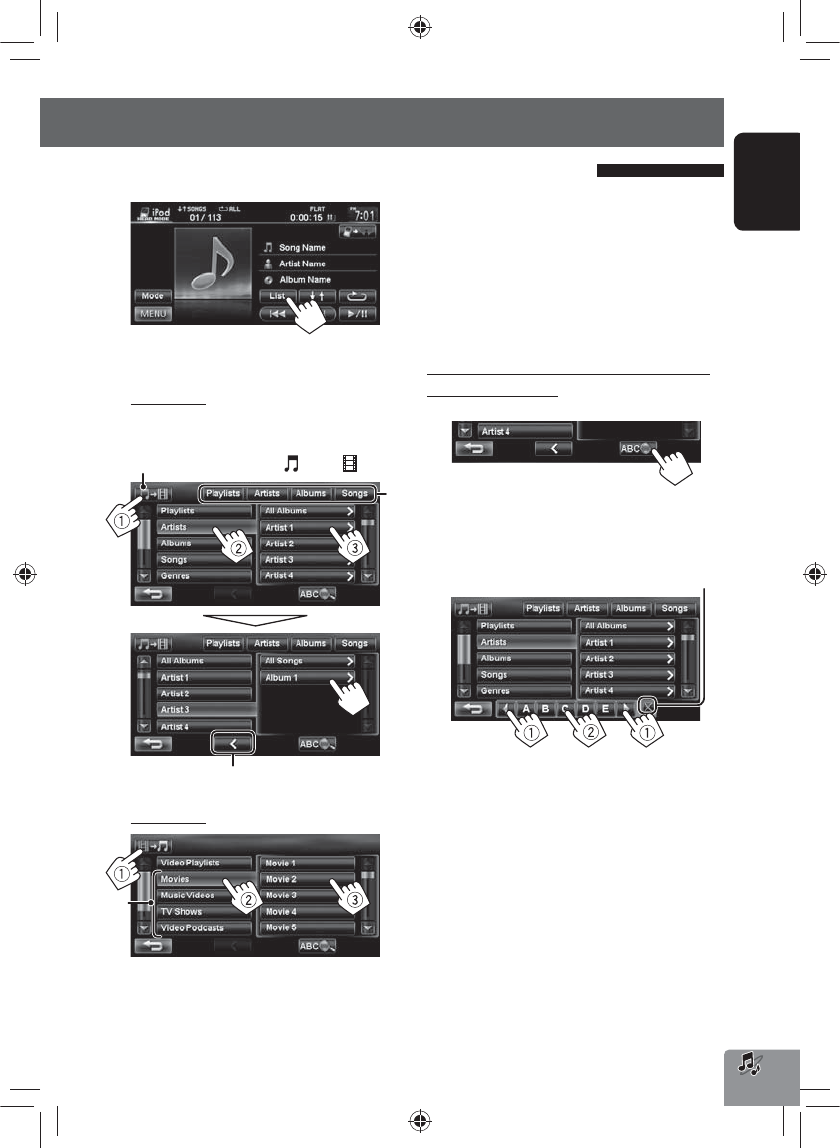
*1
*2
61
ENGLISH
1
2 Select the menu (Music or Video) (1), a
category (2), then a desired item (3).
Music menu:
Select the item in the selected layer until a desired
track starts playing.
Video menu:
Selecting a track/video from menu on the iPod/iPhone
Corresponding icon lights in orange. ( : Music / : Video)
Returns to the previous layer
Erases the search operation buttons
Listening to the iPod/iPhone device
• Available categories depend on the type of your iPod/
iPhone.
*1 You can also select the category by pressing the
corresponding tab.
*2 These categories are shown in the language selected
on your iPod/iPhone.
Searching for items in the selected category by
alphabet and number
1
2 Display the first character of the title of the
item you want to search for (1), then search
for an item (2).
Press the character button repeatedly until the
desired item is displayed.
• Only available characters are selectable.
• When selecting other character than the
alphabet, press [#].
3 Select the desired item from the list.
EN_KW-NT30_50[J].indb 61
EN_KW-NT30_50[J].indb 61
1/31/2011 3:24:29 PM
1/31/2011 3:24:29 PM
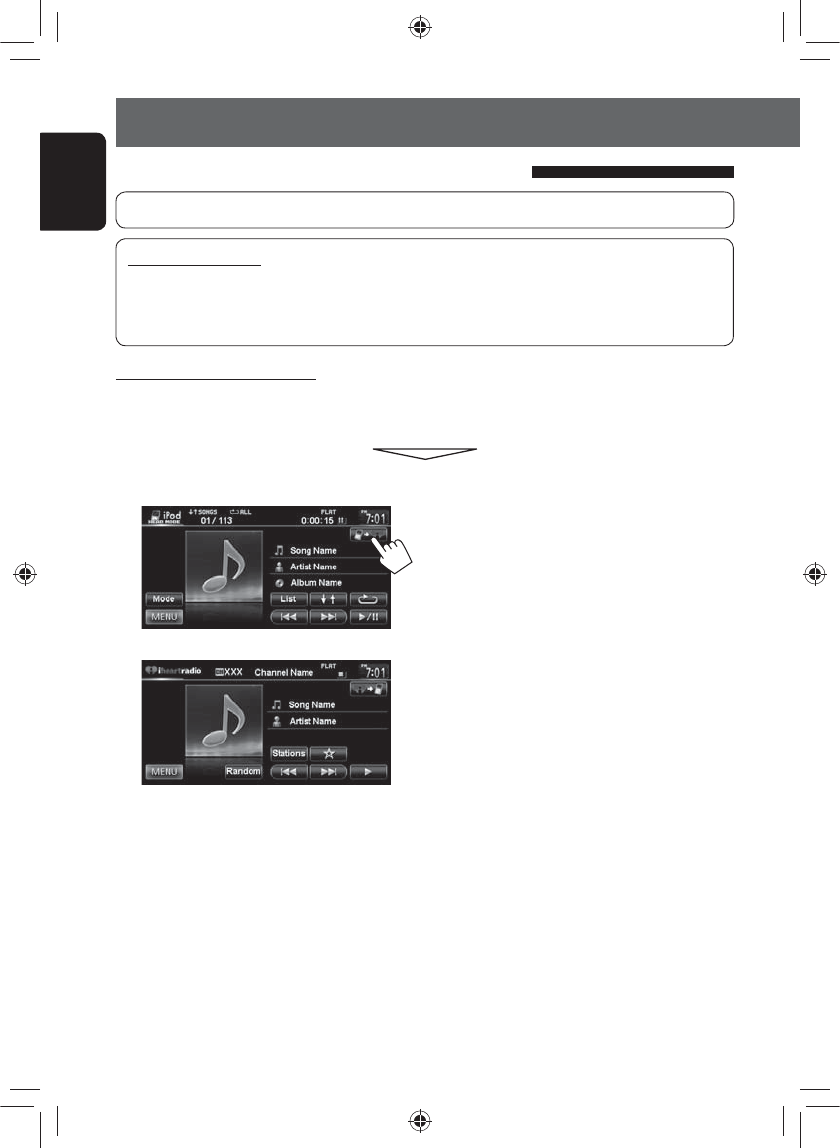
62
ENGLISH
Listening to the iPod/iPhone device
Listening to iheartradio with the iPod/iPhone
You can connect your iPod touch/iPhone to this unit and listen to iheartradio.
What is iheartradio?
iheartradio is an iPod touch/iPhone application that can deliver access to over 750 local radio stations in both
AM and FM, as well as commercial-free and artist-programmed channels. All stations are streamed in high-
quality AAC format.
Connecting iPod touch/iPhone
1 Start the iheartradio application by your iPod touch/iPhone.
2 Connect the iPod touch/iPhone to the unit (☞ page 59).
The source is changed to “iPod”.
3
• The first station in the [Favorite] station list is automatically selected. If there are no stations in the [Favorite]
station list, the iheartradio application is stopped until a station is selected (☞ page 64).
EN_KW-NT30_50[J].indb 62
EN_KW-NT30_50[J].indb 62
1/31/2011 3:24:30 PM
1/31/2011 3:24:30 PM
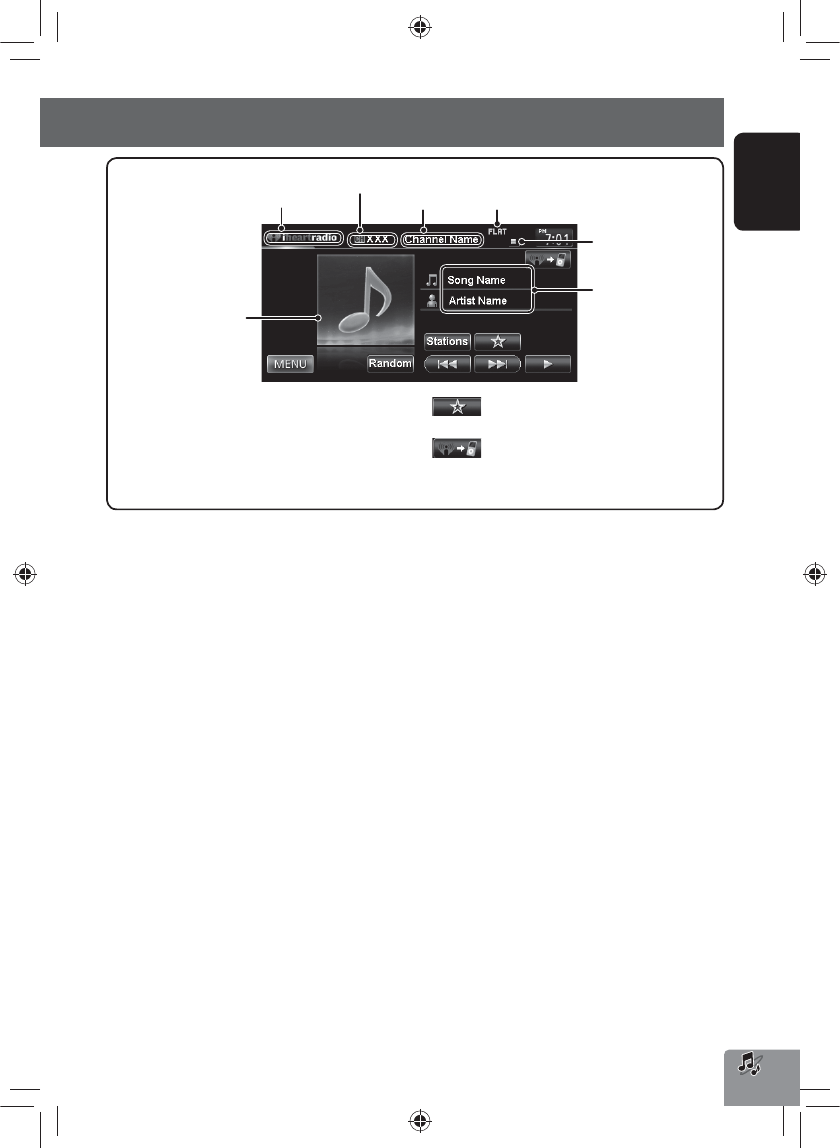
63
ENGLISH
Listening to the iPod/iPhone device
Displays the album
artwork or the station
logo.*2
[3 / 7] Turns the sound on and off.
[4] [¢]Selects the previous/next favorite
station.
[Random] Randomly selects a station.
[Stations] Displays the Station List.
[ ]Storing your favorite stations
(☞ page 64)
[ ]Returns to iPod touch/iPhone
playback.
Sound mode
Song information
Station name
Channel number*1
iheartradio mode
*1 The channel number is the number of the Favorite station according to its registration order.
*2 The station logo is displayed when there is no album artwork or the iheartradio application is stopped. If there is no
artwork or station logo available, the default artwork is displayed.
7 : Sound off
EN_KW-NT30_50[J].indb 63
EN_KW-NT30_50[J].indb 63
1/31/2011 3:24:30 PM
1/31/2011 3:24:30 PM
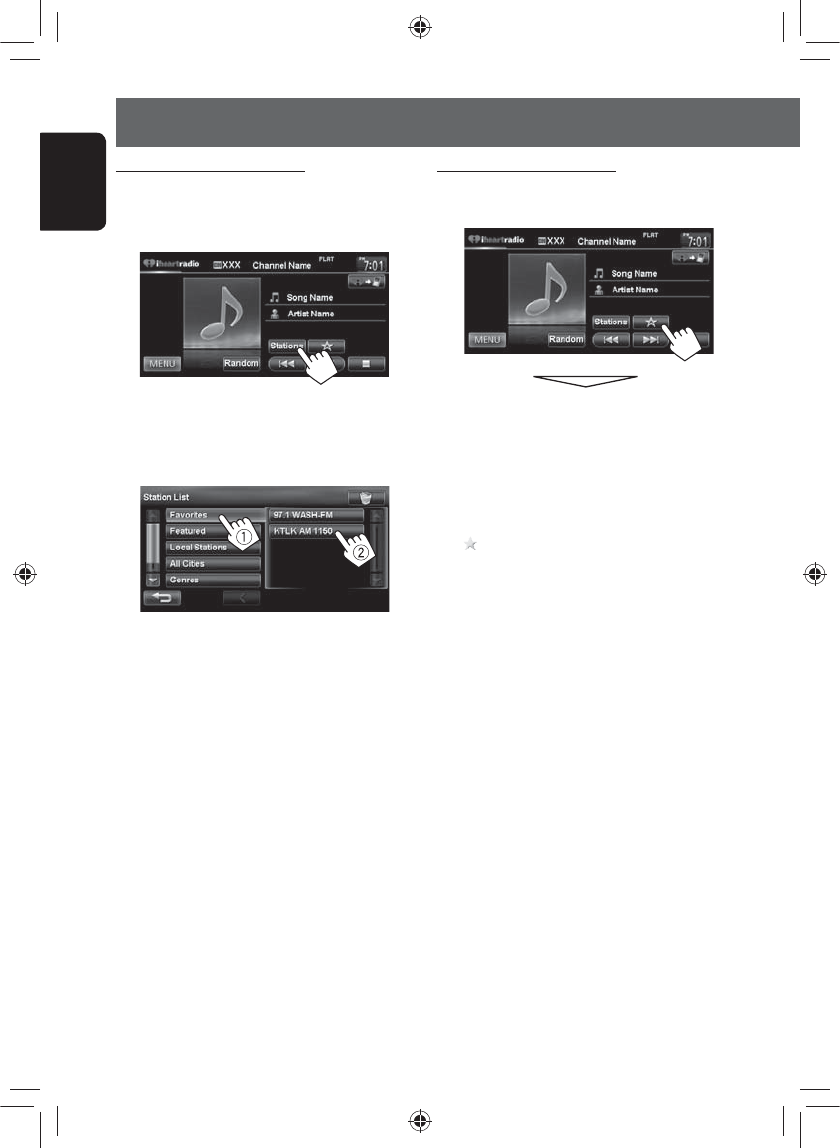
64
ENGLISH
Listening to the iPod/iPhone device
Storing your favorite stations
Favorite stations that were stored are displayed in the
Station List. (☞ left)
The station currently being listened to is added to the
[Favorite] station list.
• A maximum of 100 stations can be added to the
[Favorite] station list.
• Stations are added to the end of the [Favorite] station
list.
The [ ] button is not available when listening to a
station that has already been stored as a favorite.
Searching from the Station List
You can use the Station List screen to search for
stations.
1 Select [Stations].
• It may take time to display lists with many items.
2 Select the station type (1), and then the
desired station (2).
• Favorite stations that were stored with the unit
are displayed in the Favorite list.
EN_KW-NT30_50[J].indb 64
EN_KW-NT30_50[J].indb 64
1/31/2011 3:24:30 PM
1/31/2011 3:24:30 PM
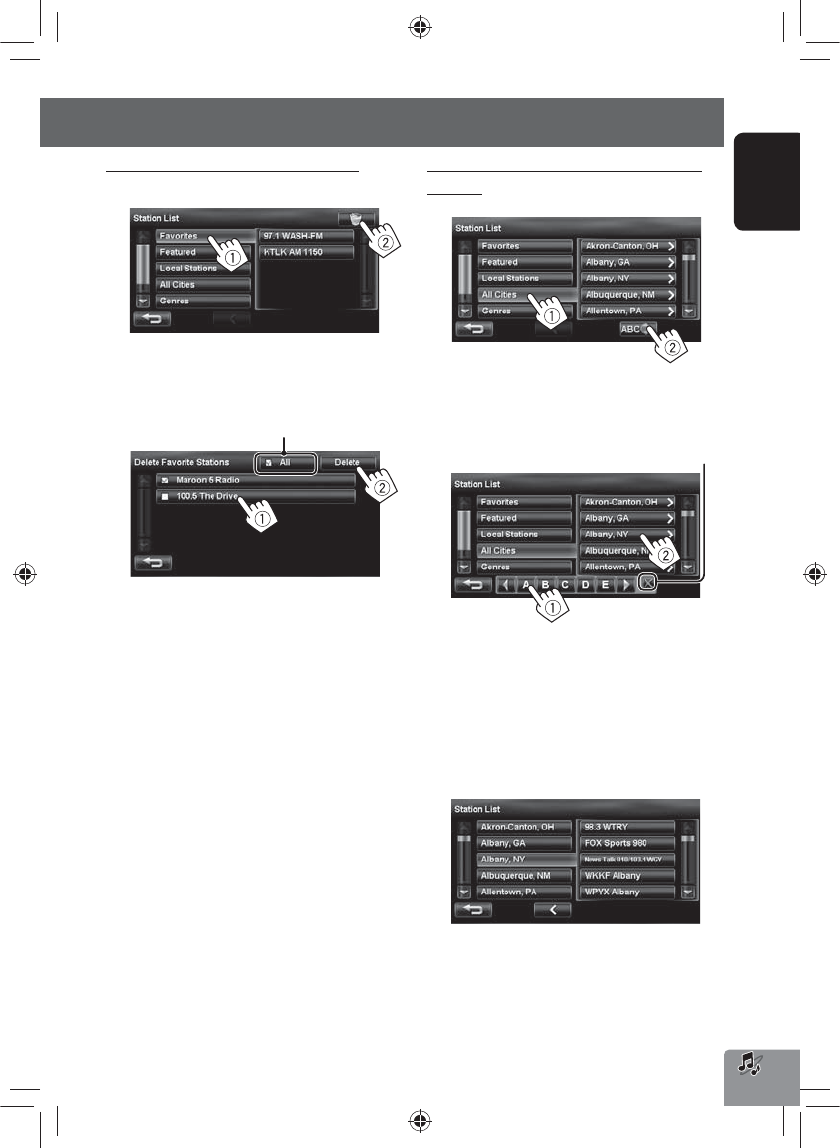
65
ENGLISH
To delete the station from the favorite list
1 Select (1), and then select (2).
2. Select items to delete (1), and delete them
(2).
The selected items are marked “✔”.
A confirmation message appears.
Searching for stations in All Cities category by
alphabet
1
2 Display the first character of the station you
want to search for (1), then search for a
station (2).
Press the character button repeatedly until the
desired station is displayed.
• Only available characters are selectable.
3 Select the desired station from the Station
List.
Selects/deselects all items
Listening to the iPod/iPhone device
Erases the search operation buttons
EN_KW-NT30_50[J].indb 65
EN_KW-NT30_50[J].indb 65
1/31/2011 3:24:31 PM
1/31/2011 3:24:31 PM

66
ENGLISH
For SIRIUS Radio
1 Select “SAT” as the source. (☞ page 44)
The SIRIUS Satellite radio starts updating all the
SIRIUS channels. (See “Channel Updates—SIRIUS/
XM” below.)
• Once completed, SIRIUS Satellite radio tunes in
to the Preview Channel.
2 Press [Mode] to display SIRIUS ID.
3 Contact SIRIUS on the internet at
<http://activate.siriusradio.com/> to
activate your subscription, or you can
all SIRIUS toll-free at 1-888-539-SIRIUS
(7474).
“Subscription updated Press any key to continue”
appears on the screen once subscription has been
completed.
For XM Radio
1 Select “SAT” as the source. (☞ page 44)
XM Tuner* starts updating all the XM
channels.“Channel 1” is tuned in automatically.
(See “Channel Updates—SIRIUS/XM” below.)
2 Check your XM Satellite Radio ID labelled
on the casing of the XM Tuner, or tune in
to “Channel 0.”
The 8-digit (alphanumeric) ID number is displayed
on the screen.
To cancel the ID number display, select any
channel other than “0.”
3 Contact XM Satellite radio on the
internet at <www.xmradio.com> and
click on “Activate Radio,” or you can call
1-800-XM-RADIO (1-800-967-2346).
Once activated, the unit can then be tuned to one
of the available channels.
* XM Tuner: XMDirect TM Tuner Box or XMDirect2 Tuner
System
Listening to the satellite radio
Before operating, connect either one of the following (not supplied) to the expansion port on the rear of the unit.
To listen to the SIRIUS Satellite radio SCC1 and KS-SRA100
D&P, SCVDOC1 and KS-SRA100
To listen to the XM Satellite radio JVC Smart Digital Adapter–XMDJVC100
CNP2000UCA and CNPJVC1
Channel Updates—SIRIUS/XM
• If channels are updated after subscription, updating starts automatically, and no sound can be heard:
– For SIRIUS Satellite radio: “UPDATING” appears.
–
For XM Satellite radio: “UPDATING” (when XMDJVC100 is connected) or “UNAUTH” (when CNP2000UCA and
CNPJVC1 are connected) appears.
• Update takes a few minutes to complete.
• Do not press any buttons or perform any operations until updating is completed.
Activating subscription
EN_KW-NT30_50[J].indb 66
EN_KW-NT30_50[J].indb 66
1/31/2011 3:24:31 PM
1/31/2011 3:24:31 PM
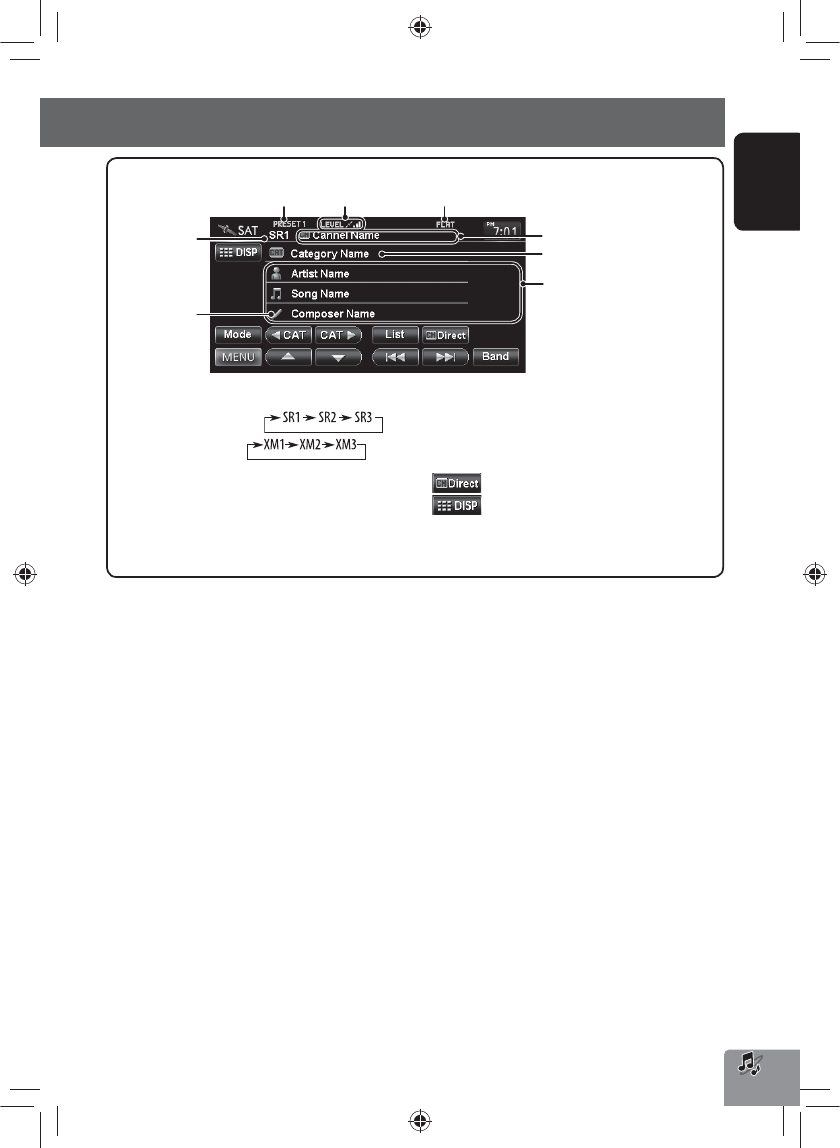
ENGLISH
67
Signal Reception
indicator
Channel no./Channel name
Band
Sound mode (☞ page 70)Preset no.
The song information currently
received
[Band] Selects the band.
For SIRIUS:
For XM:
[4] [¢]Press: Selects a channel.
Hold: Changes the channel rapidly.
– While searching, invalid and
unsubscribed channels are
skipped.
[5] [∞] Selects a preset channel.
[2 CAT]
[CAT 3]
Selects a category.*
Selects a category.*
[List] Displays the Category/Channel List.
[ ]Selects a channel directly.
[ ]Switches between preset list screen
and tuner source screen.
[Mode] Only for SIRIUS: Shows the SIRIUS ID.
Only for SIRIUS
* For SIRIUS Radio:
– To select a channel from all categories, select <ALL>.
For XM Radio:
– To select a channel from all categories (including non-categorized channels), press [2 CAT] or [CAT 3].
– If you do not select a channel within 15 seconds, the category selected is canceled. You can select a channel from all
categories now.
• To learn more about SIRIUS/XM programming or to become a subscriber, please visit <www.siriusxm.com>.
Listening to the satellite radio
Category name
EN_KW-NT30_50[J].indb 67
EN_KW-NT30_50[J].indb 67
1/31/2011 3:24:31 PM
1/31/2011 3:24:31 PM
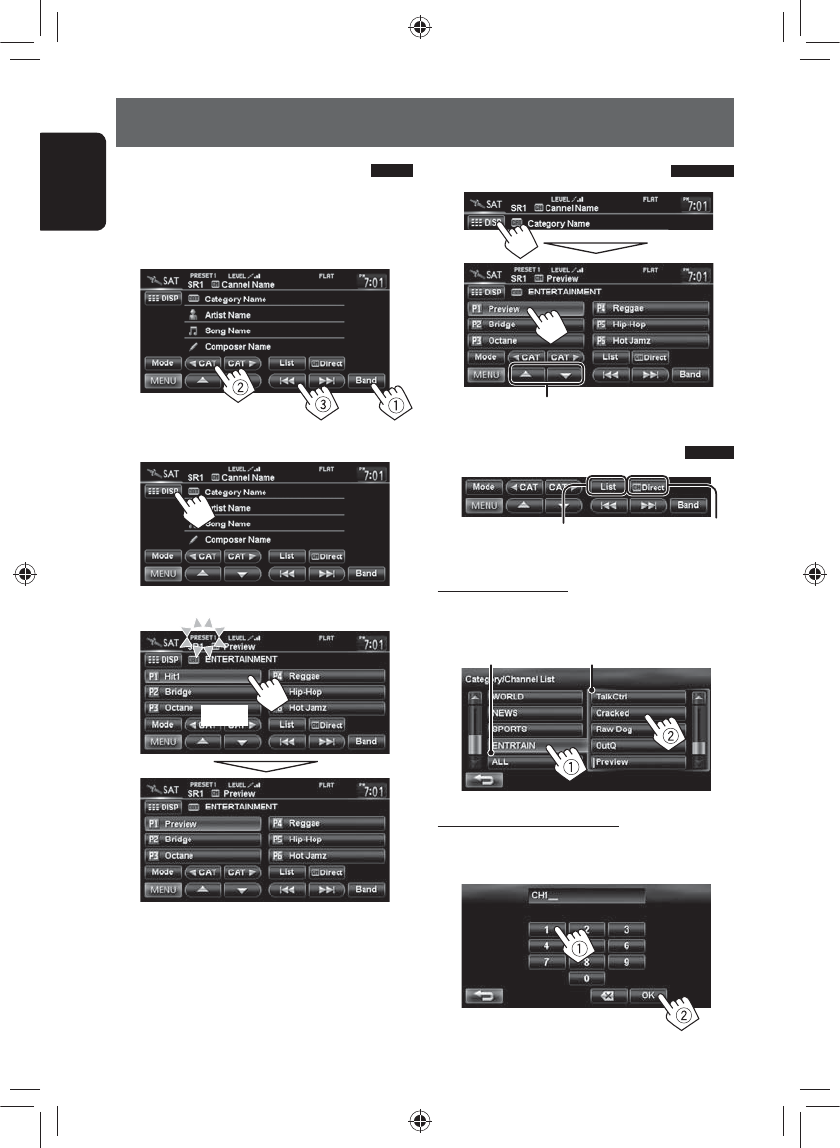
68
ENGLISH
[Hold]
Selecting preset channels
Selecting a channel quickly
Selecting on the list
Select a category (1), then a channel (2) from
the selected category.
Selecting a channel directly
Enter the channel number (1), then
confirm (2).
Storing channels in memory
You can preset six channels for each band.
1 Tune in to a station you want to preset.
(☞ page 67)
2 Display the preset list.(☞ page 67)
3 Select a preset number.
Current category Current channel
Select a channel from the
Category/Channel List
Select a channel directly by
entering channel number
Listening to the satellite radio
Also changes preset channels
EN_KW-NT30_50[J].indb 68
EN_KW-NT30_50[J].indb 68
1/31/2011 3:24:32 PM
1/31/2011 3:24:32 PM
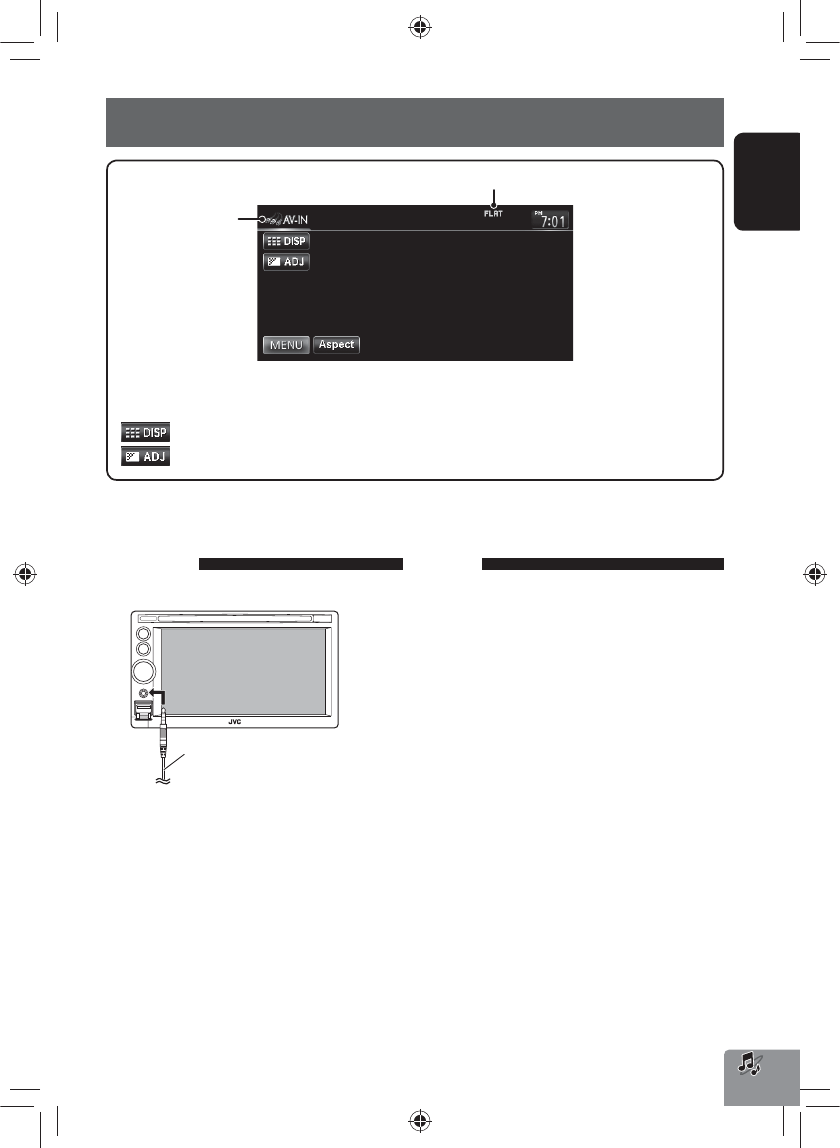
ENGLISH
69
Using other external components
Sound mode (☞ page 70)
Front AUX
1 Connect an external component.
2 Select “Front AUX” as the source.
(☞ page 44)
3 Turn on the connected component and
start playing the source.
AV mini cord (not supplied)
AV-IN
You can connect an external component to the LINE
IN/VIDEO IN jacks. (☞ Installation/Connection Manual)
1 Select “AV-IN” as the source. (☞ page 44)
2 Turn on the connected component and
start playing the source.
Source type
(“Front AUX” or
“AV-IN”)
The following buttons appear while playing video with “AV-IN” selected as the source.
[Aspect]Selects aspect ratio. (☞ page 72)
[ ]Hides/displays the operating buttons on the screen.
[ ]Adjusts the picture. (☞ page 72)
• Select an appropriate setting on <Front Aux Input> or <AV Input>. (☞ pages 74 and 75)
EN_KW-NT30_50[J].indb 69
EN_KW-NT30_50[J].indb 69
1/31/2011 3:24:33 PM
1/31/2011 3:24:33 PM
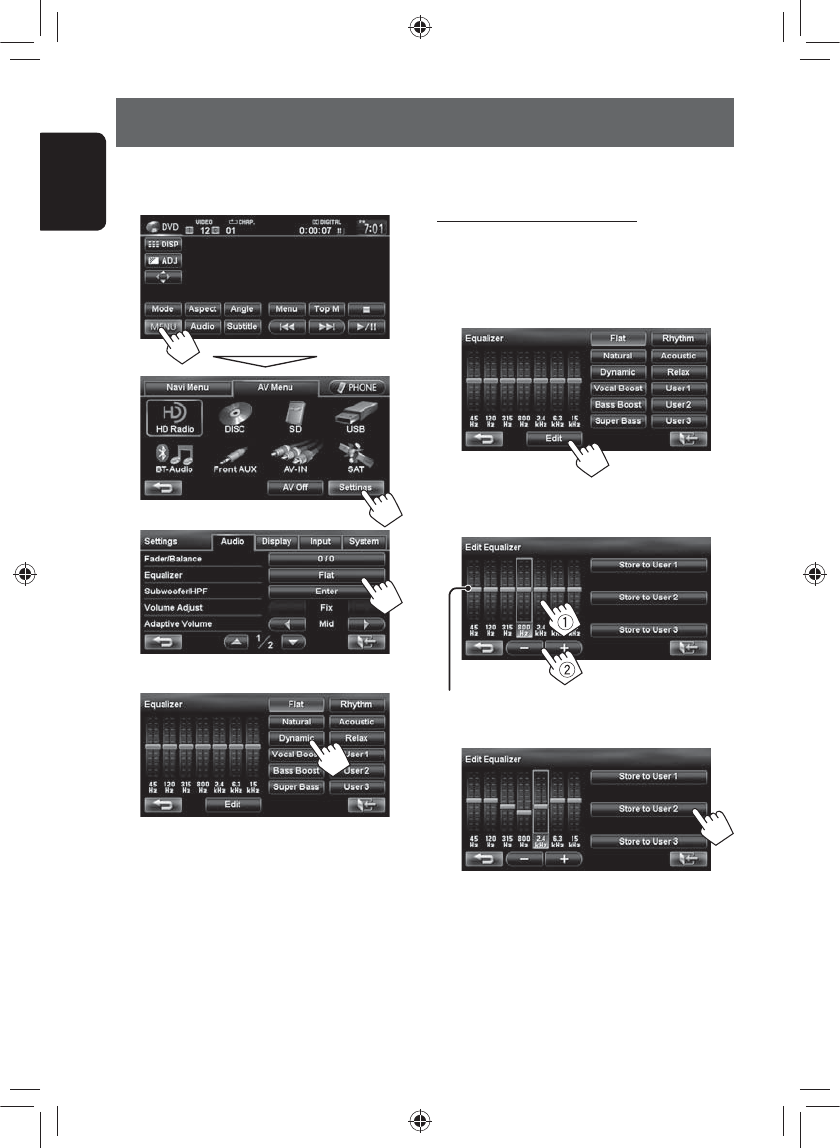
70
ENGLISH
1
2
3 Select a sound mode.
Sound equalization
Storing your own adjustments
You can store your adjustments into <User1>,
<User2>, and <User3>.
1 Repeat steps 1 and 2, then in step 3 on the
left...
2 Select the frequency (1), then adjust the
frequency level (2).
3 Store the adjustment.
You can select a preset sound mode suitable to the music genre.
You can also customize the sound mode.
Also adjusts the frequency level
EN_KW-NT30_50[J].indb 70
EN_KW-NT30_50[J].indb 70
1/31/2011 3:24:33 PM
1/31/2011 3:24:33 PM
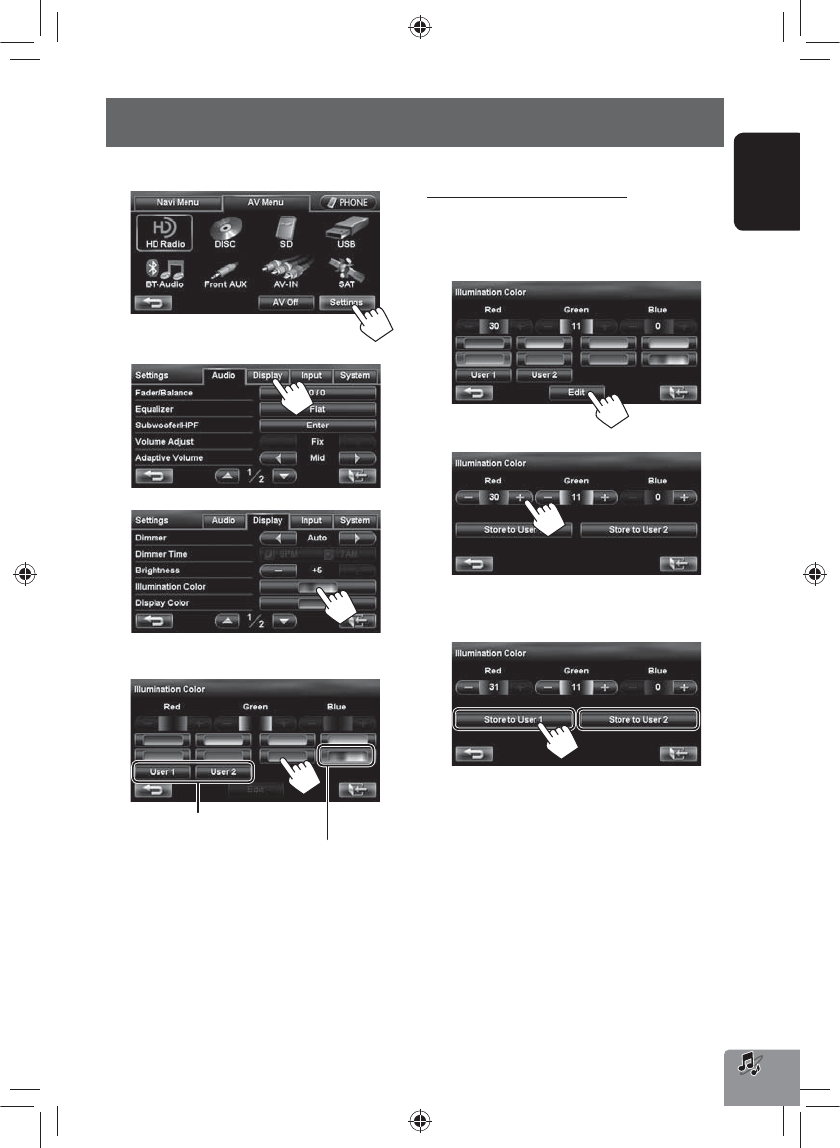
ENGLISH
71
Changing illumination color
You can change the illumination color of the buttons on the monitor panel.
1
2
3
4 Select a color.
Storing your own adjustments
• When variable color illumination is selected, you
cannot adjust the color.
1 After selecting a color in step 4 on the left...
2 Adjust the color.
3 Store the adjustment into <User1> or
<User2>.
Your own color stored (☞ right)
Variable color illumination
• Illumination color changes gradually.
EN_KW-NT30_50[J].indb 71
EN_KW-NT30_50[J].indb 71
1/31/2011 3:24:34 PM
1/31/2011 3:24:34 PM
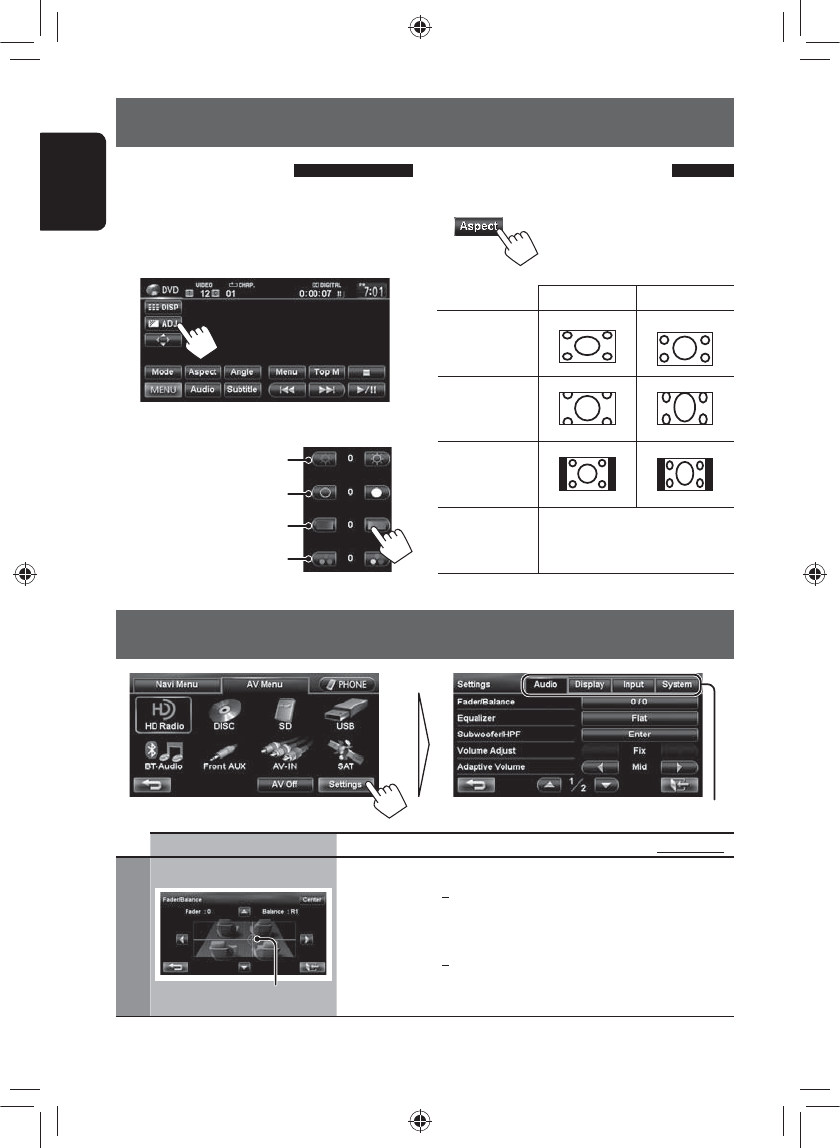
72
ENGLISH
Switches the category by pressing the corresponding tab
Settings for video playback
Picture adjustment
You can adjust the picture quality for video playback
such as DVD, iPod video, video from an external
component or camera.
1 Display the adjustment menu.
2 Adjust the picture (−5 to +5).
Adjusts the brightness
Changing the aspect ratio
You can change the aspect ratio for video playback.
4:3 signal 16:9 signal
Full:
For 16:9 original
pictures
Zoom:
For 4:3LB
original pictures
Regular:
For 4:3 original
pictures
Auto: • For “DISC” only: Aspect ratio
is automatically selected to
match to the incoming signals.
Adjusts the contrast
Adjusts the tint
Adjusts the color
AV menu items
Menu items Selectable settings Initial: Underlined
Audio
Fader/Balance Fader: Adjust the front and rear speaker output balance.
• F6 to R6; Initial 0
– When using a two-speaker system, set the fader to the center (0).
Balance: Adjust the left and right speaker output balance.
• L6 to R6; Initial 0
Press [5/∞/2/3] or drag the cursor to adjust.
• To set the fader and balance to the center (0), press [Center].
Cursor
EN_KW-NT30_50[J].indb 72
EN_KW-NT30_50[J].indb 72
1/31/2011 3:24:34 PM
1/31/2011 3:24:34 PM
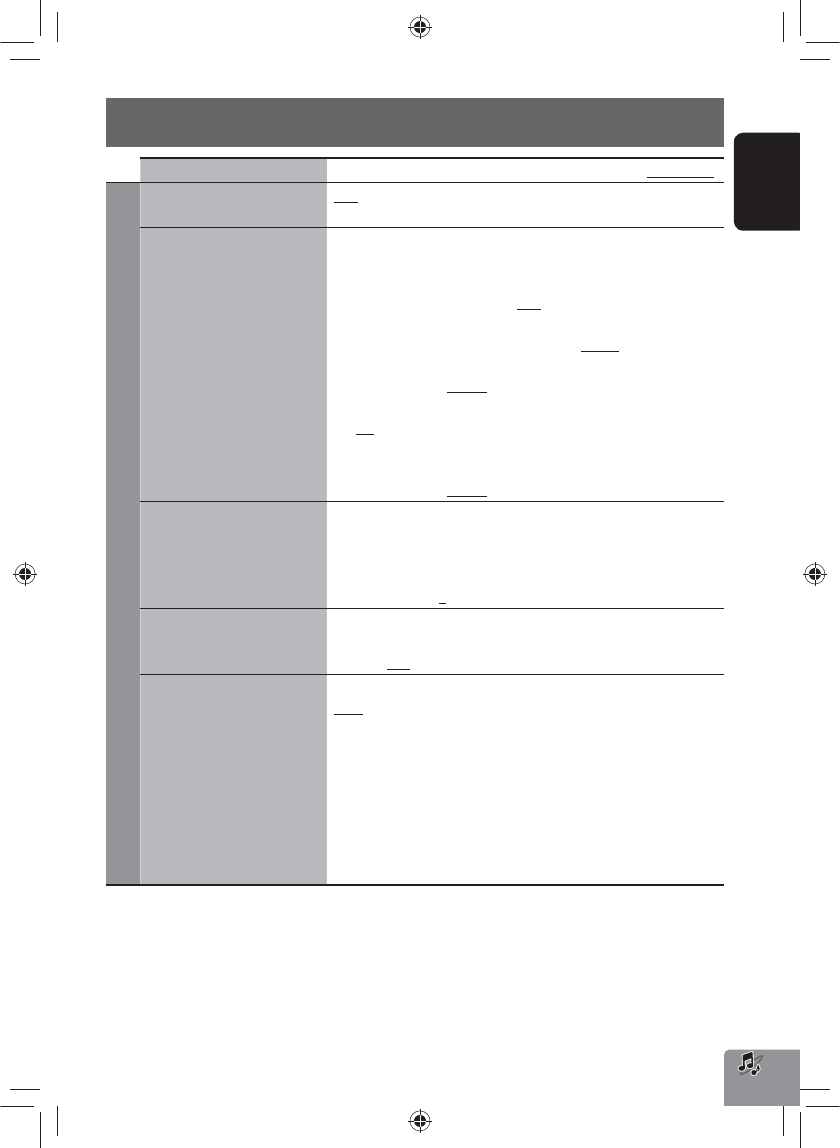
ENGLISH
73
Menu items Selectable settings Initial: Underlined
Audio
Equalizer Flat/Natural/Dynamic/Vocal Boost/Bass Boost/Super Bass/
Rhythm/Acoustic/Relax/User1/User2/User3 (☞ page 70)
Subwoofer/HPF Adjust the subwoofer output level, Low Pass Filter, and High Pass Filter.
Press [Enter] to adjust each setting.
• Subwoofer Level: Adjust the subwoofer output level.
Off, –24dB to +20dB; Initial 0dB
• LPF Frequency: Adjust the cut-off frequency of low pass filter. *
50Hz to 150Hz (in 10 Hz intervals); Initial 100Hz
• LPF Slope: Adjust the Q-slope for the low pass filter. *
–24dB, –18dB, –12dB, –6dB
• HPF Frequency: Adjust the cut-off frequency of high pass filter.
Off, 50Hz to 150Hz (in 10 Hz intervals)
• HPF Slope: Adjust the Q-slope for the high pass filter.
– Not selectable when <HPF Frequency> is <Off>.
–24dB, –18dB, –12dB, –6dB
Volume Adjust Adjust and store the auto-adjustment volume level for each source,
comparing to the FM volume level. The volume level will automatically
increase or decrease when you change the source.
• <Fix> appears if an FM broadcast is selected as the source.
–12 to +12; Initial 0
Adaptive Volume When this function is activated, the System automatically increases the
volume level (both for guidance and for audio) as the car speeds up.
Off, Min, Mid, Max
Amplifier Gain You can change the maximum volume level of this unit.
High: VOL 0 to 20 (for guidance)/VOL 00 to 50 (for audio)
Low: VOL 0 to 15 (for guidance)/VOL 00 to 30 (for audio)
(Select this if the peak power of the speakers is less than 50 W.)
Off: Deactivates the built-in amplifier (VOL 0 to 20 for guidance/VOL 00
to 50 for audio.)
• If you change this setting from <High>/<Off> to <Low> while
the volume level is set higher than the maximum level of <Low>,
the unit automatically lowers the volume level (guidance: VOL 15/
audio: VOL 30).
* Not selectable when the <Subwoofer Level> is <Off>.
AV menu items
Continued on the next page
EN_KW-NT30_50[J].indb 73
EN_KW-NT30_50[J].indb 73
1/31/2011 3:24:35 PM
1/31/2011 3:24:35 PM
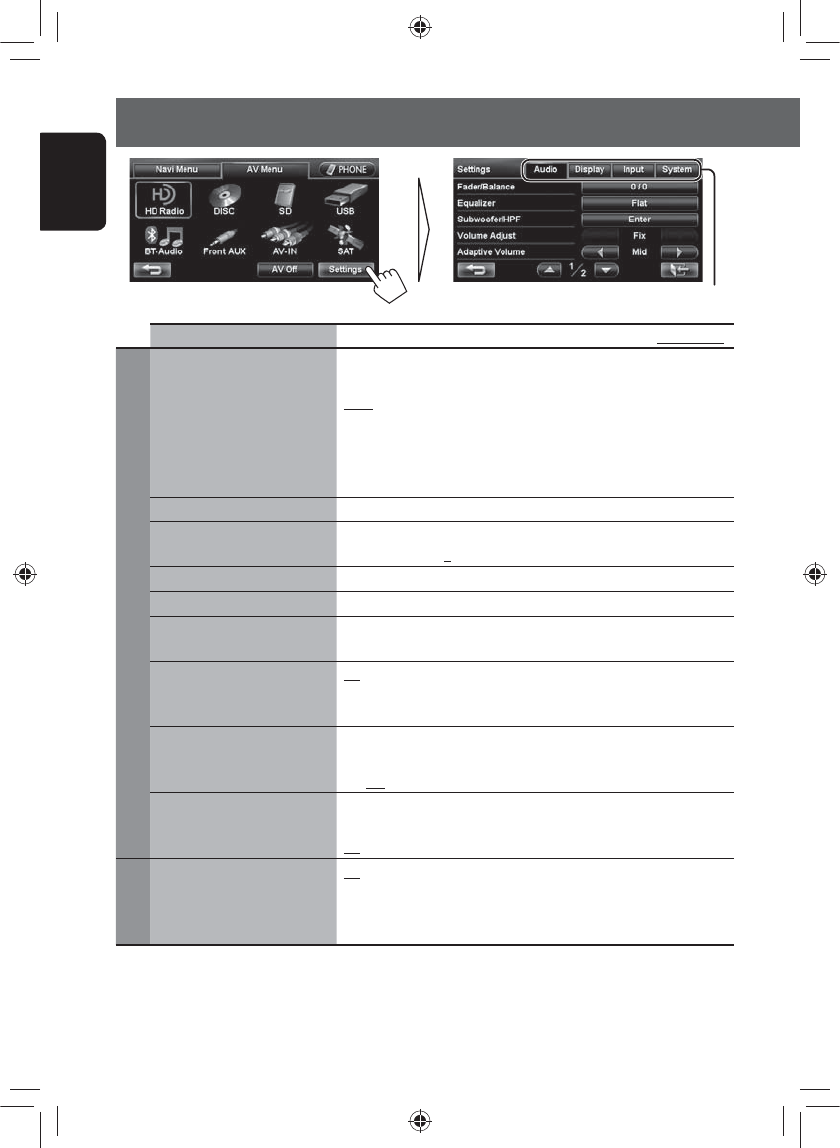
74
ENGLISH
Menu items Selectable settings Initial: Underlined
Display
Dimmer Off: Cancels.
On: Activates dimmer.
Auto: Dims the screen and the button illumination when you turn on
the headlights.
• The illumination control lead connection is required. (☞
Installation/Connection Manual)
Time: Activates the Dimmer Time setting below.
Dimmer Time Sets the Dimmer On/Off times.
Brightness Adjust the display brightness.
–5 to +5; Initial +5
Illumination Color ☞ page 71
Display Color Select the color of the bars and buttons on the touch panel.
Wallpaper Select the display background from one of five choices. Press 5/∞ to
select a background and press [OK].
Clock on Video/Screen-Off On: The clock time is displayed while video source is played back or the
screen is turned off.
Off: Cancels.
Off-axis Viewing Select <On> if the screen is hard to see due to the installation angle or
position.
On, Off
Demonstration This setting will be deactivated and disappear from the menu when the
System detects the first car movement.
On, Off
Input
Front Aux Input On: Select when connecting an audio component to the AUX input
terminal on the monitor panel.
Off *: Select when no audio component is connected (“Front AUX” is not
selectable).
* Not selectable when the input is selected as the source.
AV menu items
Switches the category by pressing the corresponding tab
EN_KW-NT30_50[J].indb 74
EN_KW-NT30_50[J].indb 74
1/31/2011 3:24:35 PM
1/31/2011 3:24:35 PM

ENGLISH
75
Menu items Selectable settings Initial: Underlined
Input
AV Input You can determine the use of the LINE IN and VIDEO IN jacks.
(☞ page 69)
AV: Select when connecting an AV component such as a camcorder.
Audio: Select when connecting an audio component such as a portable
audio player.
Off *1: Select when no component is connected (“AV-IN” is not
selectable).
Bluetooth Audio On: Activates “BT Audio” for source selection.
Off *1: Deactivates “BT Audio” for source selection (“BT Audio” is not
selectable).
Camera Input *2On, Off (☞ page 87)
Reverse Signal Polarity *2Battery, GND (☞ page 9)
System
Language Select the language used for on-screen information and voice guidance.
English, Español, Français
Time Format 12 Hours, 24 Hours
Time Zone *2Select your residential area from one of the following time zones for
clock adjustment.
Hawaii (UTC–10:00), Alaska (UTC–09:00), Pacific (UTC–08:00),
Mountain (UTC–07:00), Central (UTC–06:00),
Eastern (UTC–05:00), Atlantic (UTC–04:00),
Newfoundland (UTC–03:30)
DST (Daylight Saving Time) *2Activate this if your residential area is subject to DST.
Auto : Activates daylight saving time.
Off : Cancels.
Beep Adjust the volume of the key-touch tone.
Off, 1 to 10; Initial 5
Startup Message Edit the voice message at startup/shutdown of the unit.
• To edit the message, press [Edit], enter the message, then press [OK].
You can listen to the edited message by pressing [Test].
– For entering the characters, ☞ page 11.
Shutdown Message
Startup Screen Select the startup screen when the power is turned on.
Restore Factory Default Initialize all settings you have made. Press [Restore] to initialize the
settings.
• When restoring the settings, adjust the settings on installation setting
screen (☞ page 9).
*1 Not selectable when the input is selected as the source.
*2 The setting varies depending on the installation settings (☞ page 9).
AV menu items
EN_KW-NT30_50[J].indb 75
EN_KW-NT30_50[J].indb 75
1/31/2011 3:24:36 PM
1/31/2011 3:24:36 PM
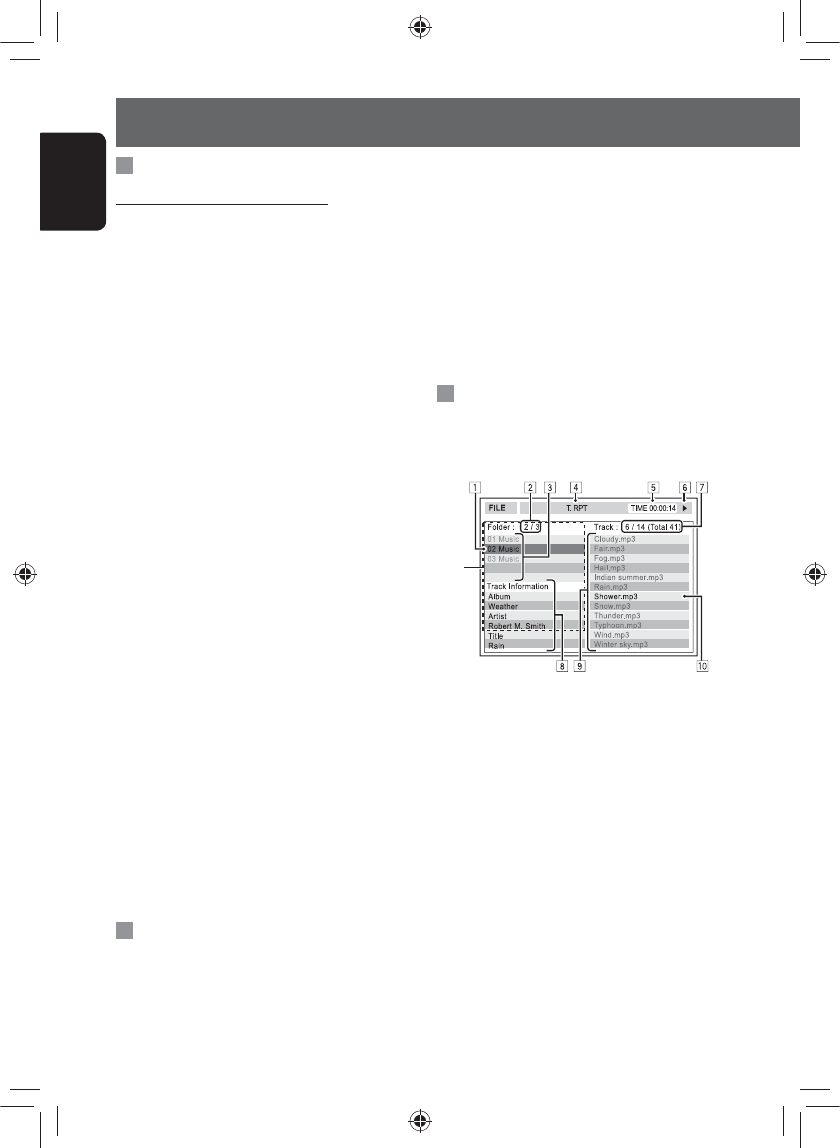
76
ENGLISH
Additional information
*1
• Do not use a USB device with 2 or more partitions.
• Depending on the shape of the USB devices and
connection ports, some USB devices may not be
attached properly or the connection might be loose.
• This unit may not recognize a memory card inserted
into the USB card reader.
• Connect only one USB device to the unit at a time. Do
not use a USB hub.
• When connecting with a USB cable, use the USB 2.0
cable.
Disc information shown on the
external monitor
The following screens appear only on the external
monitor.
1 Current folder (highlighted) *2
2 Current folder number/total folder number *2
3 Folder list *2
4 Selected playback mode
5 Elapsed playing time of the current track
6 Operation status
7 CD: Current track number/total number of
tracks on the disc
MP3/WAV: Current track number/total
number of tracks in the current folder
8 Track information
9 Track list
p Current track (highlighted)
*1 If tag data includes “Jacket Picture” (baseline JPEG), it
will be displayed.
*2 Only for MP3/WAV
File playback
Playing MP3/WMA*1/WAV *2 files
• This unit can play back files with the extension code
<.mp3>, <.wma>, or <.wav> (regardless of the
letter case—upper/lower).
• This unit can play back the files meeting the
conditions below:
– Bit rate:
MP3/WMA: 32 kbps — 320 kbps
– Sampling frequency:
MP3: 48 kHz, 44.1 kHz, 32 kHz
24 kHz, 22.05 kHz, 16 kHz
WMA: 48 kHz, 44.1 kHz, 32 kHz, 22.05 kHz
WAV: 44.1 kHz
• This unit can show ID3 Tag Version
1.0/1.1/2.2/2.3/2.4 (for MP3).
– ID3 Tag Version 2.4 is not available for SD/USB
playback.
• This unit can also show WAV/WMA Tag.
• This unit can play back files recorded in VBR (variable
bit rate).
• Files recorded in VBR have a discrepancy in elapsed
time indication.
• This unit cannot play back the following files:
– MP3 files encoded with MP3i and MP3 PRO
format.
– MP3 files encoded with Layer 1/2.
– WMA files encoded with lossless, professional,
and voice format.
– WMA files which are not based upon Windows
Media® Audio.
– WMA files copy-protected with DRM.
*1 WMA files are played only when recorded on a USB
device or SD card.
*2 WAV files are played only when recorded on a disc.
USB
• This unit cannot recognize a USB device whose rating
is other than 5 V and exceeds 1 A.
• USB devices equipped with special functions such as
data security functions cannot be used with the unit.
EN_KW-NT30_50[J].indb 76
EN_KW-NT30_50[J].indb 76
1/31/2011 3:24:36 PM
1/31/2011 3:24:36 PM
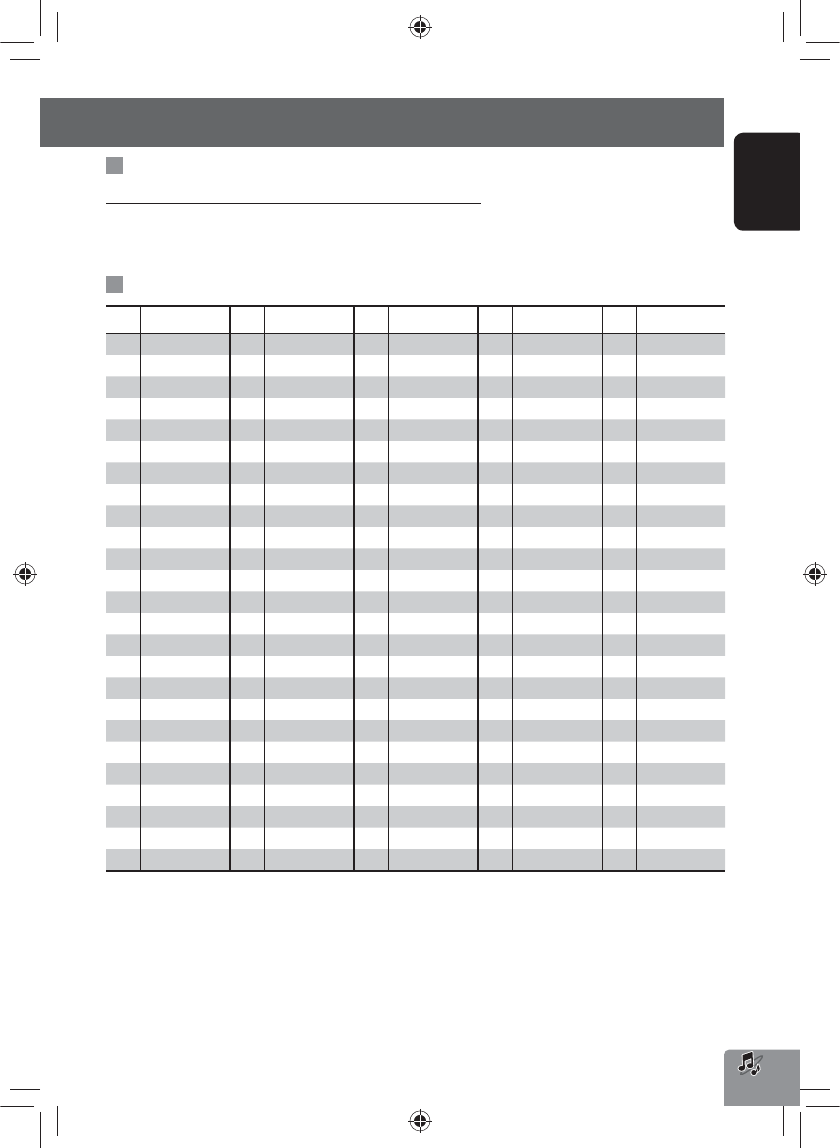
ENGLISH
77
Sound signals emitted through the rear terminals
Through the analog terminals (Speaker out/F OUT/R OUT)
2-channel signal is emitted. When playing multi-channel encoded disc, multi-channel signals are downmixed.
• DTS sound cannot be reproduced.
Language codes (for DVD language selection)
Code Language Code Language Code Language Code Language Code Language
AA Afar FA Persian KK Kazakh NO Norwegian ST Sesotho
AB Abkhazian FI Finnish KL Greenlandic OC Occitan SU Sundanese
AF Afrikaans FJ Fiji KM Cambodian OM (Afan) Oromo SW Swahili
AM Ameharic FO Faroese KN Kannada OR Oriya TA Tamil
AR Arabic FY Frisian KO Korean (KOR) PA Panjabi TE Telugu
AS Assamese GA Irish KS Kashmiri PL Polish TG Tajik
AY Aymara GD Scots Gaelic KU Kurdish PS Pashto, Pushto TH Thai
AZ Azerbaijani GL Galician KY Kirghiz QU Quechua TI Tigrinya
BA Bashkir GN Guarani LA Latin RM
Rhaeto-Romance
TK Turkmen
BE Byelorussian GU Gujarati LN Lingala RN Kirundi TL Tagalog
BG Bulgarian HA Hausa LO Laothian RO Rumanian TN Setswana
BH Bihari HI Hindi LT Lithuanian RW Kinyarwanda TO Tonga
BI Bislama HR Croatian LV Latvian, Lettish SA Sanskrit TR Turkish
BN Bengali, Bangla HU Hungarian MG Malagasy SD Sindhi TS Tsonga
BO Tibetan HY Armenian MI Maori SG Sangho TT Tatar
BR Breton IA Interlingua MK Macedonian SH Serbo-Croatian TW Twi
CA Catalan IE Interlingue ML Malayalam SI Singhalese UK Ukrainian
CO Corsican IK Inupiak MN Mongolian SK Slovak UR Urdu
CS Czech IN Indonesian MO Moldavian SL Slovenian UZ Uzbek
CY Welsh IS Icelandic MR Marathi SM Samoan VI Vietnamese
DZ Bhutani IW Hebrew MS Malay (MAY) SN Shona VO Volapuk
EL Greek JA Japanese MT Maltese SO Somali WO Wolof
EO Esperanto JI Yiddish MY Burmese SQ Albanian XH Xhosa
ET Estonian JW Javanese NA Nauru SR Serbian YO Yoruba
EU Basque KA Georgian NE Nepali SS Siswati ZU Zulu
Additional information
EN_KW-NT30_50[J].indb 77
EN_KW-NT30_50[J].indb 77
1/31/2011 3:24:36 PM
1/31/2011 3:24:36 PM
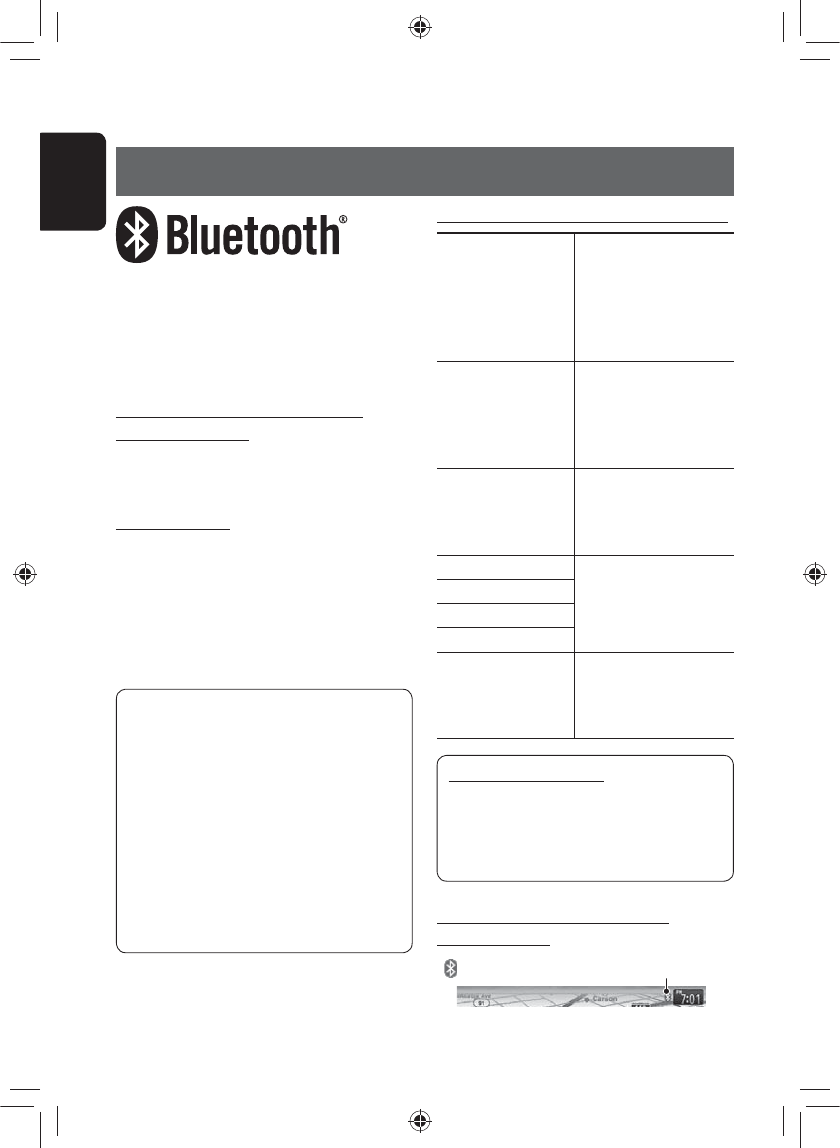
78
ENGLISH
Information for using Bluetooth® devices
Bluetooth is a short-range wireless radio
communication technology for the mobile device such
as mobile phones, portable PCs, and other devices. The
Bluetooth devices can be connected without cables and
communicate with each other.
The countries where you may use the
Bluetooth® function
• United States of America
• Canada
Bluetooth profile
This unit supports the following Bluetooth profiles;
• HFP (Hands-Free Profile) 1.5
• OPP (Object Push Profile) 1.1
• PBAP (Phonebook Access Profile) 1.0
• A2DP (Advanced Audio Distribution Profile) 1.2
• AVRCP (Audio/Video Remote Control Profile) 1.3
• Some operations are not available while driving.
When you perform operations, stop your car in a
safe place.
• Some Bluetooth devices may not be connected to
this unit depending on the Bluetooth version of
the device.
• This unit may not work for some Bluetooth
devices.
• Connecting condition may vary depending on
circumstances around you.
• When the unit is turned off, the device is
disconnected.
Bluetooth Information:
If you wish to receive more information about
Bluetooth, visit the following JVC web site:
<http://www.jvc.co.jp/english/car/> (English
website only)
Warning messages for Bluetooth operations
“Cannot connect. Please
connect from your
device.”
The device is registered but
the connection has failed.
Connect from your phone, or
use <Connect> to connect
the device again (☞ page
80).
“System can not connect
with this device. Please
disconnect current
device, then connect
from this device.”
Disconnect the current
device, then operate another
device to connect.
“System can not connect
with this device. Please
connect from the
device.”
Operate the device to
connect.
“Pairing Error.” The operation you have tried
cannot be completed. Try
the operation again.
“Connect error.”
“Disconnect error.”
“Delete error.“
“Memory full.” You have tried to copy a
501st phone book entry.
Delete unwanted names
before copying.
To check the connection status of a
Bluetooth device
Bluetooth Operations
indicator appears when a Bluetooth device is connected
EN_KW-NT30_50[J].indb 78
EN_KW-NT30_50[J].indb 78
1/31/2011 3:24:36 PM
1/31/2011 3:24:36 PM
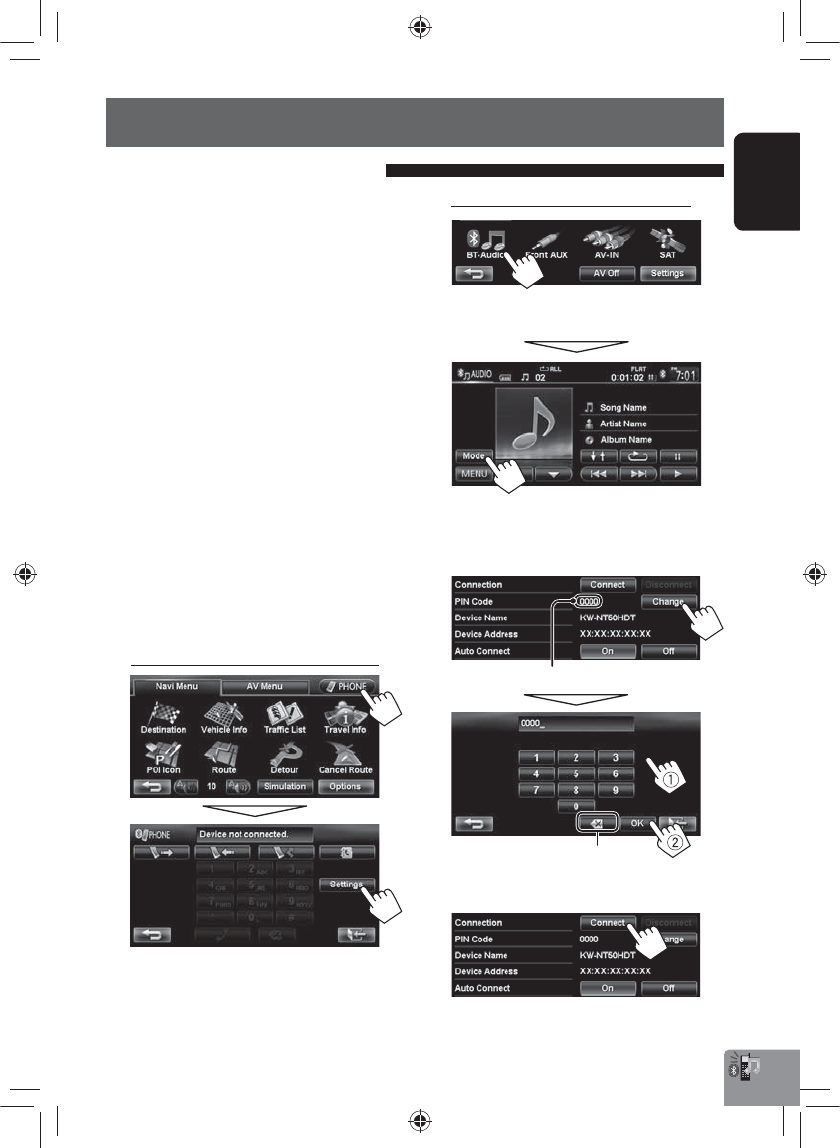
ENGLISH
79
Using Bluetooth device
To connect a Bluetooth device for the
first time
When you connect a Bluetooth device to the unit
for the first time, make pairing between the unit
and the device. Pairing allows Bluetooth devices to
communicate each other.
• Once you register a Bluetooth device, the device
remains registered until the registration is deleted.
(☞ page 80)
• Up to 5 devices can be registered in total.
• Only one device for Bluetooth phone and one for
Bluetooth audio can be connected at a time.
• To use the Bluetooth function, you need to turn on
Bluetooth function of the device.
The sample screen shown here depicts the KW-NT50HDT.
When using the KW-NT30HD, the Device Name displayed
is “KW-NT30HD”.
1 Operate the Bluetooth device to turn on its
Bluetooth function.
2 Display the Bluetooth setting screen.
For connecting a Bluetooth mobile phone
<Phone Settings> is displayed.
Registering a Bluetooth device
PIN code (initial: 0000)
For connecting a Bluetooth audio player
• To activate “BT Audio” for source selection, ☞
page 75 (<Bluetooth Audio>).
<Mode> is displayed.
3 Change the PIN code.
• If you skip changing PIN code, go to step 4.
4
Continued on the next page
Press: Deletes last character
Hold: Deletes all characters
EN_KW-NT30_50[J].indb 79
EN_KW-NT30_50[J].indb 79
1/31/2011 3:24:36 PM
1/31/2011 3:24:36 PM
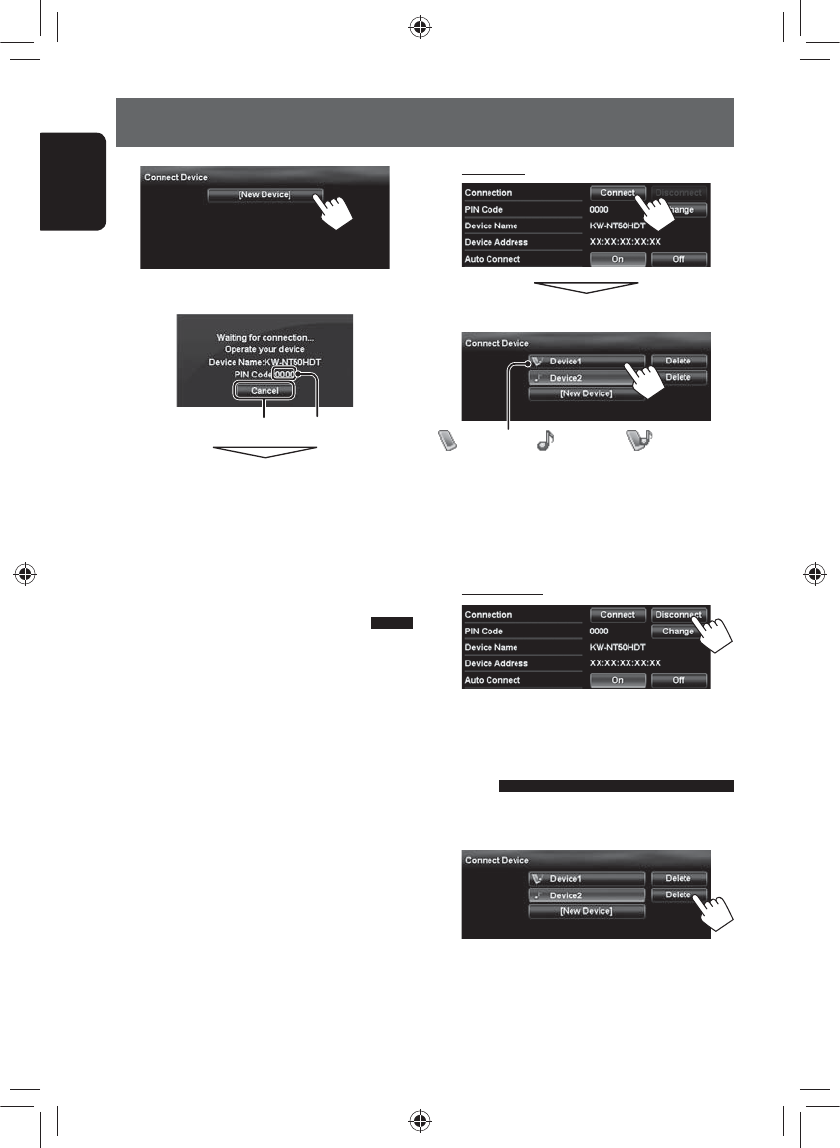
80
ENGLISH
Using Bluetooth device
2 To connect
Select the device you want to connect.
• All registered devices (mobile phone and audio
player) are listed on <Connect Device>.
– Selectable items depend on the device you are
operating.
To disconnect
A confirmation message appears.
Deleting a registered Bluetooth
device
Select a device whose registration you want to
delete on <Connect Device> (☞ step 2 above).
A confirmation message appears.
5
6 Operate the Bluetooth device to connect.
“Connected” appears. Press [OK] to confirm the
operation.
Now connection is established and you can use the
Bluetooth device through the unit.
Connecting/disconnecting a
registered Bluetooth device
1 Display the Bluetooth setting screen. (☞
page 86)
• For Bluetooth mobile phone: <Phone
Settings>
• For Bluetooth audio player: <Mode>
Cancel PIN code (initial: 0000) : mobile phone / : audio player / : both mobile
phone and audio player
EN_KW-NT30_50[J].indb 80
EN_KW-NT30_50[J].indb 80
1/31/2011 3:24:37 PM
1/31/2011 3:24:37 PM
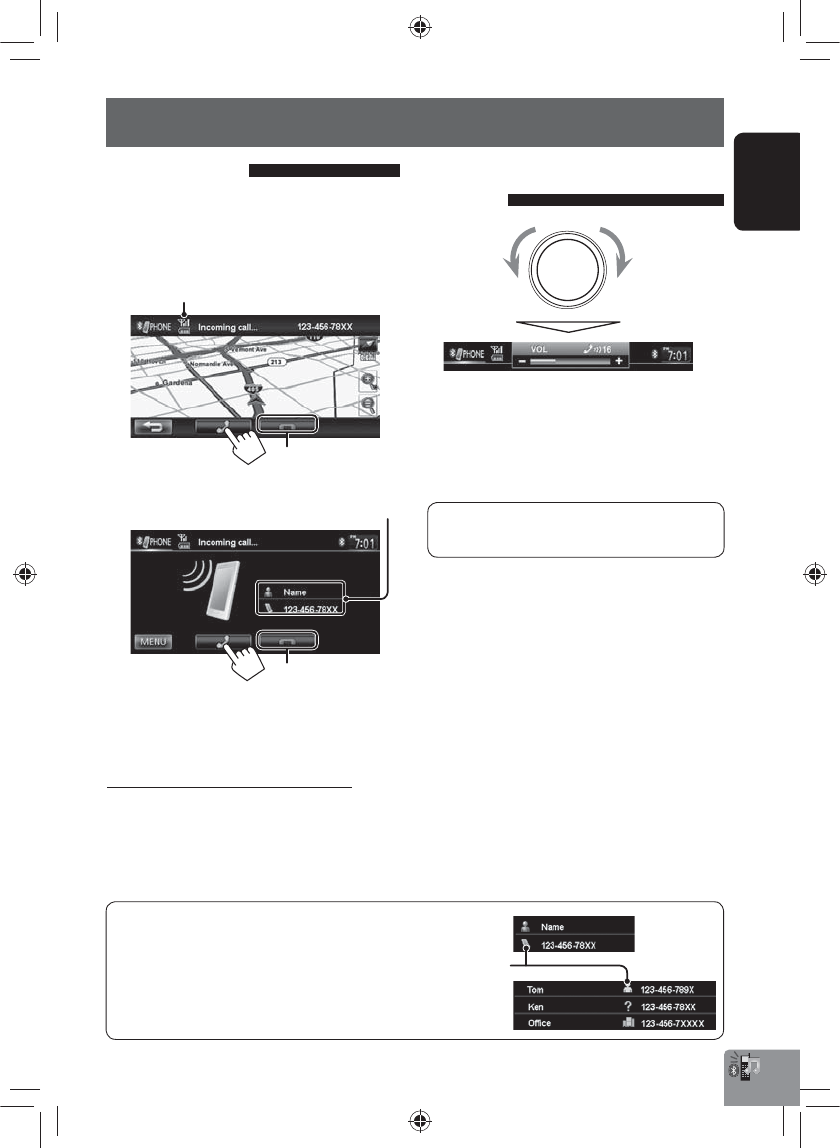
ENGLISH
81
Using Bluetooth mobile phone
Status of the device /Battery reminder (only when the
information comes from the device)
Receiving a call
When a call comes in/making a call...
On map screen:
The mobile phone control bars appear.
On AV screen:
•
Phone operation is not available while the picture
from the rear view camera is displayed (☞ page 87).
When <Auto Answer> is set to <On>
The unit answers the incoming call automatically.
(☞ page 86)
Adjusting the volume of calls/
earpiece
• This adjustment does not affect the volume level of
the other sources.
• About the adjustable volume range, ☞ page 73
(<Amplifier Gain>).
Call information (if acquired)
IncreaseDecrease
Ends/rejects the call
Ends/rejects the call
This adjustment does not affect the microphone
volume. It is adjusted automatically.
About icons for category of the phone number
Icons which indicate the category of the phone
number appear when the phone number is shown.
The category icons shown may differ depending on
the connected mobile phone.
Category icon
EN_KW-NT30_50[J].indb 81
EN_KW-NT30_50[J].indb 81
1/31/2011 3:24:38 PM
1/31/2011 3:24:38 PM
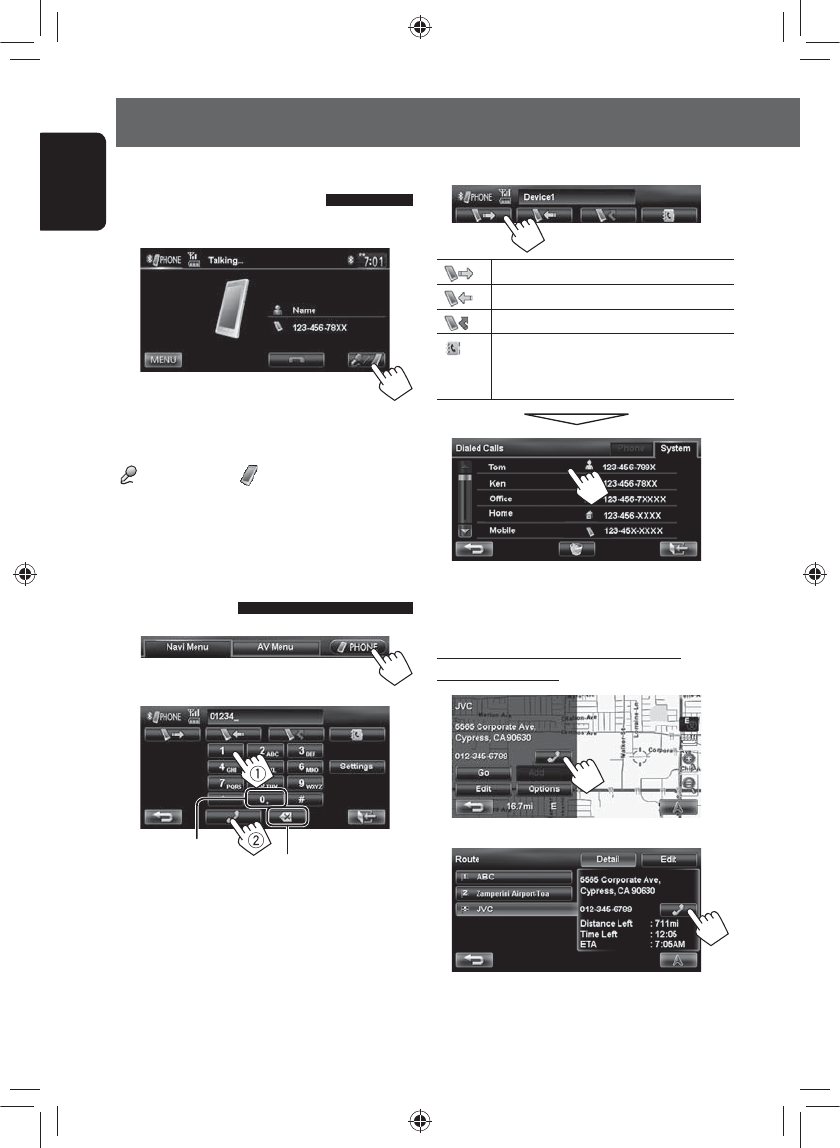
Tentative
82
ENGLISH
Switching between handsfree
mode and phone mode
While talking...
Each time you press the button, the talking method is
switched. The corresponding indicator lights in orange
(: handsfree mode / : phone mode).
• The call may end automatically when switching to
the phone mode, depending on the type of mobile
phone.
Making a call
1
2
• You can enter up to 30 numbers.
Using Bluetooth mobile phone
Using the phone book/call lists
[ ] From dialed call list.
[ ] From received call list.
[ ] From missed call list.
[ ] From phone book.
• For copying the phone book, ☞ page 83.
• For searching for a number, ☞ page 83.
• If your mobile phone is compatible with Phone Book
Access Profile (PBAP), ☞ page 84.
Making a call while operating on the
navigation system
Press: Deletes last character
Hold: Deletes all characters
Hold: Adds “+”
or
EN_KW-NT30_50[J].indb 82
EN_KW-NT30_50[J].indb 82
1/31/2011 3:24:38 PM
1/31/2011 3:24:38 PM
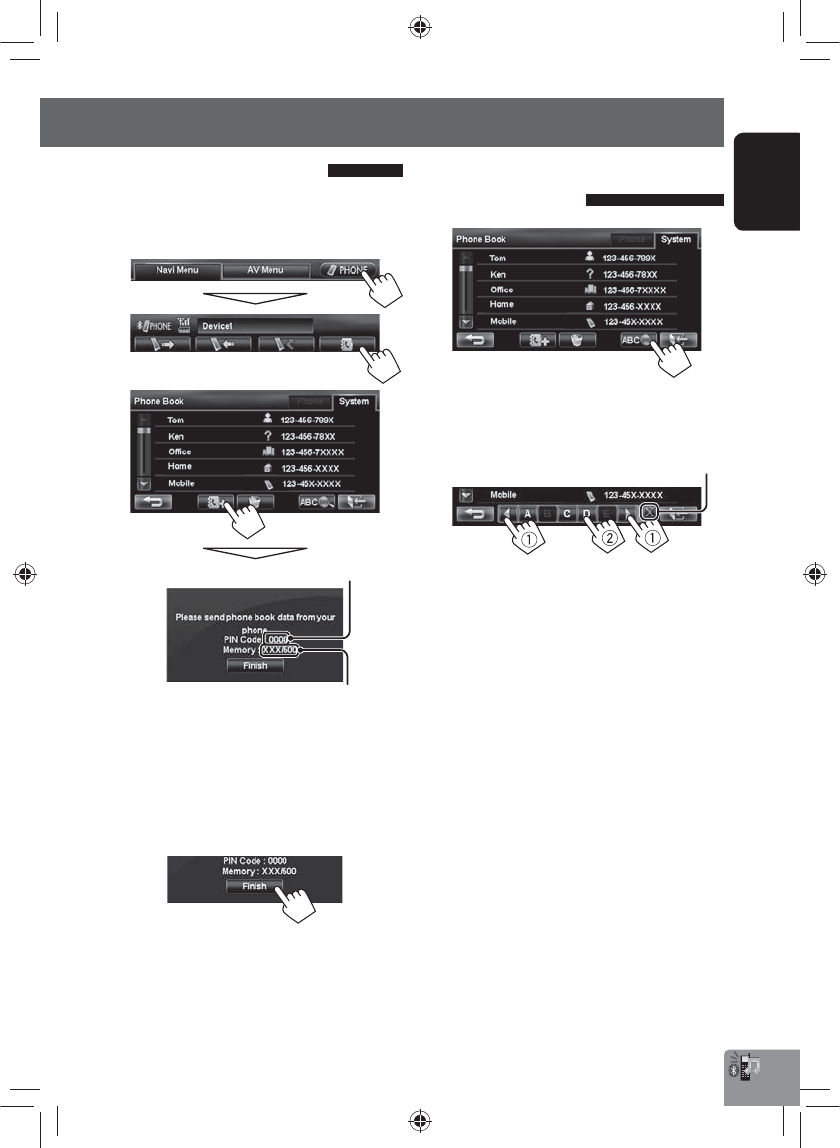
ENGLISH
83
Copying the phone book
You can copy the phone book memory of a mobile
phone into the unit (up to 500 memories).
1 Display <Phone Book>.
2
3 Operate the target mobile phone.
• Refer to the instruction manual supplied with
your mobile phone.
• To cancel the transfer, press [Finish].
4 Finish the procedure.
The phone book memory is copied from the mobile
phone.
Searching for a phone number
from phone book
1
2 Display the first character of the name you
want to search for (1), then search for a
name (2).
Press the character button repeatedly until the
desired item is displayed.
• Only available characters are selectable.
• When selecting other character than the
alphabet, press [#].
3 Select the phone number to call from the list.
Numbers of the phone book memories copied
PIN code (initial: 0000)
Erases the search operation buttons
Using Bluetooth mobile phone
EN_KW-NT30_50[J].indb 83
EN_KW-NT30_50[J].indb 83
1/31/2011 3:24:39 PM
1/31/2011 3:24:39 PM
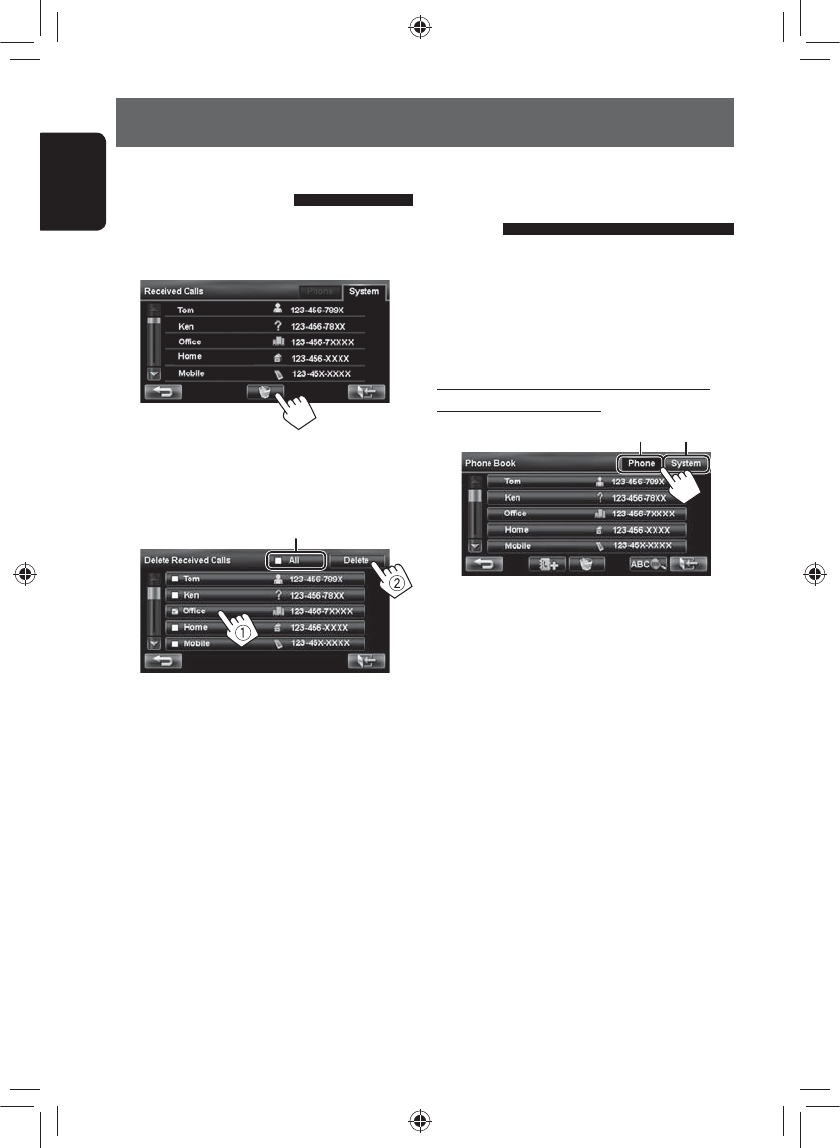
84
ENGLISH
About mobile phone compatible
with Phone Book Access Profile
(PBAP)
When your mobile phone supports PBAP, phone book
and call lists are automatically copied to the unit.
• Phone book: up to 5 000 entries
• Dialed calls, received calls, and missed calls: up to 50
entries each
To display the phonebook/call lists of the
mobile phone or the unit
Deleting the phone number
memory in the unit
1 Display the phone book/call list you want to
delete. (☞ page 82)
2
3 Select the items to delete (1), then delete
them (2).
• The selected items are marked with “✔.”
A confirmation message appears.
Selects/deselects all items
Using Bluetooth mobile phone
Connected mobile phone Unit
EN_KW-NT30_50[J].indb 84
EN_KW-NT30_50[J].indb 84
1/31/2011 3:24:40 PM
1/31/2011 3:24:40 PM
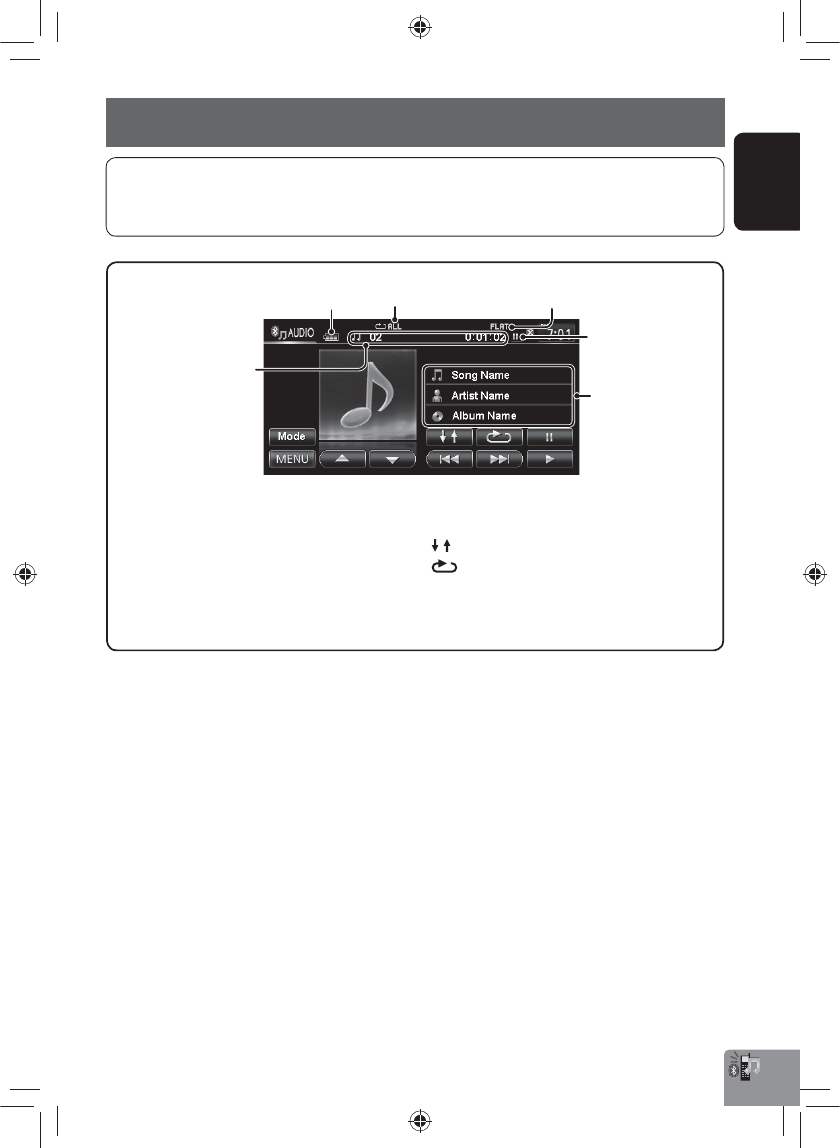
ENGLISH
85
Using Bluetooth audio player
* To cancel random or repeat mode, press the button repeatedly until the indicator disappears.
Playback mode Sound mode (☞ page 70)
[3] Starts playback.
[8] Pauses.
[4] [¢] Selects track.
[5] [∞] Selects the group. (Works only when
the device supports the function.)
Tag data (current track
title/artist name/album
title)
Playback status
(3: play/8: pause)
[ ] Selects Random playback mode. *
[]Selects Repeat playback mode. *
[Mode] Displays the Bluetooth setting
screen. (☞ page 86)
Battery reminder (only when the information
comes from the device)
• To activate “BT Audio” for source selection, ☞ page 75 (<Bluetooth Audio>).
• To register a new device, ☞ page 79.
• To connect/disconnect a device, ☞ page 80.
Track no./Playing time
• The operating buttons, indicators and information displayed on the screen differ depending on the connected
device.
EN_KW-NT30_50[J].indb 85
EN_KW-NT30_50[J].indb 85
1/31/2011 3:24:40 PM
1/31/2011 3:24:40 PM
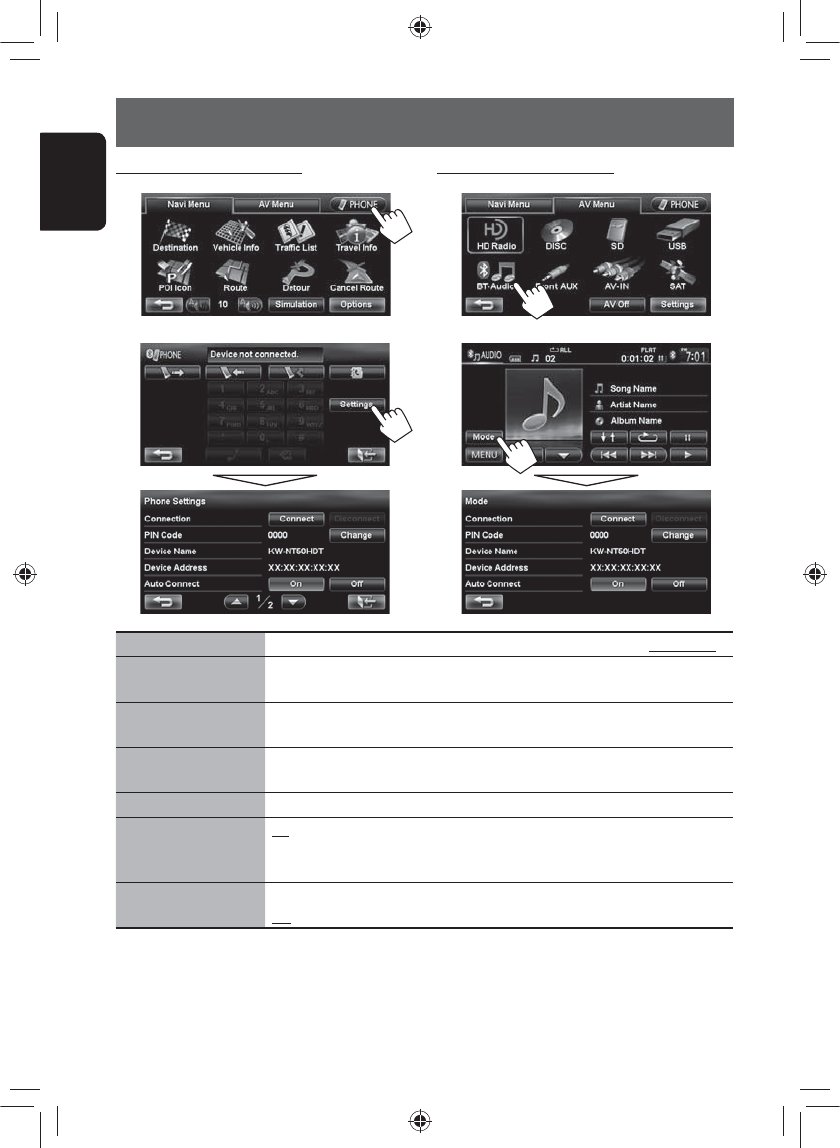
86
ENGLISH
For Bluetooth mobile phone
1
2
For Bluetooth audio player
1
2
Menu items Selectable settings Initial: Underlined
Connection Connect: ☞ page 80
Disconnect: ☞ page 80
PIN Code Displays the PIN code of the unit.
• To change the PIN code, press [Change], enter a new PIN code, then press [OK].
Device Name Shows the device name to be shown on the Bluetooth device — “KW-NT50HDT” or
“KW-NT30HD.”
Device Address Shows the MAC address of the unit.
Auto Connect On: The connection is automatically established with the last connected Bluetooth
device when the unit is turned on.
Off: Cancels.
Auto Answer*On: The unit answers the incoming calls automatically.
Off: The unit does not answer the calls automatically. Answer the calls manually.
* Appears only for <Phone Settings>.
Bluetooth device settings
EN_KW-NT30_50[J].indb 86
EN_KW-NT30_50[J].indb 86
1/31/2011 3:24:41 PM
1/31/2011 3:24:41 PM
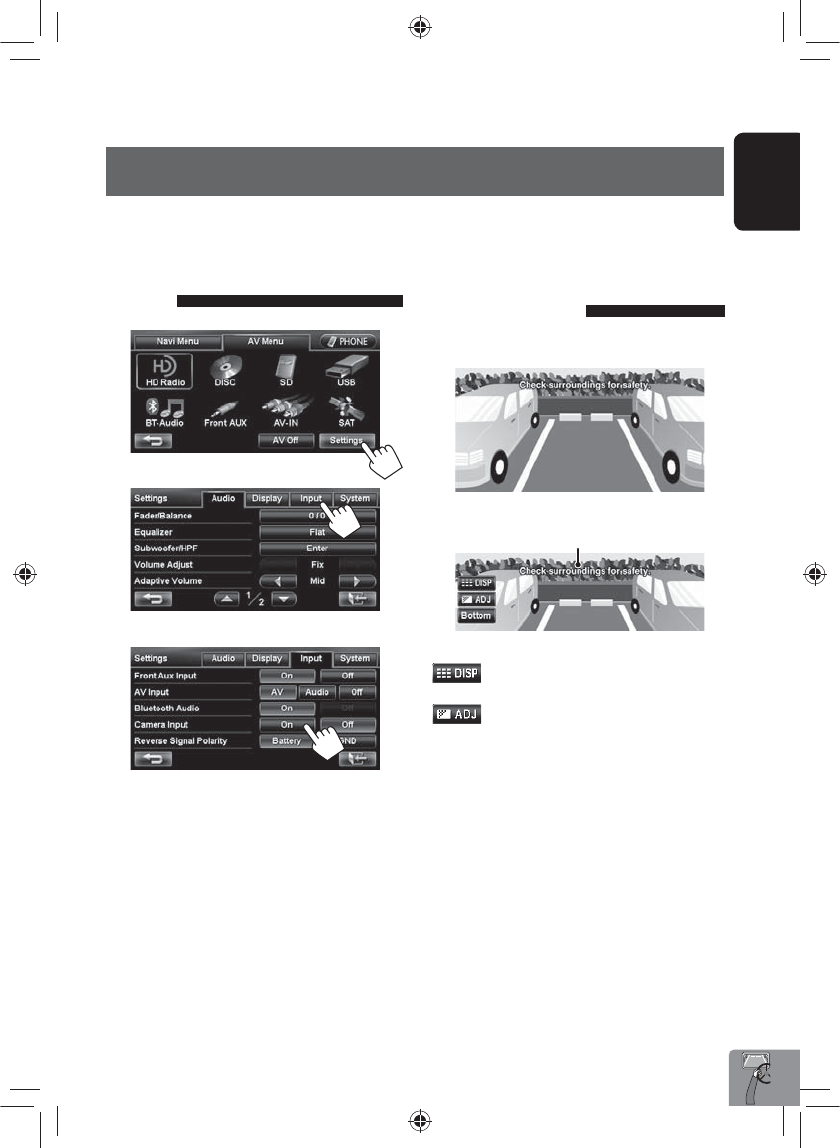
ENGLISH
87
Using a rear view camera
• To use a rear view camera, the reverse gear signal lead connection is required. For connecting a rear view camera,
☞ Installation/Connection Manual.
Activating the rear view
camera
1
2
3
To deactivate the rear view camera, select <Off>
for <Camera Input>.
Rear View Camera Operations
Displaying the picture from the
rear view camera
The rear view screen is displayed when you shift the
gear to the reverse (R) position.
To display the operating buttons, touch the screen.
[ ]Hides/displays the operating buttons
on the screen.
[ ]Adjusts the picture. (☞ page 72)
[Bottom][Top] Adjusts the position of the caution
message.
Caution message
EN_KW-NT30_50[J].indb 87
EN_KW-NT30_50[J].indb 87
1/31/2011 3:24:41 PM
1/31/2011 3:24:41 PM
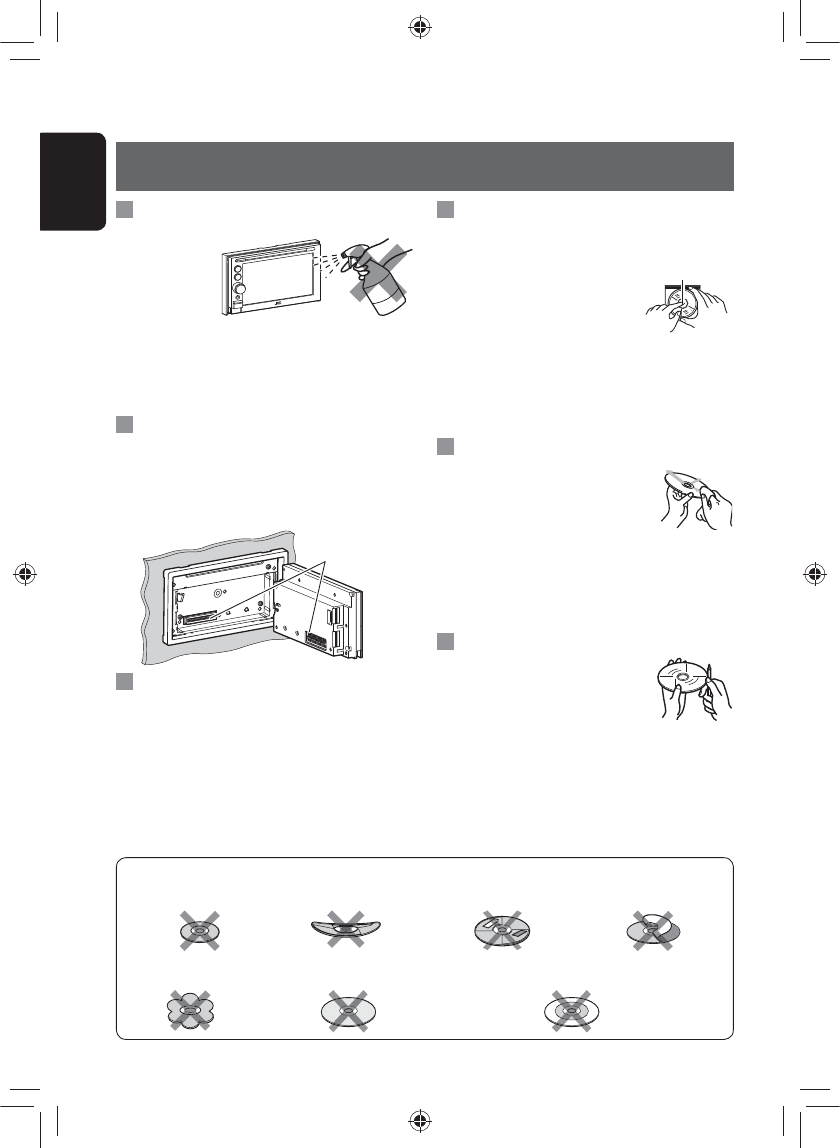
ENGLISH
88
Do not use the following discs:
Maintenance
Caution on cleaning the unit
Do not use any
solvent (for
example, thinner,
benzine, etc.),
detergent, or
insecticide. This may damage the monitor or the unit.
Recommended cleaning method:
Gently wipe the panel with a soft, dry cloth.
How to clean the connector
Frequent detachment will deteriorate the connectors.
To minimize this possibility, periodically wipe the
connectors with a cotton swab or cloth moistened with
alcohol, being careful not to damage the connectors.
Moisture condensation
Moisture may condense on the lens inside the unit in
the following cases:
• After starting the heater in the car.
• If it becomes very humid inside the car.
Should this occur, the unit may malfunction. In this
case, eject the disc and leave the unit turned on for a
few hours until the moisture evaporates.
How to handle discs
When removing a disc from its case, press down the
centre holder of the case and lift the
disc out, holding it by the edges.
• Always hold the disc by the edges.
Do not touch its recording surface.
When storing a disc into its case,
gently insert the disc around the centre holder (with the
printed surface facing up).
• Make sure to store discs into the cases after use.
To keep discs clean
A dirty disc may not play correctly.
If a disc does become dirty, wipe it with
a soft cloth in a straight line from centre
to edge.
• Do not use any solvent (for example, conventional
record cleaner, spray, thinner, benzine, etc.) to clean
discs.
To play new discs
New discs may have some rough spots
around the inner and outer edges. If
such a disc is used, this unit may reject
the disc.
To remove these rough spots, rub the edges with a
pencil or ball-point pen, etc.
Stick-on labelSticker and sticker residue
Unusual shape
Warped discSingle CD—8 cm (3-3/16”) disc
C-thru Disc (semi-transparent disc) Transparent or semi-transparent on its recording area
Centre holder
Connectors
References
EN_KW-NT30_50[J].indb 88
EN_KW-NT30_50[J].indb 88
1/31/2011 3:24:42 PM
1/31/2011 3:24:42 PM
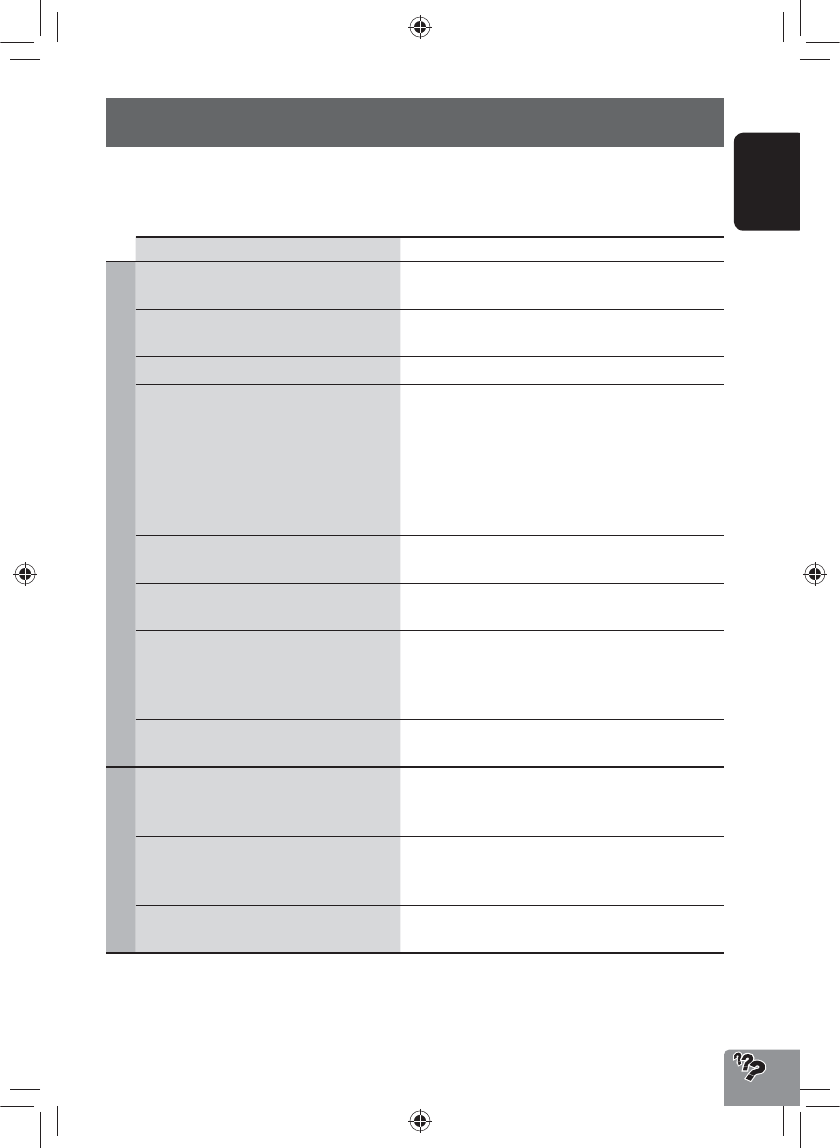
89
ENGLISH
Troubleshooting/error messages
What appears to be trouble is not always serious. Check the following points before calling a service center.
• For operations with the external components, refer also to the instructions supplied with the adapters used for the
connections (as well as the instructions supplied with the external components).
Symptoms Remedies/Causes
General
No sound comes out of the speakers. • Adjust the volume to the optimum level.
• Check the cords and connections.
The screen is not clear and legible. Sunshine from the windshield may cause this symptom.
Adjust the picture. (☞ page 72)
The unit does not work at all. Detach the monitor panel, then attach it. (☞ page 4)
The touch panel does not respond properly. • Keep your hands and the touch panel clean and dry.
• Eliminate static electricity and do not place magnetic
items near the unit.
• Leave the unit until the temperature becomes stable in
the car.
• A rubber mat on the floor may cause this symptom. In
this case, do not use the rubber mat.
Navigation guidance or AV source is hard to
listen to.
Surround noise interferes. Increase the <Adaptive
Volume> level. (☞ page 73)
<Adaptive Volume> setting has no effect
even though it is activated.
Reset the calibration data by selecting <Reset
Calibration Data>. (☞ page 39)
CD Text or Tag information of track or song,
etc. is not displayed correctly.
The text may not be displayed correctly depending on the
condition of recording or the type of the character, etc.
though 2-byte and 1-byte characters can be displayed on
the unit.
“System start up failed.” The System cannot start up. Detach the monitor panel,
then attach it. (☞ page 4)
Navigation
Guidance does not start. The System proceeds calibration. Wait until calibration is
completed. When calibration is completed, the guidance
starts.
You cannot operate some functions of an AV
source on the map screen.
On the map screen, you can operate some limited
functions of the current source only. Press AV MAP and
operate the source on the AV screen.
Route calculation seems to have stopped. Route calculation may take long depending on the route.
Wait for a while.
Continued on the next page
EN_KW-NT30_50[J].indb 89
EN_KW-NT30_50[J].indb 89
1/31/2011 3:24:42 PM
1/31/2011 3:24:42 PM
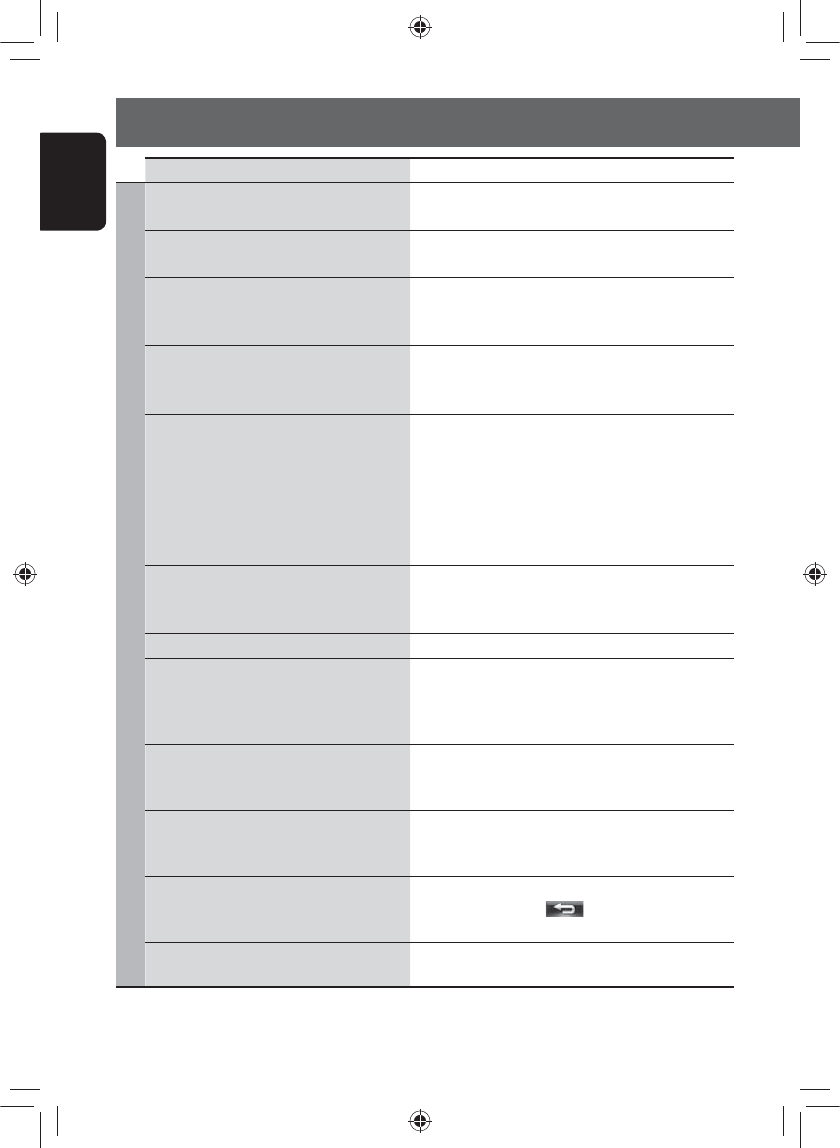
ENGLISH
90
Symptoms Remedies/Causes
Navigation
Navigation voice cannot be heard from the
speakers.
Guidance volume level is set to the minimum level. Adjust
it to the optimum level. (☞ page 40)
The voice guidance does not come out from the
speaker on the driver’s side.
Change the <Output> setting. (☞ page 40)
Navigation guidance is sometimes incorrect. Reversing signal/speed signal leads are not connected.
Connect them correctly (☞Installation/Connection
Manual).
A POI found using <POI Name> in the
<Destination Menu> is not within the
selected city.
This is not a malfunction. The System may also search
areas around the selected city/state.
The current position displayed on the map
remains wrong for more than 30 minutes.
Check the connection of the following leads.
– GPS antenna
– Speed signal lead
If any disconnection is found, connect the lead again.
• If no problems are found with connections, reset the
calibration data by selecting <Reset Calibration
Data>. (☞ page 39)
The distance and estimated time in the
guidance are inaccurate after replacing/
rotating the tires.
Perform <Reset Calibration Data> to clear the
accumulated calibration data. (☞ page 39)
“Check GPS Antenna” Check the connection of the GPS antenna.
“Acquiring GPS Signal” • Acquiring GPS signals. Wait until signal reception is
completed.
• GPS signals cannot be received. Move to the place where
the System receives the GPS signals.
“Route calculation failed.” Failed to calculate the route. The destination/via point is
too far from any road. Select another destination/via point
where is close to a road.
“Route calculation is aborted because
destination is too far.”
The destination/via point is too far from the current
position. Select another destination/via point where is
nearer to the current position.
“Specified destination is not found.” Valid information is not found in the database. Search
for another place. Press [ ] and search again with
different conditions (such as different category or place).
“Speed pulse not detected. System works as
GPS only mode until speed pulse is detected.”
Check the connection of the speed signal lead.
Troubleshooting/error messages
EN_KW-NT30_50[J].indb 90
EN_KW-NT30_50[J].indb 90
1/31/2011 3:24:42 PM
1/31/2011 3:24:42 PM
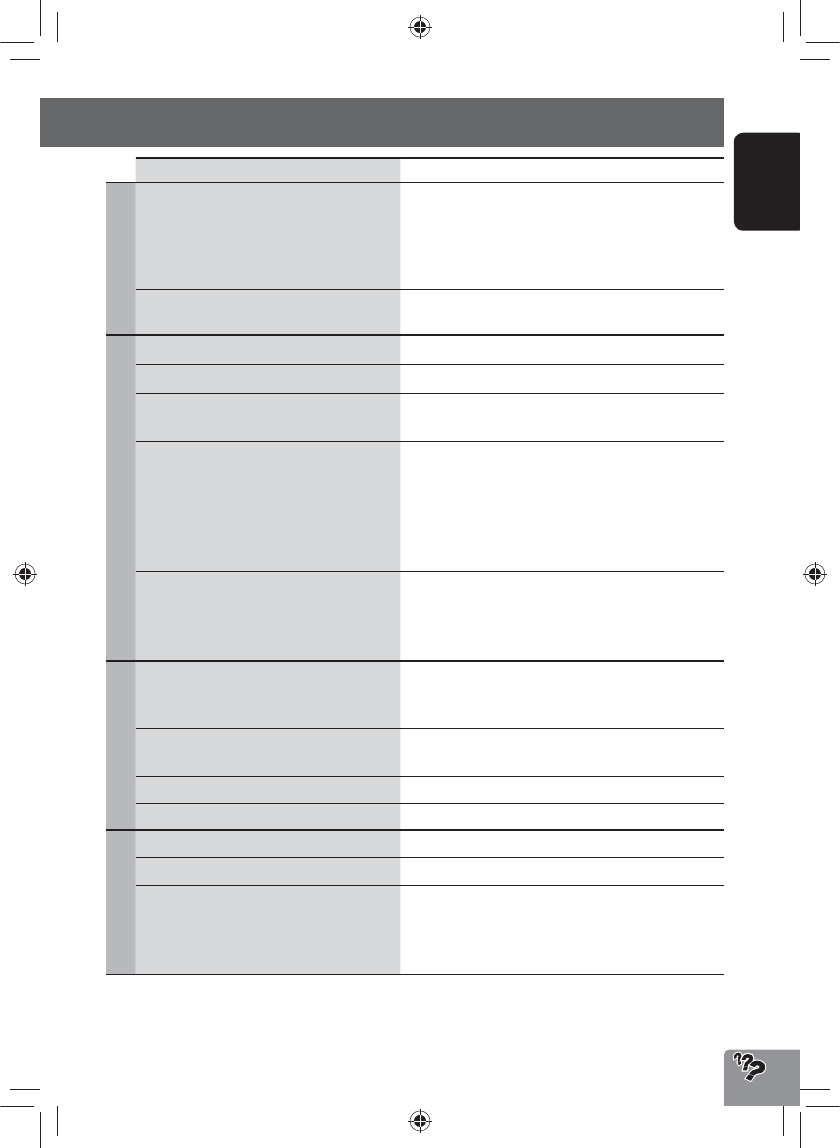
91
ENGLISH
Symptoms Remedies/Causes
Navigation
“There is no available traffic information now.” No valid traffic information is available now. Try one of the
followings:
• Move to the place where you can receive traffic service.
• No traffic information on your route. Display the list of all
traffic information. (☞ page 36)
“Selected coordinates are out of map area.
Please input again.”
The coordinates you have entered are not available. Press
[OK] and input the coordinates again.
HD Radio reception
SSM automatic presetting does not work. Store stations manually. (☞ page 47)
Static noise while listening to the radio. Connect the antenna firmly.
Sound quality changes when receiving HD
Radio stations.
Fix the reception mode either to <Digital> or
<Analog>. (☞ page 46)
No sound can be heard. • <Analog> is selected when receiving all digital
broadcast of HD Radio station. Select <Digital> or
<Auto>. (☞ page 46)
• <Digital> is selected when receiving weak digital
signals or receiving conventional radio broadcast. Select
<Analog> or <Auto>. (☞ page 46)
The song cannot be tagged. The HD Radio broadcast does not support iTunes Tagging
function or the broadcast does not contain PSD. You can
tag the PSD only when the TAG indicator lights up on the
screen.
iTunes Tagging
“Memory Full. Connect iPod.” You are trying to store the 101st PSD in the unit. Transfer
the tagged PSDs to iPod/iPhone or delete all tagged PSDs
from the unit.
“iPod not support tagging.” The connected iPod/iPhone is not compatible with iTunes
Tagging. (☞ page 48)
“Tags transfer failed.” The iPod/iPhone is disconnected during data transfer.
“iPod full. Tags can not be stored.” The memory of the iPod/iPhone is full.
Disc in general
Disc can be neither recognized nor played back. Eject the disc forcibly. (☞ page 4)
Disc cannot be ejected. Unlock the disc. (☞ page 50)
• Recordable/Rewritable discs cannot be
played back.
• Tracks on the Recordable/Rewritable discs
cannot be skipped.
• Insert a finalized disc.
• Finalize the discs with the component which you used
for recording.
Troubleshooting/error messages
Continued on the next page
EN_KW-NT30_50[J].indb 91
EN_KW-NT30_50[J].indb 91
1/31/2011 3:24:43 PM
1/31/2011 3:24:43 PM

ENGLISH
92
Symptoms Remedies/Causes
Disc in general
Playback does not start. • Insert the disc correctly again.
• The format of files is not supported by the unit.
Sound and pictures are sometimes interrupted
or distorted.
• Stop playback while driving on rough roads.
• Change the disc.
No playback picture is shown and caution
message about parking brake appears on
the screen, even when the parking brake is
engaged.
Parking brake lead is not connected properly.
(☞ Installation/Connection Manual)
No picture appears on the external monitor. • Connect the video cord correctly.
• Select the correct input on the external monitor.
“Read error” • A disc is inserted upside down. Replace the disc.
• A disc has no playable files.
“No Disc“ Disc is not inserted. Insert a disc or select another playback
source.
• “Eject Error”
• “Loading Error”
• Eject the disc forcibly. (☞ page 4)
• Check the disc.
“Region code error” Region code is not correct. (☞ page 51)
MP3/WMA/WAV
Disc cannot be played back. • Change the disc.
• Record the tracks using a compliant application on the
appropriate discs. (☞ page 51)
• Add appropriate extension codes to the file names.
Noise is generated. The track played back is not a playable file format. Skip to
another file.
Tracks are not played back as you have
intended them to play.
Playback order may differ from the one played back using
other players.
Elapsed playing time is not correct. This sometimes occurs during playback. This is caused by
how the tracks are recorded.
“Error” The track is unplayable.
SD/USB
Noise is generated. The track played back is not a playable file format. Skip to
another file.
Tracks cannot play back as you have intended
them to play.
Playback order may differ from the one played back using
other players.
Troubleshooting/error messages
EN_KW-NT30_50[J].indb 92
EN_KW-NT30_50[J].indb 92
1/31/2011 3:24:43 PM
1/31/2011 3:24:43 PM
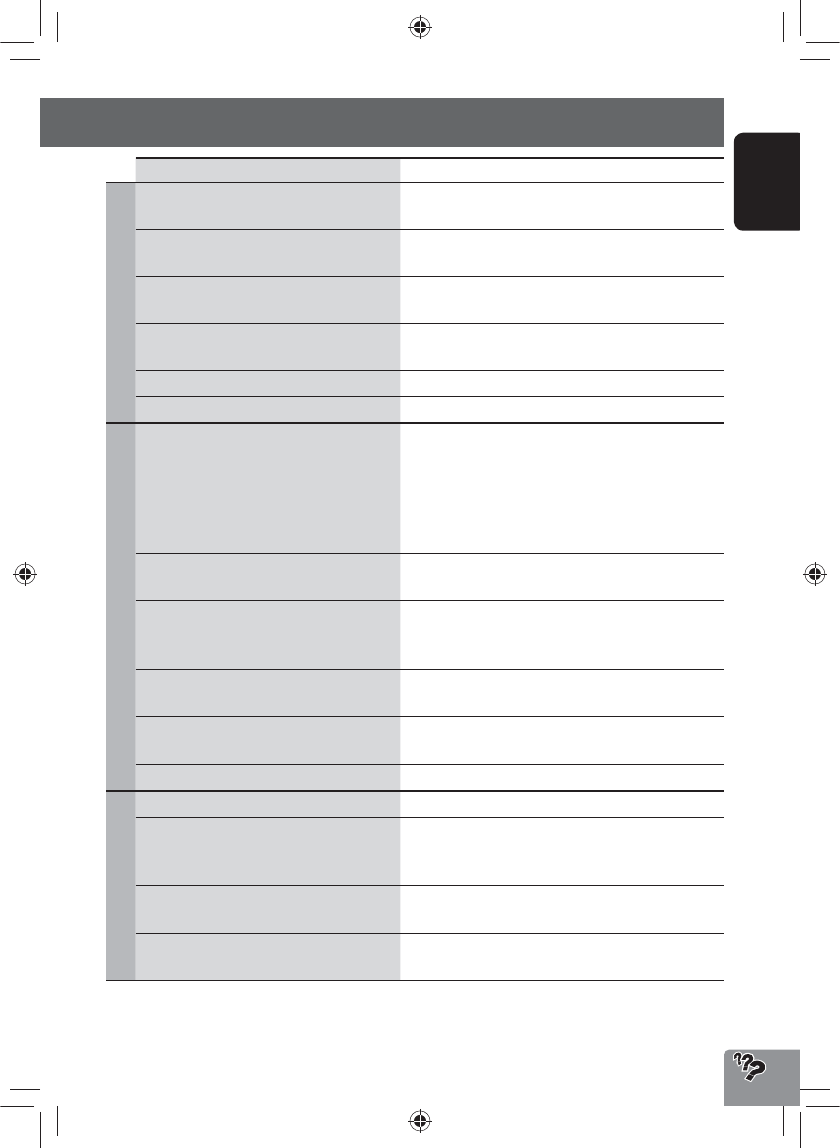
93
ENGLISH
Symptoms Remedies/Causes
SD/USB
While playing a track, sound is sometimes
interrupted.
The tracks are not properly copied into the SD card/USB
device. Copy tracks again, and try again.
“No Files” The SD card/USB device has no playable files. Change the
SD card/USB device.
“No SD Card” No SD card is inserted. Insert an SD card or select another
playback source.
“No USB Device” No USB device is connected. Connect a device or select
another playback source.
“Read error” The file has not been formatted correctly.
“Error” The track is unplayable.
iPod/iPhone
The iPod/iPhone does not turn on or does not
work.
• Check the connection.
• Charge the battery.
• Check whether <Head>, <iPod> or <Ext> is
correctly selected for <iPod Control Mode>. (☞
page 59)
• Reset the iPod/iPhone.
Sound is distorted. Deactivate the equalizer either on this unit or the
iPod/iPhone.
Playback pauses. The headphones are disconnected during playback with
<iPod Control Mode> set to <iPod> or <Ext> (☞
page 59). Restart playback.
No operations are available when playing back
a track containing artwork.
It takes a long time to loading an artwork. Operate the
unit after the artwork is loaded. (☞ page 60)
Video is not played back. Check the connection of USB Audio and Video cable (KS-
U29, not supplied).
“Disconnected” Check the connection.
Satellite radio
Satellite radio does not work at all. Reconnect the Satellite radio after a few seconds.
“CALL 1-888-539-SIRIUS TO SUBSCRIBE” SIRIUS Satellite Radio is connected but does not have an
active subscription. For information on how to subscribe,
(☞ page 66)
“Channel Not Authorized” Selected channel is unauthorized. Select another channel
or continue listening to the previous channel.
• ”Invalid Channel”
• ”Channel Not Available”
No broadcast on the selected channel. Select another
channel or continue listening to the previous channel.
Troubleshooting/error messages
Continued on the next page
EN_KW-NT30_50[J].indb 93
EN_KW-NT30_50[J].indb 93
1/31/2011 3:24:43 PM
1/31/2011 3:24:43 PM

ENGLISH
94
Troubleshooting/error messages
Symptoms Remedies/Causes
Satellite radio
“Channel Off Air”
Selected channel is not broadcasting at this time. Select
another channel or continue listening to the previous channel.
“Loading” The unit is loading the channel information and audio.
Text information are temporarily unavailable.
• “Acquiring Signal”
• “No Signal”
Make sure your Satellite Radio antenna is mounted
outside the vehicle. Move vehicle to an area with a clear
view of the sky.
“Check XM Tuner” The XM Mini tuner is not connected. Connect the tuner.
• “No Antenna”
• “Check Antenna”
Check your satellite radio antenna connection and be sure
it is firmly attached.
“Reset 08” Reconnect this unit and the Satellite radio correctly, and
detach the monitor panel then attach it.
AV-IN/Front Aux
“No Signal” • Turn on the external component if it is not on.
• Connect the external component correctly.
• Check whether <AV Input> setting is correct for “AV-
IN”. (☞ page 75)
Bluetooth
Bluetooth device does not detect the unit. This unit can be connected with one Bluetooth device at
a time.
While connected to a device, this unit cannot be detected
from another device. Disconnect currently connected
device and search again.
The unit does not detect the Bluetooth device. Check the Bluetooth setting of the device.
Echo or noise occurs. Adjust the microphone unit position.
Phone sound quality is poor. • Reduce the distance between the unit and the
Bluetooth mobile phone.
• Move the car to place where you can get a better signal
reception.
The sound is interrupted or skipped while using
a Bluetooth audio player.
• Reduce the distance between the unit and the
Bluetooth audio player.
• Disconnect the device connected for Bluetooth phone.
• Turn off, then turn on the unit.
• (When the sound is not yet restored) connect the player
again.
The connected audio player cannot be
controlled.
Check whether the connected audio player supports
AVRCP (Audio Video Remote Control Profile).
The unit does not response when you tried to
copy the phone book to the unit.
You may have tried to copy the same entries (as stored)
to the unit.
EN_KW-NT30_50[J].indb 94
EN_KW-NT30_50[J].indb 94
1/31/2011 3:24:43 PM
1/31/2011 3:24:43 PM
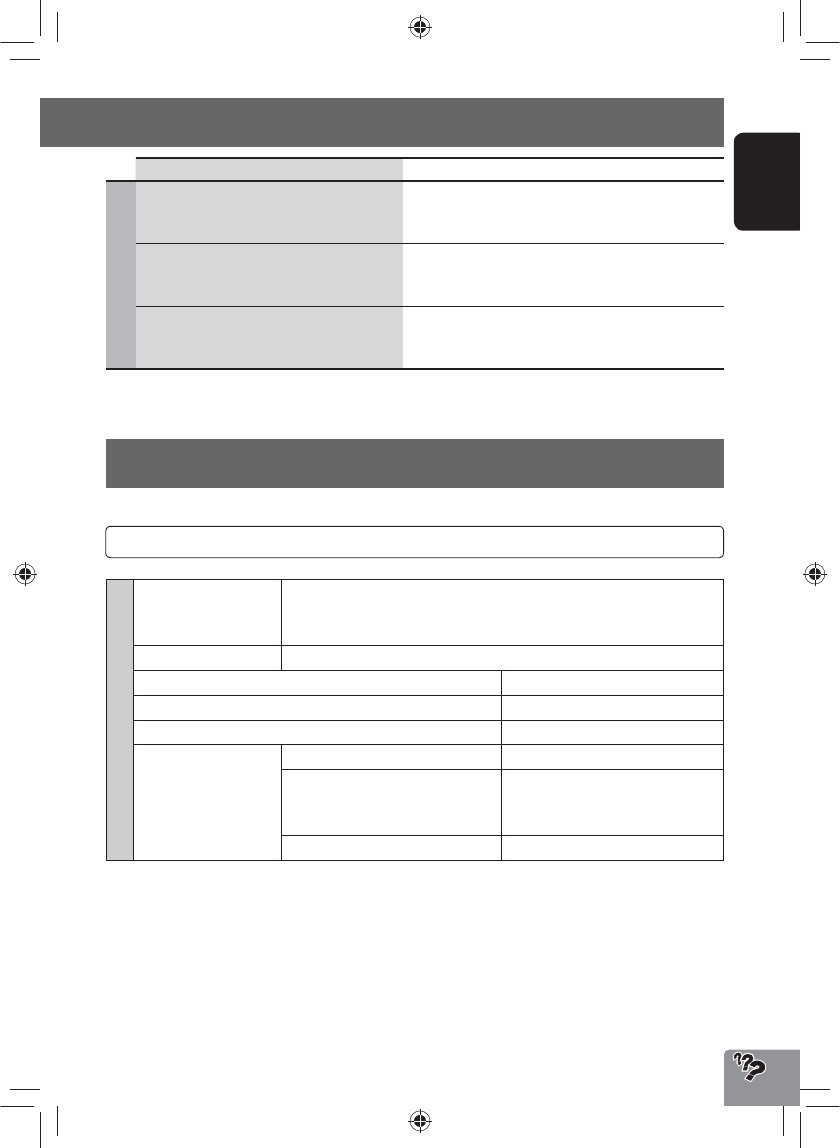
95
ENGLISH
Specifications
Design and specifications are subject to change without notice.
NAVIGATION SYSTEM
System & Service L1, C/A code
Global Positioning System
Standard Positioning Service
Reception System 12-channel multi-channel reception system
Reception Frequency 1 575.42 MHz
Sensitivity –130 dBm
Update Rate 1/second, continuous
GPS Antenna Polarization Right Handed Circular Polarization
Dimensions (approx.) (W × H × D) 30.4 mm × 11.7 mm × 35.5 mm
(1-1/4 inches × 1/2 inch × 1-
7/16 inches)
Cable (approx.) 5.0 m (16.4 feet)
Troubleshooting/error messages
Symptoms Remedies/Causes
Rear view camera
The rear view screen is not displayed when the
gear is shifted to the reverse (R) position.
• Check <Camera Input> setting. (☞ page 87)
• Check the connection.
The rear view screen is displayed when the gear
is not in the reverse (R) position.
Check <Reverse Signal Polarity> setting. (☞ page 75)
“No Signal” Check the connection.
If a kit is necessary for your car, consult your telephone directory for the nearest car audio speciality shop.
EN_KW-NT30_50[J].indb 95
EN_KW-NT30_50[J].indb 95
1/31/2011 3:24:43 PM
1/31/2011 3:24:43 PM
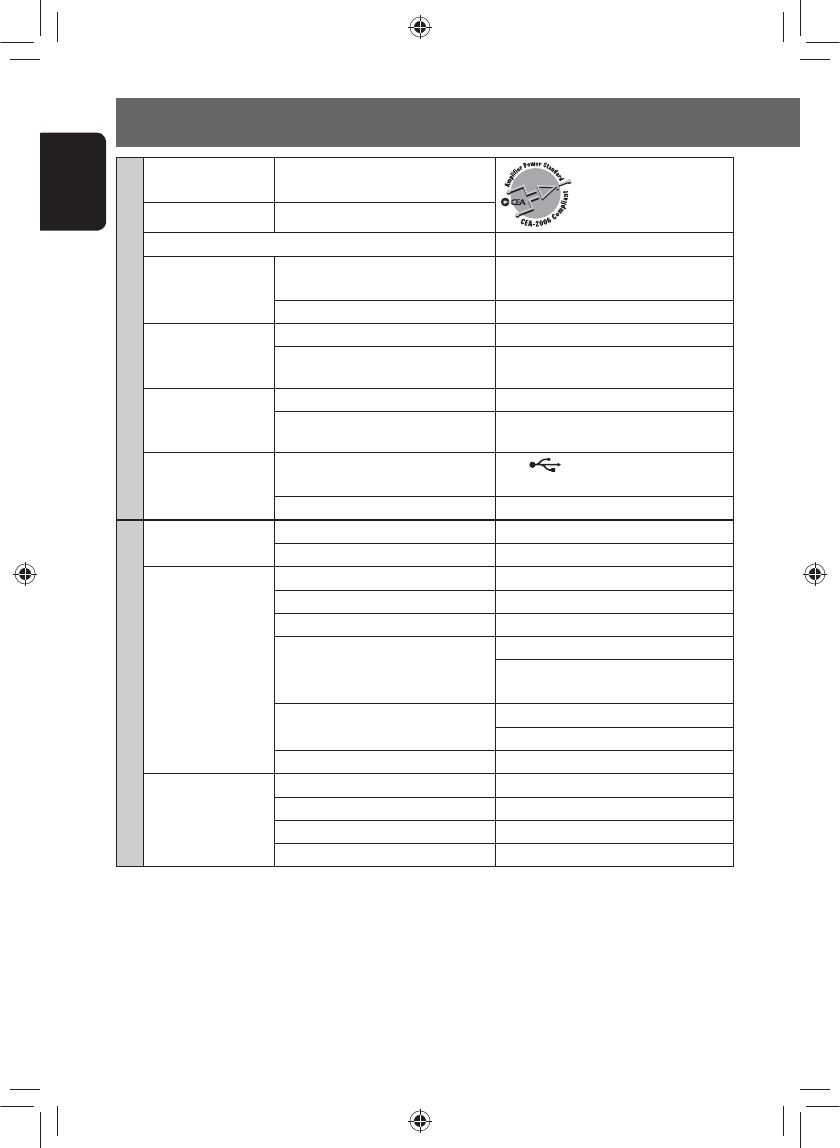
ENGLISH
96
AMPLIFIER
Power Output 20 W RMS × 4 Channels at 4 Ω and
≤ 1% THD+N
Signal-to-Noise Ratio 80 dBA (reference: 1 W into 4 Ω)
Load Impedance 4 (4 to 8 allowance)
Equalizer Control
Range
Frequencies 45 Hz, 120 Hz, 315 Hz, 800 Hz, 2.4 kHz
6.3 kHz, 15 kHz
Level ±10 dB
Audio Output Level
LINE OUT (F OUT/R
OUT), SUBWOOFER
Line-Out Level/Impedance 2.5 V/20 kΩ load (full scale)
Output Impedance 1 kΩ
Video Output
(composite)
VIDEO OUT
Color System NTSC/PAL
Video-Out Level/Impedance 1 Vp-p/75 Ω
Other Terminals Input USB ( ), Front AUX, LINE IN, VIDEO IN,
CAMERA IN, Antenna input, MIC IN
Others OE REMOTE, Satellite unit connector
FM/AM TUNER (HD Radio System Compatible)
Frequency Range FM 87.5 MHz to 107.9 MHz
AM 530 kHz to 1 710 kHz
FM Tuner Usable Sensitivity: 8.3 dBf (0.7 μV/75 Ω)
50 dB Quieting Sensitivity: 14.3 dBf (1.4 μV/75 Ω)
Alternate Channel Selectivity (400 kHz): 65 dB
Frequency Response: 20 Hz to 20 000 Hz (HD Radio broadcast)
40 Hz to 15 000 Hz (Conventional
broadcast)
Stereo Separation: 70 dB (HD Radio broadcast)
50 dB (Conventional broadcast)
Capture Ratio 3.5 dB
AM Tuner Sensitivity: 13 μV
Selectivity: 80 dB
Frequency Response: 40 Hz to 15 000 Hz (HD Radio broadcast)
Stereo Separation: 70 dB (HD Radio broadcast)
Specifications
EN_KW-NT30_50[J].indb 96
EN_KW-NT30_50[J].indb 96
1/31/2011 3:24:43 PM
1/31/2011 3:24:43 PM
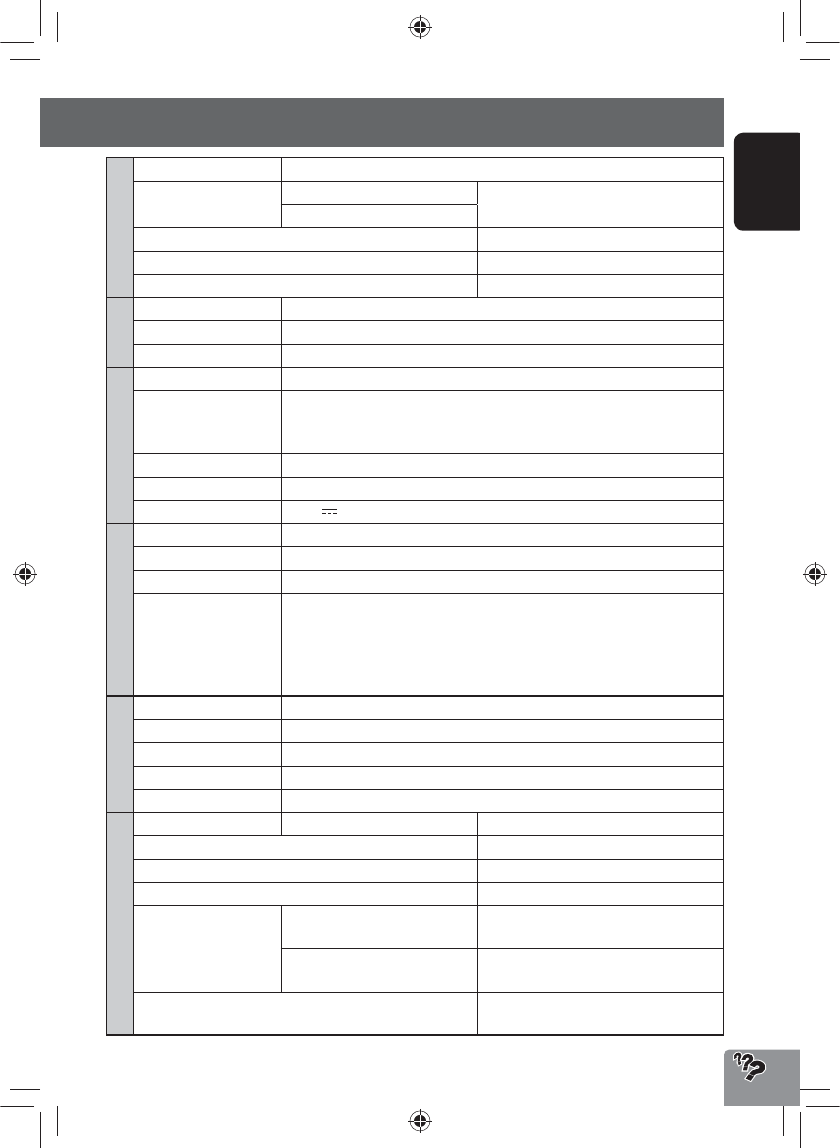
97
ENGLISH
DVD/CD
Signal Detection System Non-contact optical pickup (semiconductor laser)
Frequency Response DVD, fs=48 kHz/96 kHz 16 Hz to 20 000 Hz
CD
Dynamic Range 93 dB
Signal-to-Noise Ratio 95 dB
Wow and Flutter Less than measurable limit
SD
Compatible File System FAT 32/16/12
Capacity 8 Mbytes to 2 Gbytes
Data Transfer Rate Maximum 10 Mbps
USB
USB Standards USB 2.0 High Speed
Data Transfer Rate High Speed: Maximum 480 Mbps
Full Speed: Maximum 12 Mbps
Low Speed: Maximum 1.5 Mbps
Compatible Device Mass storage class
Compatible File System FAT 32/16/12
Max. Current DC 5 V 1 A
BLUETOOTH
Version Bluetooth 2.0 certified
Output Power +4 dBm Max. (Power class 2)
Service Area Within 10 m (10.9 yd)
Profile HFP (Hands-Free Profile) 1.5
OPP (Object Push Profile) 1.1
PBAP (Phonebook Access Profile) 1.0
A2DP (Advanced Audio Distribution Profile) 1.2
AVRCP (Audio/Video Remote Control Profile) 1.3
MONITOR
Screen Size 6.1 inch wide liquid crystal display
Number of Pixel 336 960 pixels: 480 × 3 (horizontal) × 234 (vertical)
Drive Method TFT (Thin Film Transistor) active matrix format
Color System NTSC/PAL
Aspect Ratio 16:9 (wide)
GENERAL
Power Requirement Operating Voltage DC 14.4 V (11 V to 16 V allowance)
Grounding System Negative ground
Allowable Storage Temperature –10°C to +60°C (14°F to 140°F)
Allowable Operating Temperature 0°C to +40°C (32°F to 104°F)
Dimensions (W × H × D)
• With trim plate and
sleeve attached
Installation Size (approx.) 182 mm × 111 mm × 161 mm
(7-3/16” × 4-3/8” × 6-3/8”)
Panel Size (approx.) 188 mm × 117 mm × 10 mm
(7-7/16” × 4-5/8” × 7/16”)
Mass (approx.) 2.9 kg (6.4 lbs) (including trims/sleeve/
brackets)
Specifications
EN_KW-NT30_50[J].indb 97
EN_KW-NT30_50[J].indb 97
1/31/2011 3:24:43 PM
1/31/2011 3:24:43 PM

ENGLISH
98
END-USER LICENSE AGREEMENT
END-USER TERMS
The Map Data Disc (“Data”) is provided for your personal, internal use only and not for
resale. It is protected by copyright, and is subject to the following terms (this “End-User
License Agreement”) and conditions which are agreed to by you, on the one hand,
and NAVTEQ North America, LLC (“NT”) and its licensors (including their licensors and
suppliers) on the other hand.
The Data for areas of Canada includes information taken with permission from Canadian
authorities, including: © Her Majesty the Queen in Right of Canada, © Queen’s Printer
for Ontario, © Canada Post Corporation, GeoBase ®.
NT holds a non-exclusive license from the United States Postal Service ® to publish and
sell ZIP+4 ® information.
© United States Postal Service ® 2010. Prices are not established, controlled or
approved by the United States Postal Service ®. The following trademarks and
registrations are owned by the USPS: United States Postal Service, USPS, and ZIP+4.
TERMS AND CONDITIONS
Personal Use Only. You agree to use this Data for the solely personal, non-commercial
purposes for which you were licensed, and not for service bureau, time-sharing or
other similar purposes. Accordingly, but subject to the restrictions set forth in the
following paragraphs of this End-User License Agreement, you may copy this Data
only as necessary for your personal use to (i) view it, and (ii) save it, provided that you
do not remove any copyright notices that appear and do not modify the Data in any
way. Except as otherwise set forth herein, you agree not to otherwise reproduce, copy,
modify, decompile, disassemble or reverse engineer any portion of this Data, and may
not transfer or distribute it in any form, for any purpose, except to the extent permitted
by mandatory laws. You may transfer the Data and all accompanying materials on a
permanent basis if you retain no copies and the recipient agrees to the terms of this End-
User License Agreement. Multi-disc sets may only be transferred or sold as a complete
set as provided to you and not as a subset thereof.
Restrictions. Except where you have been specifically licensed to do so by NT
and without limiting the preceding paragraph, you may not (a) use this Data with
any products, systems, or applications installed or otherwise connected to or in
communication with vehicles capable of vehicle navigation, positioning, dispatch,
real time route guidance, fleet management or similar applications; or (b) with or in
communication with, including without limitation, cellular phones, palmtop and handheld
computers, pagers, and personal digital-assistants or PDAs.
Warning. This Data may contain inaccurate or incomplete information due to the
passage of time, changing circumstances, sources used and the nature of collecting
comprehensive geographic data, any of which may lead to incorrect results.
No Warranty. This Data is provided to you “as is,” and you agree to use it at your own
risk. NT and its licensors (and their licensors and suppliers) make no guarantees,
representations or warranties of any kind, express or implied, arising by law or otherwise,
including but not limited to, content, quality, accuracy, completeness, effectiveness,
reliability, fitness for a particular purpose, usefulness, use or results to be obtained from
this Data, or that the Data or server will be uninterrupted or error-free.
Disclaimer of Warranty: NT AND ITS LICENSORS (INCLUDING THEIR LICENSORS
AND SUPPLIERS) DISCLAIM ANY WARRANTIES, EXPRESS OR IMPLIED, OF QUALITY,
PERFORMANCE, MERCHANTABILITY, FITNESS FOR A PARTICULAR PURPOSE OR
NON-INFRINGEMENT. Some States, Territories and Countries do not allow certain
warranty exclusions, so to that extent the above exclusion may not apply to you.
EN_KW-NT30_50[J].indb 98
EN_KW-NT30_50[J].indb 98
1/31/2011 3:24:44 PM
1/31/2011 3:24:44 PM
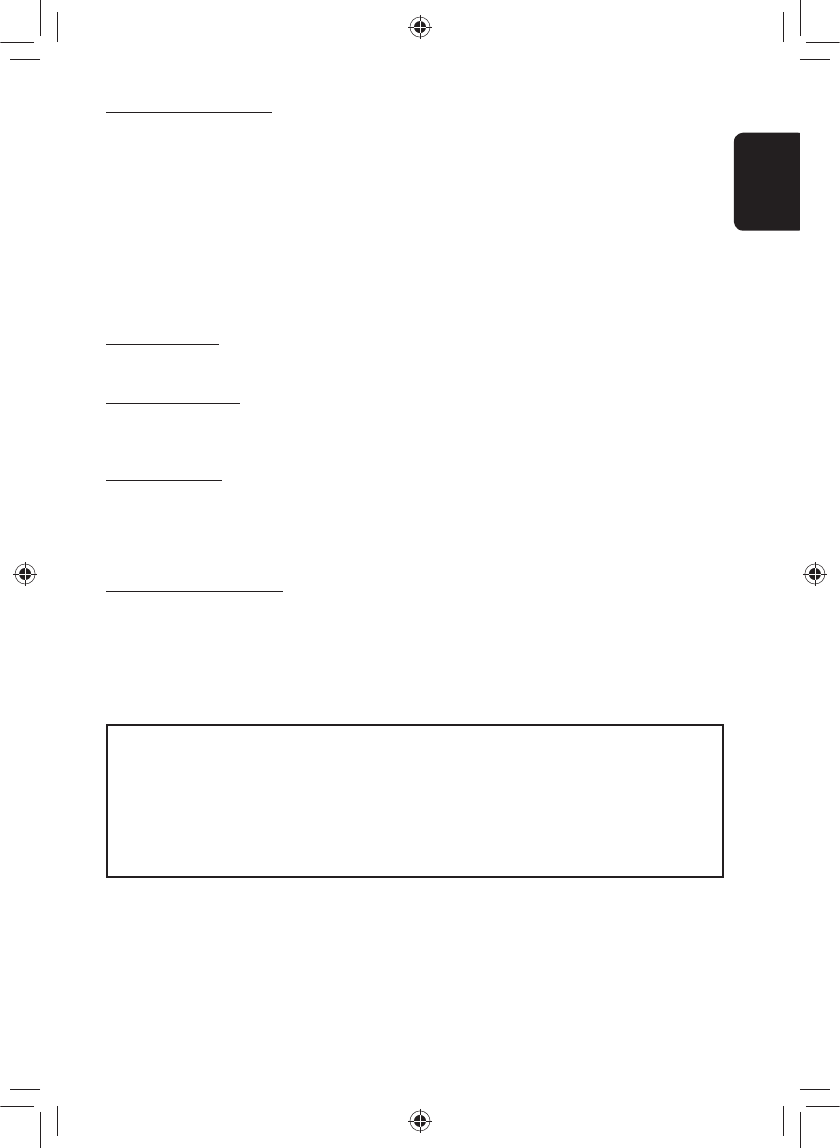
99
ENGLISH
Disclaimer of Liability: NT AND ITS LICENSORS (INCLUDING THEIR LICENSORS AND
SUPPLIERS) SHALL NOT BE LIABLE TO YOU IN RESPECT OF ANY CLAIM, DEMAND
OR ACTION, IRRESPECTIVE OF THE NATURE OF THE CAUSE OF THE CLAIM,
DEMAND OR ACTION ALLEGING ANY LOSS, INJURY OR DAMAGES, DIRECT OR
INDIRECT, WHICH MAY RESULT FROM THE USE OR POSSESSION OF THIS DATA; OR
FOR ANY LOSS OF PROFIT, REVENUE, CONTRACTS OR SAVINGS, OR ANY OTHER
DIRECT, INDIRECT, INCIDENTAL, SPECIAL OR CONSEQUENTIAL DAMAGES ARISING
OUT OF YOUR USE OF OR INABILITY TO USE THIS DATA, ANY DEFECT IN THIS DATA,
OR THE BREACH OF THESE TERMS OR CONDITIONS, WHETHER IN AN ACTION IN
CONTRACT OR TORT OR BASED ON A WARRANTY, EVEN IF NT OR ITS LICENSORS
HAVE BEEN ADVISED OF THE POSSIBILITY OF SUCH DAMAGES. Some States,
Territories and Countries do not allow certain liability exclusions or damages limitations,
so to that extent the above may not apply to you.
Export Control. You agree not to export from anywhere any part of the Data provided
to you or any direct product thereof except in compliance with, and with all licenses and
approvals required under, applicable export laws, rules and regulations.
Entire Agreement. These terms and conditions constitute the entire agreement between
NT (and its licensors, including their licensors and suppliers) and you pertaining to
the subject matter hereof, and supersedes in their entirety any and all written or oral
agreements previously existing between us with respect to such subject matter.
Governing Law. The above terms and conditions shall be governed by the laws of the
State of Illinois, without giving effect to (i) its conflict of laws provisions, or (ii) the United
Nations Convention for Contracts for the International Sale of Goods, which is explicitly
excluded. You agree to submit to the jurisdiction of the State of Illinois for any and all
disputes, claims and actions arising from or in connection with the Data provided to you
hereunder.
Government End Users. If the Data is being acquired by or on behalf of the United
States government or any other entity seeking or applying rights similar to those
customarily claimed by the United States government, this Data is a “commercial item”
as that term is defined at 48 C.F.R. (“FAR”) 2.101, is licensed in accordance with this
End-User License Agreement, and each copy of Data delivered or otherwise furnished
shall be marked and embedded as appropriate with the following “Notice of Use,” and
be treated in accordance with such Notice:
If the Contracting Officer, federal government agency, or any federal official refuses to
use the legend provided herein, the Contracting Officer, federal government agency, or
any federal official must notify NAVTEQ prior to seeking additional or alternative rights in
the Data.
© 2010 NAVTEQ. All Rights Reserved.
NOTICE OF USE
CONTRACTOR (MANUFACTURER/ SUPPLIER) NAME: NAVTEQ
CONTRACTOR (MANUFACTURER/SUPPLIER) ADDRESS:
425 West Randolph Street, Chicago, IL 60606.
This Data is a commercial item as defined in FAR 2.101 and is subject to the End-User
License Agreement under which this Data was provided.
© 2010 NAVTEQ. All rights reserved.
EN_KW-NT30_50[J].indb 99
EN_KW-NT30_50[J].indb 99
1/31/2011 3:24:44 PM
1/31/2011 3:24:44 PM
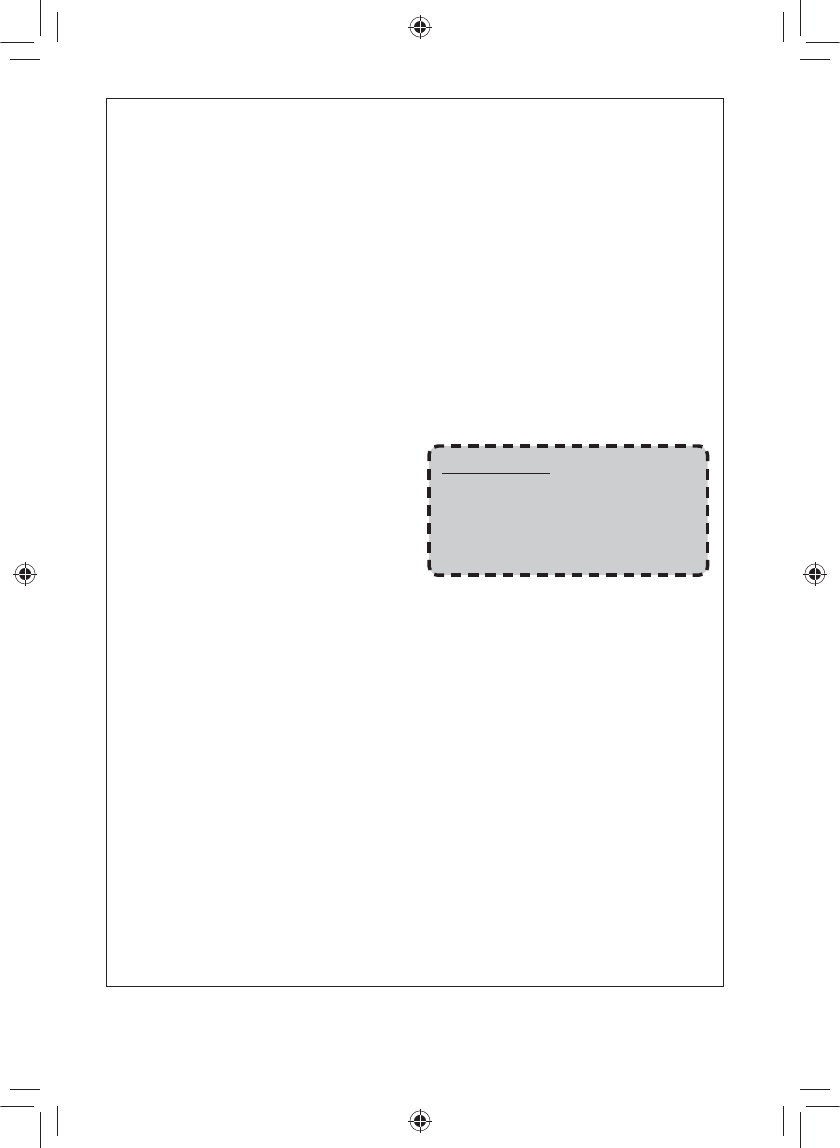
i
• Manufactured under license from Dolby Laboratories.
Dolby and the double-D symbol are trademarks of Dolby
Laboratories.
Fabricado bajo licencia de Dolby Laboratories. Dolby y el
símbolo de la doble D son marcas comerciales de Dolby
Laboratories.
Fabriqué sous licence de Dolby Laboratories. Le terme Dolby
et le sigle double D sont des marques commerciales de
Dolby Laboratories.
• “DVD Logo” is a trademark of DVD Format/Logo Licensing
Corporation registered in the US, Japan and other
countries.
“DVD Logo” es una marca comercial de DVD Format/Logo
Licensing Corporation registrado en los EE.UU., Japón y otros
países.
Le “DVD Logo” est une marque de commerce de DVD
Format/Logo Licensing Corporation, enregistrée aux États-
Unis, au Japon et dans d’autres pays.
• HD Radio Technology manufactured under license from
iBiquity Digital Corporation. U.S. and Foreign Patents.
HD Radio™ and the HD, HD Radio, and “Arc” logos are
proprietary trademarks of iBiquity Digital Corp.
• SIRIUS, XM and SAT Radio Ready, and related marks are
registered trademarks of SIRIUS XM Radio Inc. All rights
reserved.
• Microsoft and Windows Media are either registered
trademarks or trademarks of Microsoft Corporation in the
United States and/or other countries.
Microsoft y Windows Media son marcas registradas o bien
marcas comerciales de Microsoft Corporation en los Estados
Unidos y/u otros países.
Microsoft et Windows Media est une marque déposée ou
une marque de commerce de Microsoft Corporation aux
États-Unis et/ou dans les autres pays.
• The Bluetooth word mark and logos are owned by the
Bluetooth SIG, Inc. and any use of such marks by Victor
Company of Japan, Limited (JVC) is under license. Other
trademarks and trade names are those of their respective
owners.
La marca Bluetooth y sus logotipos son propiedad de Bluetooth
SIG, Inc., y cualquier uso de los mismos por Victor Company
of Japan, Limited (JVC) se realiza bajo licencia. Otras marcas y
nombres comerciales son de sus respectivos propietarios.
La marque du mot et les logos Bluetooth sont la propriété
de Bluetooth SIG, Inc. et toute utilisation de ces marques
par Victor Company of Japan, Limited (JVC) est faite sous
licence. Les autres marques et noms de commerce sont la
propriété de leur propriétaire respectif.
• “Made for iPod”, and “Made for iPhone” mean that
an electronic accessory has been designed to connect
specifically to iPod, or iPhone, respectively, and has been
certified by the developer to meet Apple performance
standards. Apple is not responsible for the operation of
this device or its compliance with safety and regulatory
standards. iPhone, iPod, iPod classic, iPod nano, iPod
touch, and iTunes are trademarks of Apple Inc., registered
in the U.S. and other countries.
• This product incorporates copyright protection technology
that is protected by U.S. patents and other intellectual
property rights. Use of this copyright protection
technology must be authorized by Rovi Corporation, and
is intended for home and other limited viewing uses only
unless otherwise authorized by Rovi Corporation. Reverse
engineering or disassembly is prohibited.
• Google Maps™ is a trademark of Google Inc.
• SDHC Logo is a trademark of SD-3C, LLC.
Only for KW-NT50HDT:
• HD Total Traffic Network® + is a registered mark
of Clear Channel in the United States and other
countries and hereby used under license.
• Journaline® technology licensed by Fraunhofer IIS.
http://www.journaline.info
description_from_p3.indd i
description_from_p3.indd i
1/28/2011 3:12:54 PM
1/28/2011 3:12:54 PM
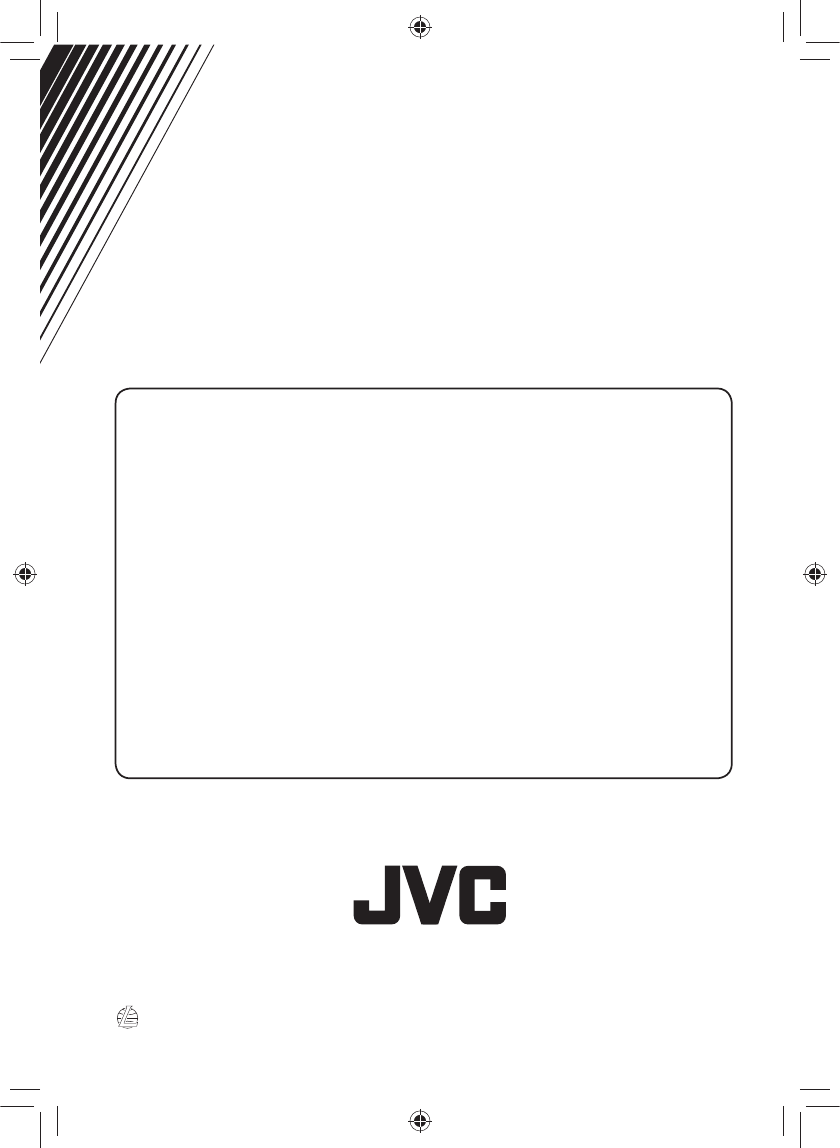
EN, SP, FR
0211NSMCREJEIN
© 2011 Victor Company of Japan, Limited
Having TROUBLE with operation?
Please detach the monitor panel,
then attach it
Still having trouble??
USA ONLY
Call 1-800-252-5722
http://www.jvc.com
We can help you!
Cover4_KW-NT30_50[JC]_001A.indd 2
Cover4_KW-NT30_50[JC]_001A.indd 2
1/20/2011 4:53:15 PM
1/20/2011 4:53:15 PM